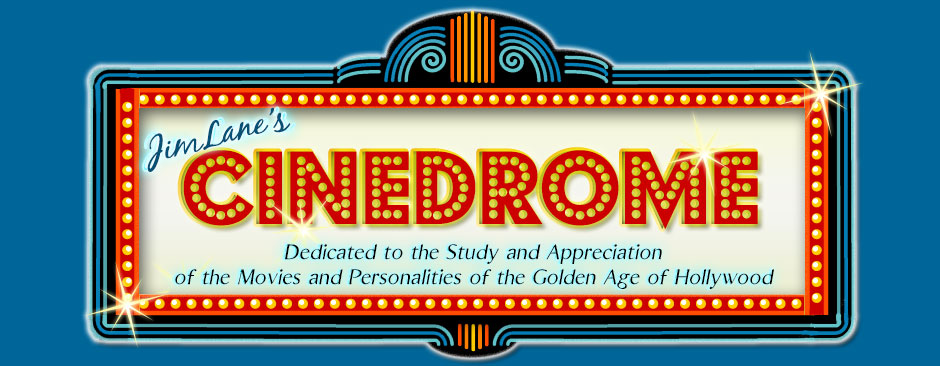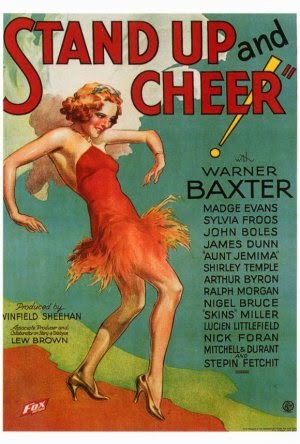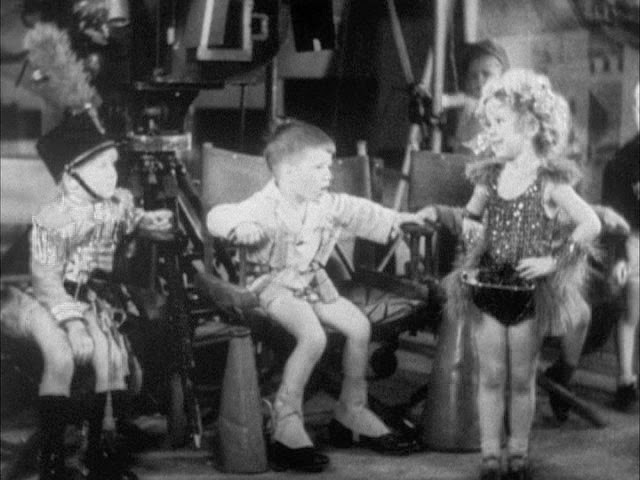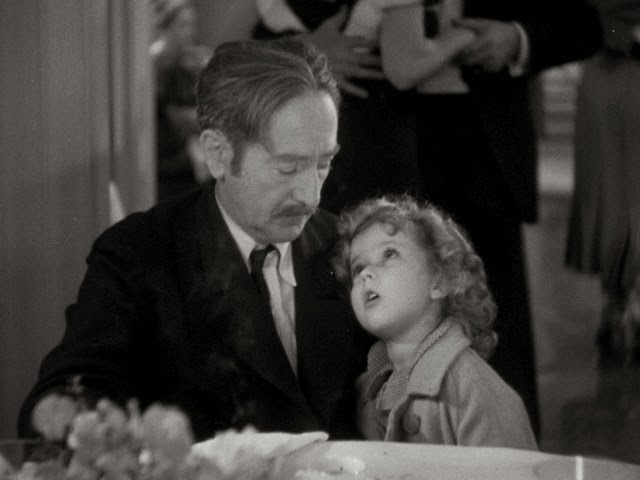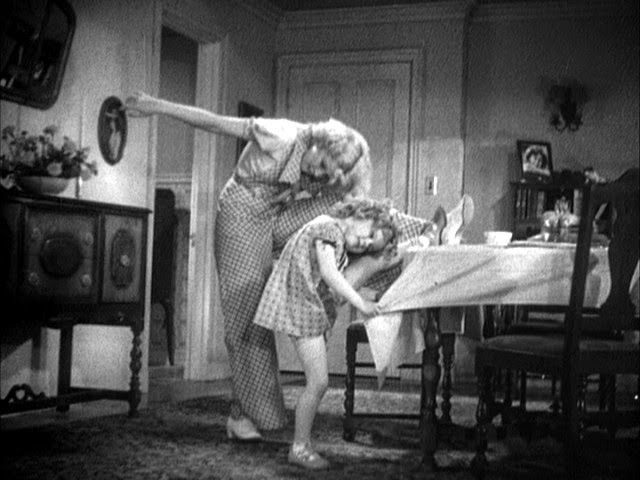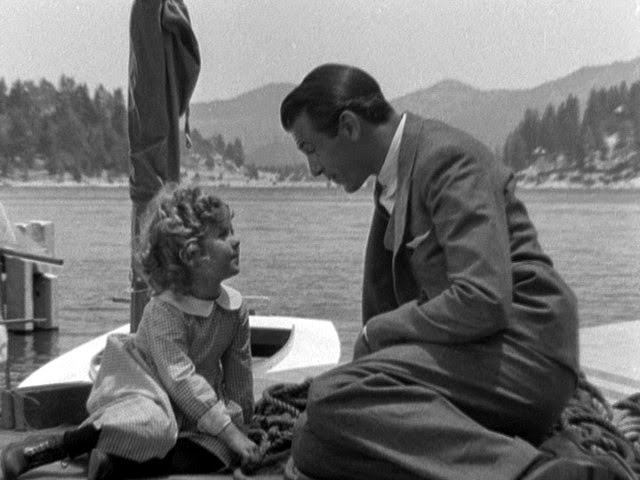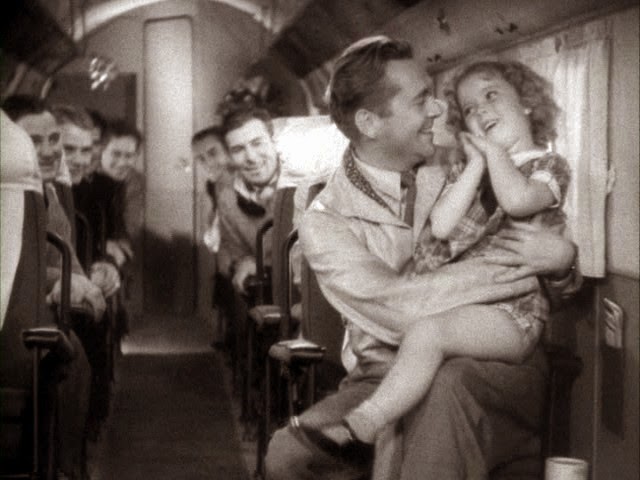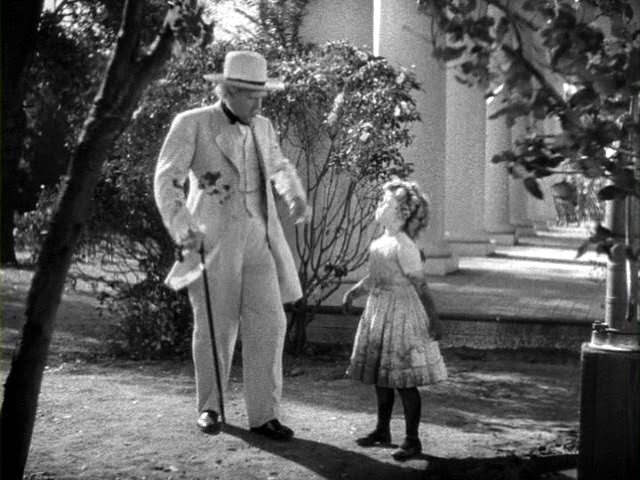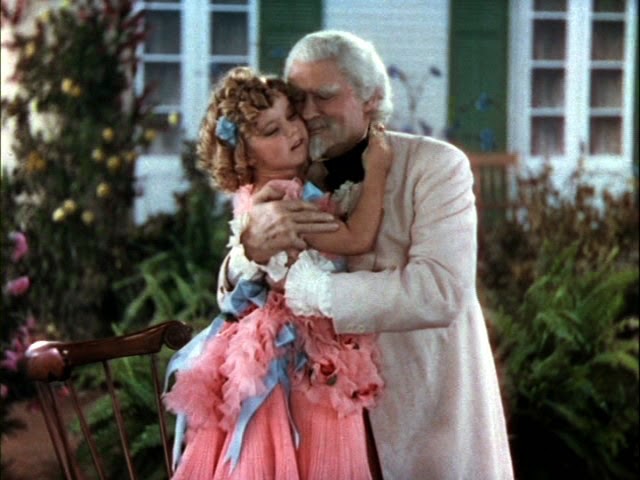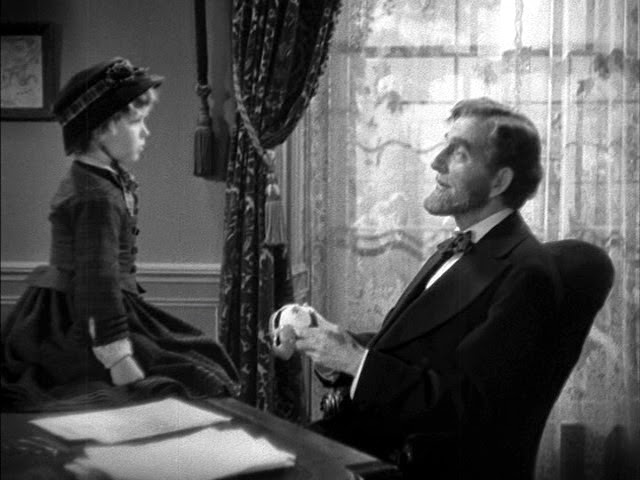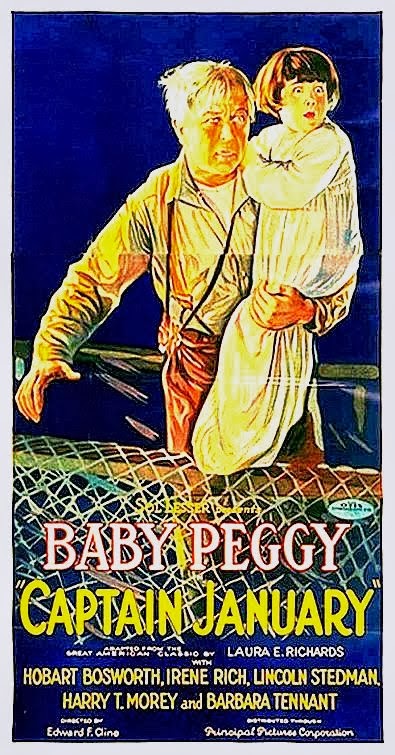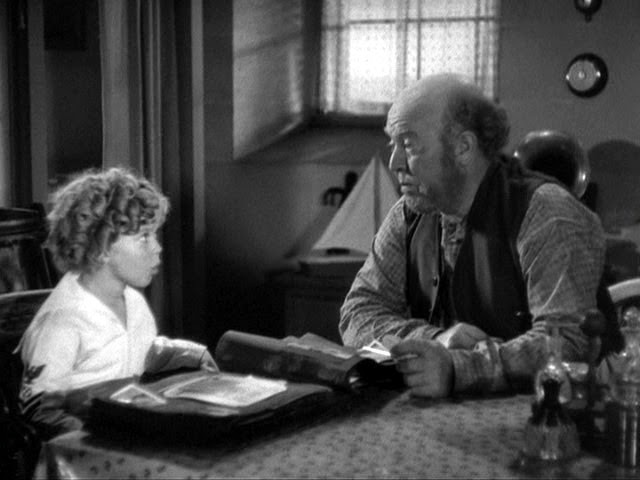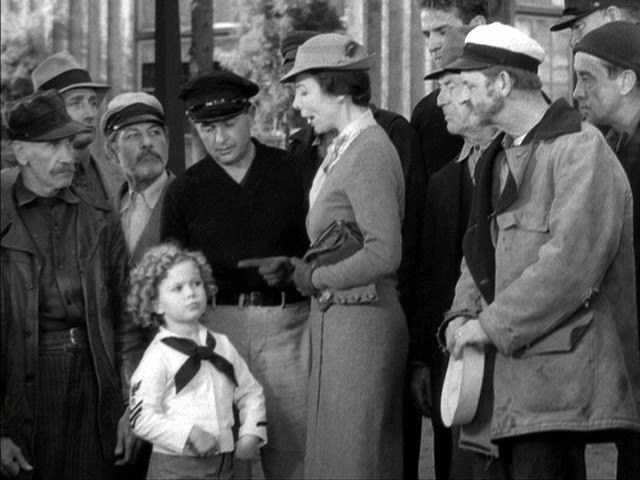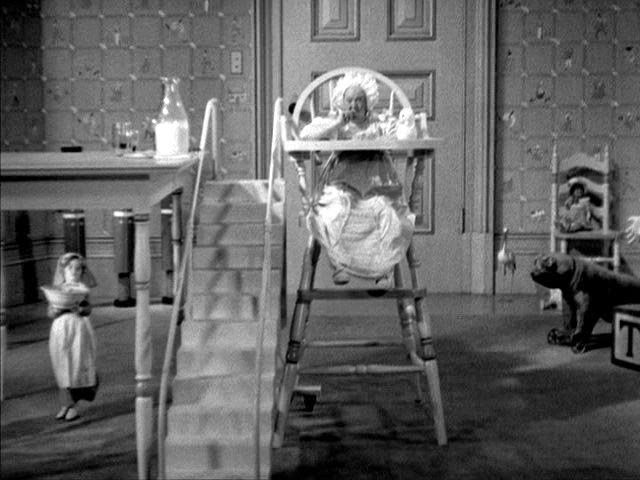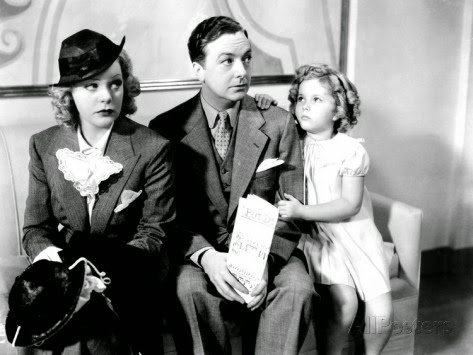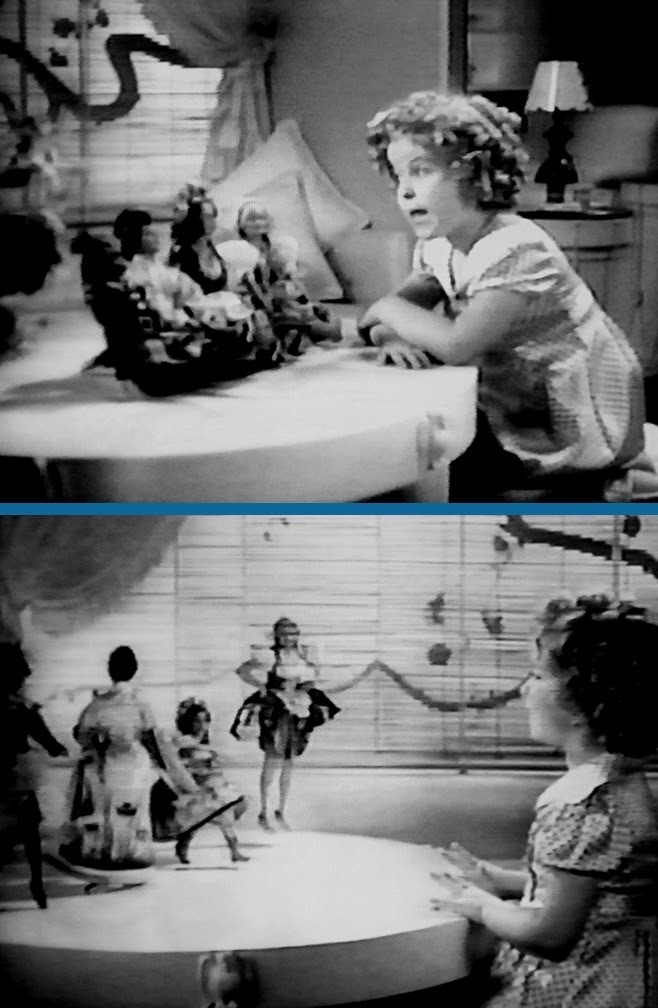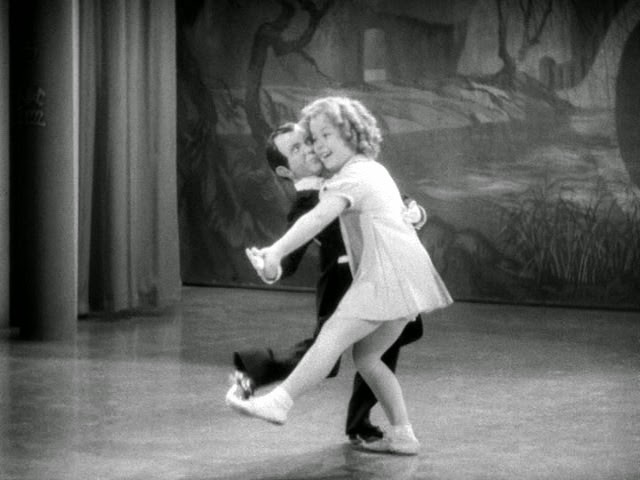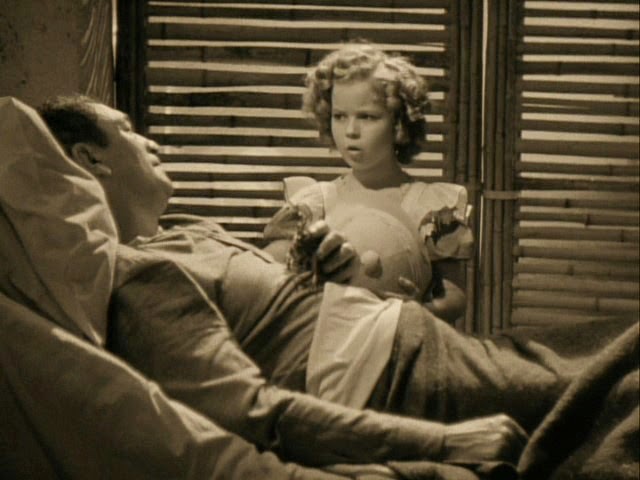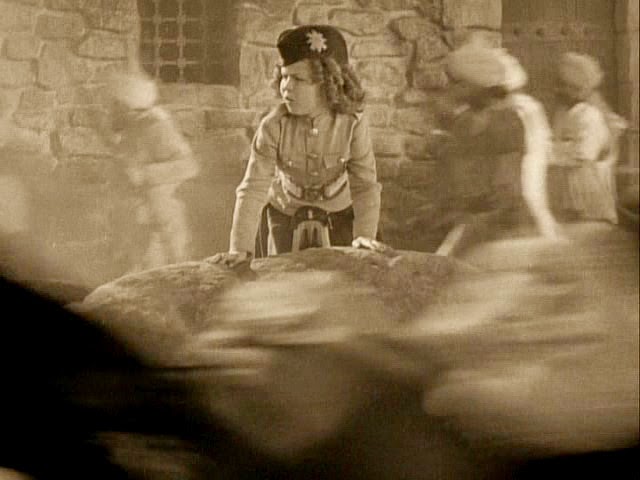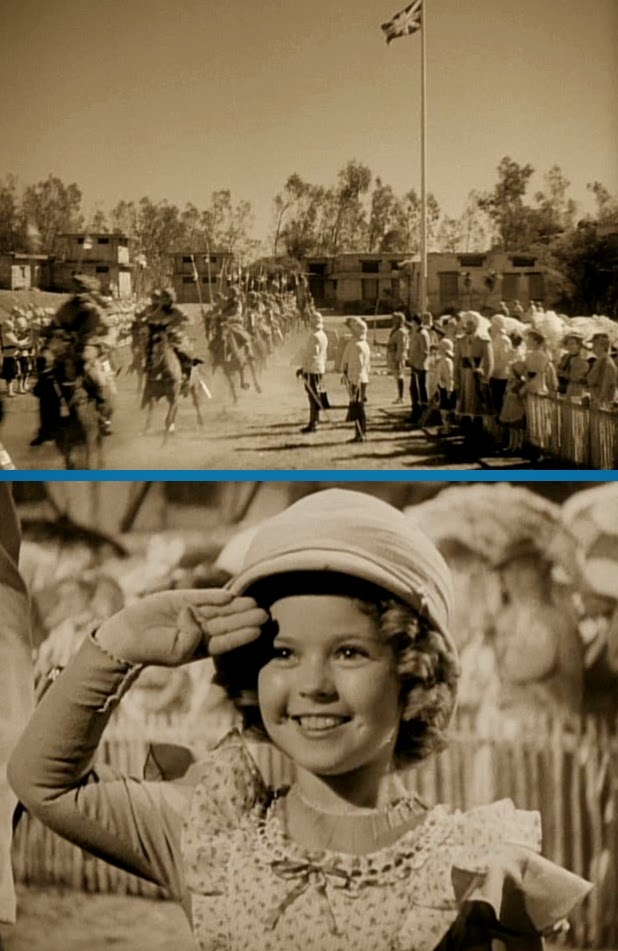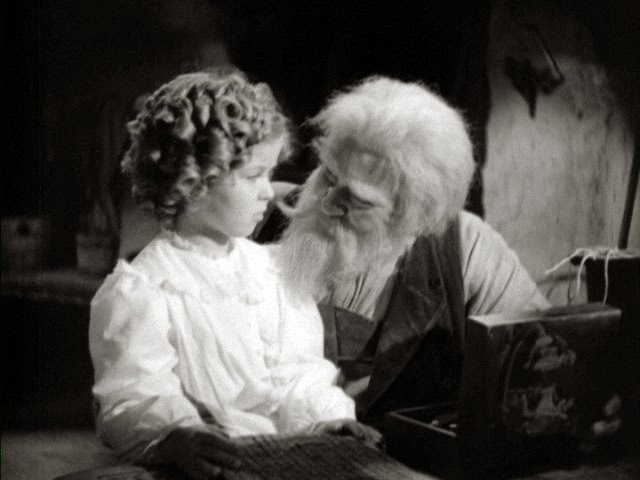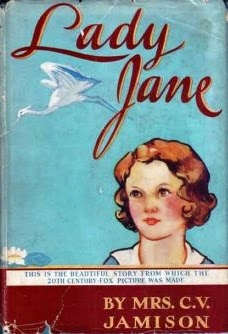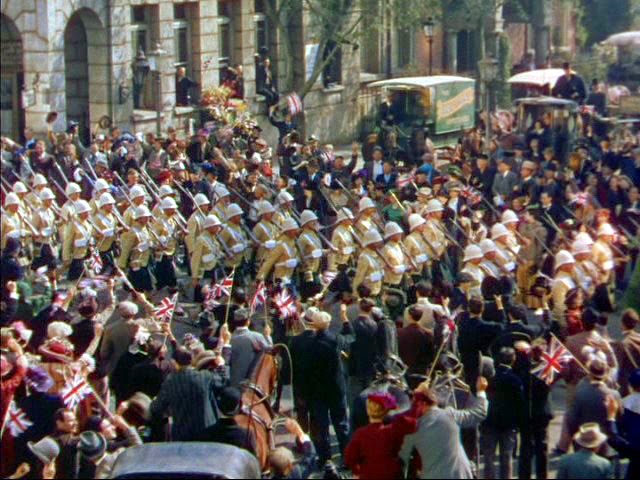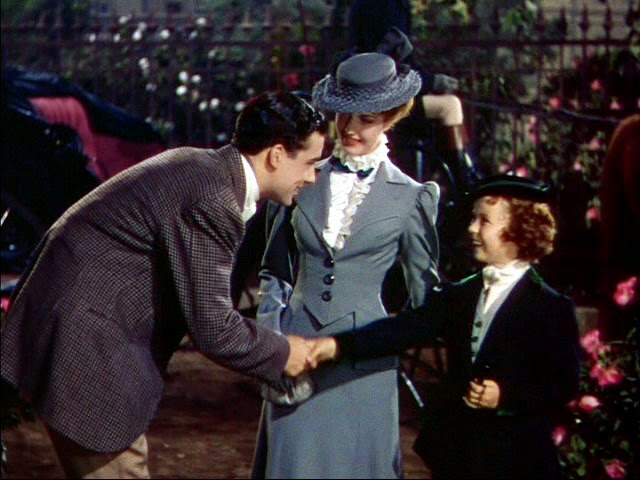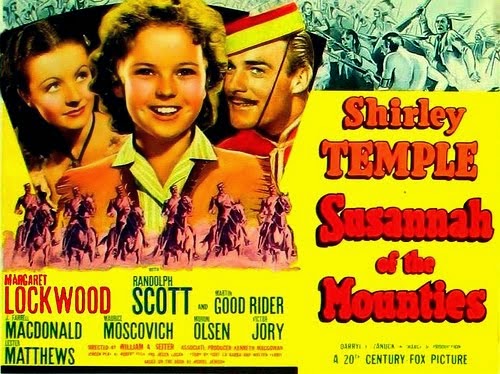Bright Eyes, 1928-2014
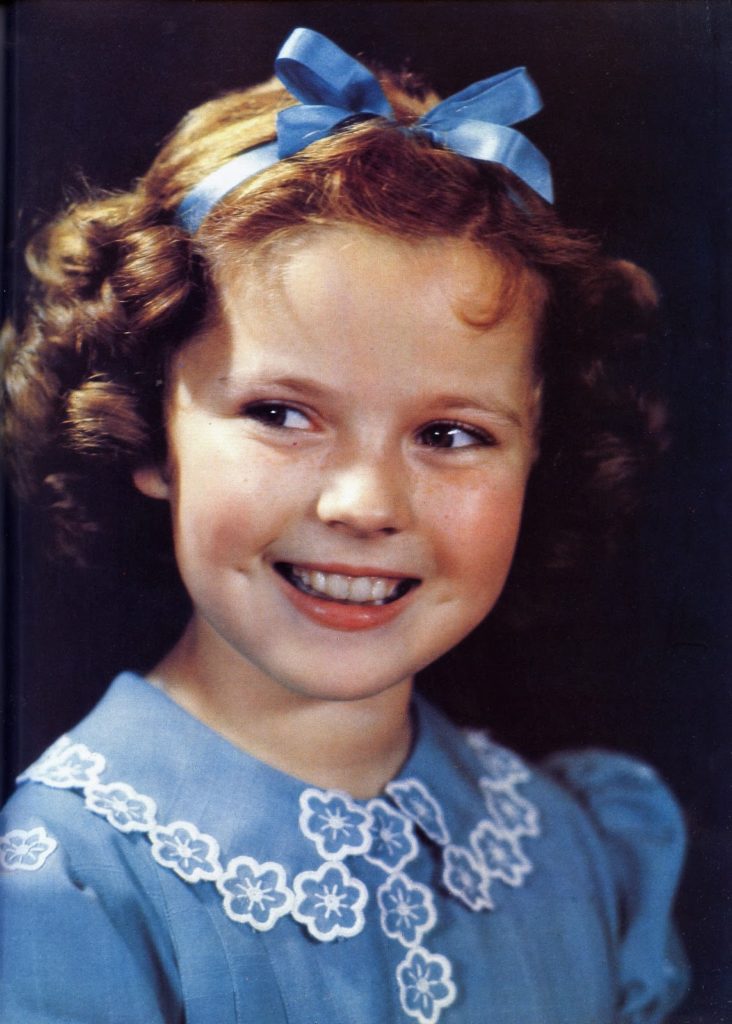 It’s been over three weeks now since the news came that Shirley Temple Black had left us. I’ve spent the time perusing her 1988 autobiography Child Star — refreshingly frank and thorough, if a bit starchy and formal. I’ve also been reacquainting myself with her movies, which was more than a little overdue; I haven’t seen most of her pictures since I was about the age she was when she made them. Some I’ve never seen at all.
It’s been over three weeks now since the news came that Shirley Temple Black had left us. I’ve spent the time perusing her 1988 autobiography Child Star — refreshingly frank and thorough, if a bit starchy and formal. I’ve also been reacquainting myself with her movies, which was more than a little overdue; I haven’t seen most of her pictures since I was about the age she was when she made them. Some I’ve never seen at all.It may sound strange, but the comparison that sprang to my mind when I heard she was gone was with the Beatles, and not just because she appears in the crowd on the cover of Sgt. Pepper’s Lonely Hearts Club Band.
And they went beyond merely breaking the mold. They reset it — in their own image. Pop idols from ABBA and the Bay City Rollers to One Direction and Justin Bieber would all be called the biggest thing since the Beatles, but there never was a “next” Beatles. It’s been 80 years since Shirley Temple’s bit part in Stand Up and Cheer! made America sit up and take notice, and from Jane Withers through Freddie Bartholomew, Roddy McDowall, Margaret O’Brien, Bobby Driscoll, Patty McCormack, Hayley Mills, Tatum O’Neal, Drew Barrymore, Abigail Breslin — plus countless sitcom kiddies sprouting up along the way — there’s never been a “next” Shirley Temple either.
Later, when — as it inevitably must — her box-office power began to wane, her personal popularity never did. Neither did the level-headed cheer that made up her on-and-off-screen personae. There was no descent into bitterness, drugs or alcohol, no pathetic scramble to cling to lost youth, no humiliating splash in the tabloids. A happy second marriage to well-to-do Charles Black helped, but even that might not have happened without the solid, no-nonsense upbringing she got from her mother.
Gertrude Temple was the kind of woman who could have given stage mothers a good name — if there hadn’t been so few like her. She saw to it that little Shirley had a firm sense of self independent of her phenomenal popularity — and in time, independent of her mother. That’s why, when her movie career ended in 1950, Shirley was able to move on without a backward glance. The grace, confidence and poise instilled by Mother Gertrude served her daughter well through those early dizzy years and, more important, long after. They took her smoothly through, first, a second career in early television; then, surprisingly, a third career in politics and international diplomacy, as U.S. ambassador to Ghana and Czechoslovakia and White House chief of protocol; and finally, a long bask in the setting sun as a Dowager Queen of the Golden Age of Hollywood.
I’ll have more to say about those first heady years in posts to come. For now: So long, Shirley, and thanks for the memories. We shall not look upon your like again.
.
Shirley Temple Revisited, Part 1
Shirley Temple got her feet wet in the movie business — and came to the attention of Fox Film Corp. — in Jack Hays’s “Baby Burlesks”. These were a bizarre series of shorts that pretty much have to be seen to be disbelieved. The basic idea was to show toddlers in diapers either spoofing famous movies or engaging in various grown-up activities: war, politics, making movies (although the series called into question exactly how grown-up that particular activity was). The first of these shorts — though the “Baby Burlesks” name hadn’t been adopted yet — was Runt Page, a send-up of Ben Hecht and Charles MacArthur’s The Front Page. And this shot right here was America’s first look at three-year-old Shirley Jane Temple. She sits in her high chair listening as her screen parents and another couple chat about having seen The Front Page; then she flops over in sleep and dreams a ten-minute version of the story featuring her and her tiny playmates.
Like the other kids in the Baby Burlesks, Shirley was under exclusive contract to producer Jack Hays. To finance his share of the shorts (Educational supplied 75 percent of the funding, Hays 25 percent), Hays farmed the kids out for modeling gigs, promotional gimmicks, bit parts or walk-ons, anything that required a child, pocketing most of the money and passing a pittance along to the parents (in Shirley’s case the few dollars supplemented her father George’s income as a branch manager for California Bank). All that shuttling around L.A. on Hays’s loan-outs, on top of her lessons at Mrs. Meglin’s Dance Studio, gave Shirley a tidy fund of experience for one so young.
After Runt Page the dubbing by adult voices was abandoned, and for the rest of the Baby Burlesks’ brief run the kids would all perform, for better or worse, with their own voices. In Shirley’s case it was for the better, as it turned out she could sing and dance. Here, in her seventh Baby Burlesk, Glad Rags to Riches, she sings for the first time on screen, playing Nell (aka night club chanteuse La Belle Diaperene). The song is “She’s Only a Bird in a Gilded Cage”; Shirley is four years and nine months old.
In September 1933 Jack Hays declared personal bankruptcy, and George Temple used his banking contacts to negotiate with Hays’s court-appointed trustee to buy back Shirley’s contract for $25. (Hays, one of Hollywood’s true bottom-feeders, said nothing at the time. But later, after Shirley had hit it big, he tried suing for half a million dollars, claiming the sale had been illegal. His nuisance suit dragged on for years before he finally settled for $3,500.)
After two-and-a-half years, in which she made 15 shorts and appeared in five features, Shirley was unemployed. Then, as the saying goes, fate intervened. At the end of November 1933, at a sneak preview for What’s to Do?, one of the Educational shorts Shirley had made on loan from Hays, she and her mother met songwriter Jay Gorney, recently hired by Fox Film Corp. This landed her an audition with Gorney and his partner Lew Brown, who was also serving as associate producer under Fox production chief Winfield Sheehan. Brown and Gorney cast her in a small part in a picture that was already well into production. For all intents and purposes, whatever her previous experience, Shirley Temple’s screen career — and certainly the Shirley Temple Phenomenon — began with…
Stand Up and Cheer!
(released April 19, 1934)
Stand Up and Cheer! was an “all-star” revue masquerading as a standard book musical (the original working title was Fox Follies). The premise of Ralph Spence’s script, based on a “story idea suggested by” Will Rogers and Philip Klein, was that the U.S. President, in order to help people forget their troubles during the Depression, creates a new cabinet post, Secretary of Amusement, and appoints Broadway producer Lawrence Cromwell (Warner Baxter, essentially xeroxing his Julian Marsh from 42nd Street the year before) to oversee federally-funded public entertainment.
This provided the framework for a series of songs and specialty numbers by guest artists. Most of them were second- and third-string stars even at the time — vaudevillian Sylvia Froos, dreamboat tenor John Boles, blackface red-hot-mama entertainer Tess “Aunt Jemima” Gardella, hillbilly singer “Skins” Miller, knockabout comics Mitchell & Durant — and they’re all now generally (even utterly) forgotten. In fact, the one who’s best-remembered today is the one who wasn’t a star at all — yet: Shirley herself. In this poster she receives seventh billing, but on screen she’s billed third, right after romantic ingenue Madge Evans. Clearly, Fox had some inkling of what they had on their hands.
In Child Star Shirley remembers her mother taking her on December 7, 1933 to audition for Jay Gorney and Lew Brown. She sang “Lazybones” sitting on Brown’s piano, then slid down and stood by while the two songwriters discussed her as if she weren’t there (none of them suspecting, no doubt, that she’d be writing about it half a century hence). Brown was dubious; Winfield Sheehan, he said, was “high on the other kid.” Gorney demurred: “Unnatural, precocious. A revolting little monster.” Brown agreed, and they offered Shirley the part. After all, they wrote the songs for Stand Up and Cheer!, plus Brown was the picture’s associate producer. Shirley never knew how they brought Sheehan around, but Abel Green, in reviewing the picture for Variety, mentions approvingly that Brown had “held out…for that cute Shirley Temple.”
Shirley’s share of Stand Up and Cheer! consisted of two brief scenes, a curtain-call appearance in the movie’s finale, and a song-and-dance duet with James Dunn to “Baby, Take a Bow”. It may have helped them both that “Baby, Take a Bow” was the best song in the score. Or was it that it just seemed like the best because Dunn and Shirley performed it? That’s a chicken-or-the-egg question, but the bottom line was beyond debate: “Baby, Take a Bow” was the highlight of the weird, unruly hodgepodge that was Stand Up and Cheer!
The picture was deep into shooting when Shirley was cast, and the cash-strapped studio couldn’t afford to dawdle, so she had some serious catching up to do. To save rehearsal time, dance director Sammy Lee jettisoned the tap routine he’d taught to Dunn and had the actor learn the steps Shirley already knew from Mrs. Meglin’s. Then, late on her first morning, it was off to the sound studio to pre-record the song. Dunn flubbed several takes, then finally got it right. When her turn came, Shirley stood on a stool (her mother had taught her the words to the song just minutes before) and sang — then was mortified when, on the very last note, her voice slipped into an unintended falsetto (“Dad-dee, take a bow-oo!”). She thought she’d ruined the take and was terrified she’d be fired, but she needn’t have worried; that little half-yodel at the tail end of her vocal provided the perfect “button” to the song and firmly cemented her Cute Quotient.
Stand Up and Cheer! ran 80 minutes, and Shirley was on screen for a mere 5 minutes, 5 seconds. (The picture survives only in a 69 min. version reissued after Fox had merged with Darryl Zanuck’s 20th Century Pictures — but considering that by that time Shirley was the main selling point, it’s a cinch they didn’t cut a frame of hers.) Fleeting as they were, those five minutes were all she needed, and there was no doubt who stopped the show. Variety’s Green got right to the point. In his very first sentence, he wrote: “If nothing else, ‘Stand Up and Cheer’ should be very worthwhile for Fox because of that sure-fire, potential kidlet star in four-year-old Shirley Temple.” (Shirley was five — in fact, she turned six the day before Green’s review appeared — but never mind; Fox publicity had already shaved a year off her age.)
Meanwhile, over on the other coast, the New York Times’s Mordaunt Hall was borderline obtuse. He absurdly compared Stand Up and Cheer! to Gilbert and Sullivan and spent long inches recounting the picture’s plot — not its most prominent virtue — and praising an excruciating scene between Stepin Fetchit (so popular in the ’30s, so cringe-making today) and a penguin in a coat and hat claiming to be Jimmy Durante (the voice impersonated by Lew Brown). But even Hall paused to mention “a delightful child named Shirley Temple.”
Even before the public verdict was in, Winfield Sheehan knew what he had, and he wasted no time locking Shirley down. Two weeks after Shirley’s audition for Brown and Gorney, he tore up the old one-picture, two-week contract and offered a new one for a year, with an option to renew for seven. The money was a lot better, but Shirley and her parents were still dealing in a buyer’s market, and Fox got a sweet deal.
That was the easy part. Now the question was: How could Fox — bleeding cash, defaulting on loans and teetering on bankruptcy — exploit their most promising new star when she was only five — oops! make that [wink] four — years old? While they mulled that over, Fox decided to make a little mad money by loaning her out. And so it was that Shirley Temple’s first above-the-title credit, and the role that confirmed her as a bona fide star, came to her from another studio.
To be continued…
Shirley Temple Revisited, Part 2
Even at the age of five, Shirley already knew two things: (1) animals can’t be counted on to follow the script, and you have to be ready to deal with what they actually do; and (2) no matter what happens, only the director gets to call “Cut!” (By the way, the pony’s kick did not remain in the picture; it would have detracted too much from the “murder” of the doll, the dramatic point of the scene.)
Shirley’s new contract with Fox was exclusive, but in the immediate aftermath of shooting “Baby, Take a Bow” for Stand Up and Cheer! all the studio found for her to do was a less-than-worthless bit in a Janet Gaynor/Charles Farrell romance called Change of Heart. Eight seconds on screen — with her back to the camera, yet! — and not a syllable of dialogue; it was worse than the bits Jack Hays used to send her on. Mother Gertrude set out to drum up some work — if some other studio wanted her daughter, surely a loan could be worked out — and she had just the picture in mind, over at Paramount. It was one for which Shirley had already auditioned and been dismissed out of hand. (“They took one look, watched me dance, and rejected me without a smile.”)
Little Miss Marker
(released June 1, 1934)
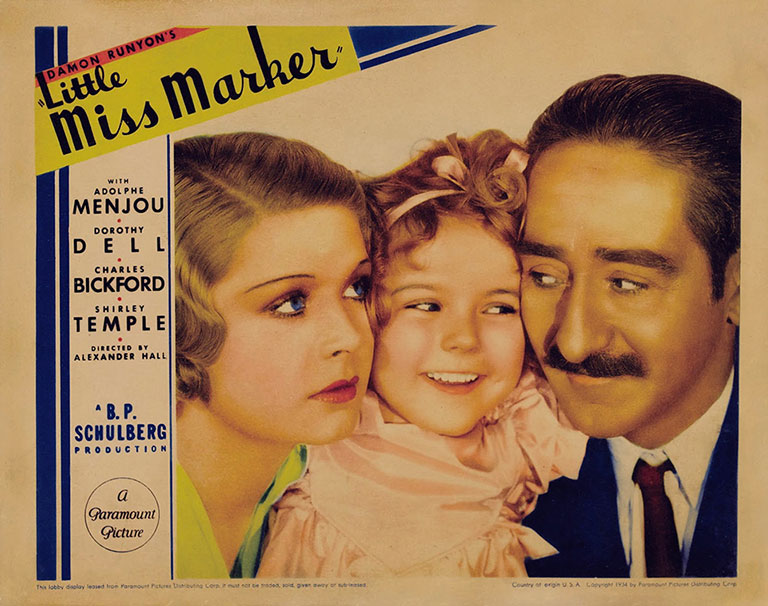 Somehow, this time Gertrude was able to wangle an interview with the movie’s director, Alexander Hall. In Child Star Shirley doesn’t know how Mother did it; I wouldn’t be surprised if word of Shirley’s song-and-dance with James Dunn was already circulating on the Hollywood grapevine. In any event, Shirley auditioned for Hall personally.
Somehow, this time Gertrude was able to wangle an interview with the movie’s director, Alexander Hall. In Child Star Shirley doesn’t know how Mother did it; I wouldn’t be surprised if word of Shirley’s song-and-dance with James Dunn was already circulating on the Hollywood grapevine. In any event, Shirley auditioned for Hall personally.“No, kid! Stop! We’re finished.” It was as simple as that; Shirley had the part. Paramount offered Fox $1,000 a week for Shirley’s services (a huge profit over the $175 in her Fox contract), and on March 1, 1934 Shirley reported for her first costume fittings for Little Miss Marker.
William R. Lipman, Sam Hellman and Gladys Lehman’s script was adapted from a story by Damon Runyon about a sourpuss bookie named Sorrowful who grudgingly accepts a bettor’s small daughter as a sort of “hostage” for a two-dollar bet on a horse race. The father promises to get the money and be right back, but he never comes back. Sorrowful finds himself saddled with the little girl, whose sunny sweetness gradually thaws his heart, brightens his outlook and loosens his airtight purse strings. Everyone notices the change the tot makes in Sorrowful, and they warm to little “Marky” themselves.
Damon Runyon died in 1946, but his name has stayed current in American culture thanks to the Broadway musical Guys and Dolls (its title taken from one of his story anthologies, its plot from two of his tales). But Guys and Dolls has also skewed the popular image of his stories and what it means to be “Runyonesque”. The musical is set in a rollicking fantasy land of cute underworld denizens — grifters, mugs, oafs and dames, colorful and essentially harmless. In Runyon’s stories there is humor, to be sure, but it’s not rollicking; it’s more often sardonic, even mordant, and the atmosphere of the stories, despite the picturesque speech, is hardly fantasy. The world of Runyon’s nameless narrator is gritty and down to earth, lit by bare bulbs in cheap hotel rooms and the gaudy glare of street neon; we can almost smell the cheap cigars and stale perfume. Things may work out — for the time being — for the characters, but it’s usually thanks to ironic accidents, not a benign universe. There’s often an undercurrent of menace beneath the whimsy, and bad things do happen.
And so it is in “Little Miss Marker”. One snowy night Marky wakes to find her nursemaid asleep and Sorrowful gone. Running outside barefoot in her nightgown, she tracks him to the Hot Box nightclub and runs into his arms just as a killer named Milk Ear Willie is about to settle an old grudge by plugging Sorrowful. Willie changes his mind, so Marky has saved Sorrowful’s life — but at the cost of her own. She contracts pneumonia and dies in hospital, despite the efforts of Sorrowful and his associates (even Milk Ear Willie chips in, kidnapping a famous child specialist to attend Marky’s bedside). Minutes after Marky’s death her father turns up, having suffered from amnesia since the day he left his little girl with the bookmaker. He has read about Marky in the newspapers and has finally come to take her home. “I suppose I owe you something?” he asks Sorrowful. Yes, says the bookie, you owe me two bucks. “I will trouble you to send it to me at once, so I can wipe you off my books.” He is once again the old Sorrowful, with the same “sad, mean-looking kisser” he had before — “and furthermore,” says the narrator, “it is never again anything else.”
The movie keeps Runyon’s hospital climax — Marky is there with life-threatening injuries from falling from a horse, not pneumonia — but softens the ending: Marky lives, and Sorrowful’s reformation is allowed to stick. (The writers also gave Sorrowful a surname, Jones, which is not in the story but has stayed with him through two remakes.) Otherwise, it’s faithful to the spirit of Runyon’s story — basically a drama with small comic flourishes — with a suitable mix of seediness and vulgar glamour. Surely, Runyon was pleased.
Little Miss Marker contains one of the most unusual movie pairings of the 1930s: Shirley Temple and Adolphe Menjou. The usually dapper, immaculately tailored Menjou (he was voted Best Dressed Man in America nine times) was, at first glance, an odd choice not only to team with a child but to portray the rumpled, unkempt Sorrowful Jones. But it works; Shirley’s Marky brings out the debonair sport in Menjou’s Sorrowful, the one we knew was there all the time, by inspiring him to move to a more suitable apartment and upgrade his wardrobe. (Curiously enough, Menjou would play a similarly disheveled grump, and have a similar rapport with kids, in his last picture, Disney’s Pollyanna in 1960 — this time with two child stars, Hayley Mills and Kevin Corcoran.)
Shirley says in Child Star that Menjou once offered to play hide-and-seek with her, but otherwise tended to keep his distance (“off-camera he treated me with the reticence adults commonly reserve for children”). But when the camera’s rolling the two have a remarkable chemistry. It’s there when Marky and Sorrowful first meet, as she stands beside her father on the divider railing in Sorrowful’s shabby office. Sorrowful orders Marky “down offa there”, but she teases him: “Look, Daddy, he’s running away! Is he afraid?…You’re afraid of my daddy! Or you’re afraid of me. You’re afraid of something…” There follows a remarkable moment when Sorrowful picks Marky up, supposedly to get her off the railing, but holds her for a short while, her hands resting on his shoulders, while their eyes meet. Then he sets her down and growls to his henchman Regret (Lynn Overman), “Take his marker…A little doll like that’s worth twenty bucks. Any way you look at it.” (“Yeah,” Regret grumbles, “she oughta melt down for that much.”)
The chemistry is there, too, in a charming scene where Sorrowful and Marky talk about God, and he grudgingly agrees to teach her to say her prayers: “All right, get outta bed. I’ll show you how to pray. Sort of. But don’t you tell anybody, see?” The topper to the scene is the look on Sorrowful’s face when he hears why she wanted to learn: “And please, God, buy Sir Sorry a new suit of clothes.” In the very next scene, Sorrowful the sartorial butterfly has hatched out of his rumpled cocoon. (“Sir Sorry the Sad Knight” is the name Marky gives Sorrowful; she names all his cronies according to the stories she’s heard about King Arthur.)
 Little Miss Marker fleshed out and in many ways improved Runyon’s original story. The amnesiac-father angle was always a bit of a credulity stretch; in the movie he becomes a suicide — driven off the end of his rope when the bet he placed with Sorrowful turns out a loser. This heightens Sorrowful’s sense of obligation to Marky: the race was rigged and he knew it when he took the man’s bet. It also links Marky to that losing horse, the ironically named Dream Prince. When Big Steve, Dream Prince’s owner, is suspended over suspicions about that fixed race, Steve and Sorrowful set Marky up as Dream Prince’s dummy owner so the horse can continue to run. Marky’s affection for “the Charger” (another one of her fanciful King Arthur names) draws her, Sorrowful and Bangles closer together, and leads to a crisis when Big Steve gets wind of shenanigans behind his back.
Little Miss Marker fleshed out and in many ways improved Runyon’s original story. The amnesiac-father angle was always a bit of a credulity stretch; in the movie he becomes a suicide — driven off the end of his rope when the bet he placed with Sorrowful turns out a loser. This heightens Sorrowful’s sense of obligation to Marky: the race was rigged and he knew it when he took the man’s bet. It also links Marky to that losing horse, the ironically named Dream Prince. When Big Steve, Dream Prince’s owner, is suspended over suspicions about that fixed race, Steve and Sorrowful set Marky up as Dream Prince’s dummy owner so the horse can continue to run. Marky’s affection for “the Charger” (another one of her fanciful King Arthur names) draws her, Sorrowful and Bangles closer together, and leads to a crisis when Big Steve gets wind of shenanigans behind his back.
To be continued…
Shirley Temple Revisited, Part 3
At this point in our story it’s still the spring of 1934. Before renting Shirley Temple out to Paramount to become a star, Fox frittered her away in one more pointless bit in Now I’ll Tell. Actually, the picture’s full title on screen was “Now I’ll Tell” by Mrs. Arnold Rothstein, and as that suggests, it purported to be the inside dope on the high-flying life and mysterious death of Mrs. Rothstein’s deceased husband, the gangster/gambler who fixed the 1919 World Series, was shot in November 1928 (apparently for welshing on a poker debt), and died two days later refusing to name his killer. Names were changed to protect the guilty, so Spencer Tracy starred as “Murray Golden”, with Helen Twelvetrees as his saintly, noble wife (Mrs. Rothstein wrote the story, remember!), and with Rothstein’s many mistresses combined into one person and played by 18-year-old Alice Faye.
Shirley’s role was an inch or two better than in Change of Heart: 42 seconds on screen and a whopping five lines of dialogue (to wit: “And we saw a cow there, too!”, “Does a black cow make black milk?”, “Good night”, and “Good night, Daddy” — twice). Publicity poses like this one may have led Shirley to misremember her role as that of Tracy’s daughter; in fact, she played the daughter of Tommy Doran (Henry O’Neill), a boyhood chum of Golden’s who grows up to be a police detective — on the other side of the law from his old pal. A decent enough gangland melodrama, Now I’ll Tell hit screens one week after Little Miss Marker, and could only have underscored Fox’s cluelessness.
(A side note: While Fox quickly learned to value Shirley, they never did know what they had in Spencer Tracy. They put him in 18 pictures in five years, usually as mugs and lummoxes, with the occasional loan-out here and there. Gradually he built a reputation as one of the best actors in town, but Fox kept wasting him on parts you could practically train a gorilla to play. Eventually they let him slip through their fingers into a contract with MGM in 1935. Within two years at Metro, Spence had snagged his first Oscar nomination; in the following two years he got his second and third, winning both times.)
After Now I’ll Tell, however, Shirley’s days of Poverty Row shorts, four-line bits and uncredited walk-ons were finally behind her. For her next picture, she got top billing at last from her home studio, and just to remind audiences where they’d seen this kid before, Fox changed the title to…
Baby Take a Bow
(released June 30, 1934)
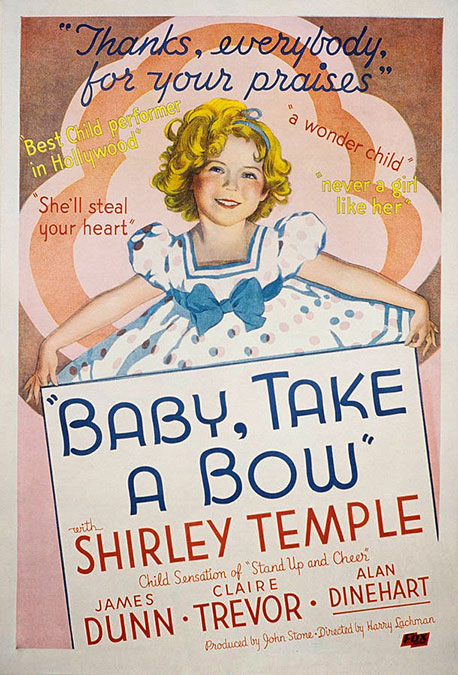 First, an explanation of a trivial point, just so you don’t suspect sloppy copy editing here at Cinedrome. The title of Jay Gorney and Lew Brown’s song “Baby, Take a Bow” has a comma, and the comma appears in this and some other posters, ads and lobby cards for the movie. But it’s not on the picture’s main title card as it appears on screen. Therefore, I’ll be using the comma when referring to the song, but not using it when I’m referring to the movie. Got it?
First, an explanation of a trivial point, just so you don’t suspect sloppy copy editing here at Cinedrome. The title of Jay Gorney and Lew Brown’s song “Baby, Take a Bow” has a comma, and the comma appears in this and some other posters, ads and lobby cards for the movie. But it’s not on the picture’s main title card as it appears on screen. Therefore, I’ll be using the comma when referring to the song, but not using it when I’m referring to the movie. Got it?Robert Armstrong and John Mack Brown played two ex-cons trying to go straight who fall under suspicion when a crony from their criminal days steals a pearl necklace from their wealthy employer. The thief tries to get the two to fence the pearls but they refuse. Complications arise when the thief, sensing the cops hot on his trail, stashes the necklace with Armstrong’s unsuspecting little girl, who thinks it’s a birthday present. What follows is a comic round of button-button-who’s-got-the-button as the thief tries to retrieve the pearls; the heroes try to return them to their boss; an implacable insurance detective seeks to get the goods on the heroes, whom he suspects of the theft; and the little girl thinks it’s all a game of hide-and-seek.
Be that as it may, we certainly know who played the kid in the sound remake. Shirley is shown here with Claire Trevor, who plays her mother and James Dunn’s wife. Trevor is younger and softer in Baby Take a Bow than we remember her from her better-known performances — Stagecoach; Key Largo; The High and the Mighty; Murder, My Sweet — she could almost pass for Ginger Rogers here.
Baby Take a Bow opens as Eddie Ellison (Dunn) is released from Sing Sing, promising to go straight. His girl Kay (Trevor) meets him at the gate, with continuing tickets for them to Niagra Falls for a justice of the peace wedding and honeymoon. At the same time we meet insurance investigator Welch (Alan Dinehart in an interesting performance), a tinhorn Javert who bluffly pals around with the men of various police forces — and tries in vain to make time with Kay. Everybody, especially Kay, makes it clear that they don’t like him, but Welch remains oblivious, blithely carrying on as if he’s one of the guys. Six years later, when Eddie and Kay have built a happy home with their daughter Shirley (star and character share the given name), it will be Welch who tries to hound Eddie and his pal Larry (Ray Walker) back into prison.
Variety’s reviewer “Kauf” pegged Baby Take a Bow exactly: “Without Shirley Temple this might have been a pretty obvious and silly melodrama, but it has Shirley Temple so it can go down on the books as a neat and sure b.o. (box office) hit, especially for the family trade.” (It’s a pity Mori couldn’t have reviewed it; it would be interesting to have him compare it to Square Crooks — assuming he even remembered a six-year-old silent B picture as late as 1934.) Meanwhile, back east at the New York Times, the anonymous reviewer sounded the first notes of praise mixed with highbrow condescension that would increase in some quarters in coming years (and would lead eventually to a successful libel suit against novelist Graham Greene and the British magazine Night and Day):
Little Shirley Temple continues in her new film at the Roxy to be the nation’s best-liked babykins. A miracle of spontaneity, Shirley successfully conceals the illusion of sideline coaching which, in the ordinary child genius, produces homicidal impulses in those old fussbudgets who lack the proper admiration for cute kiddies.
Before embarking on her next picture at Fox, Shirley was shuttled back to Paramount for another loan-out:
Now and Forever
(released August 31, 1934)
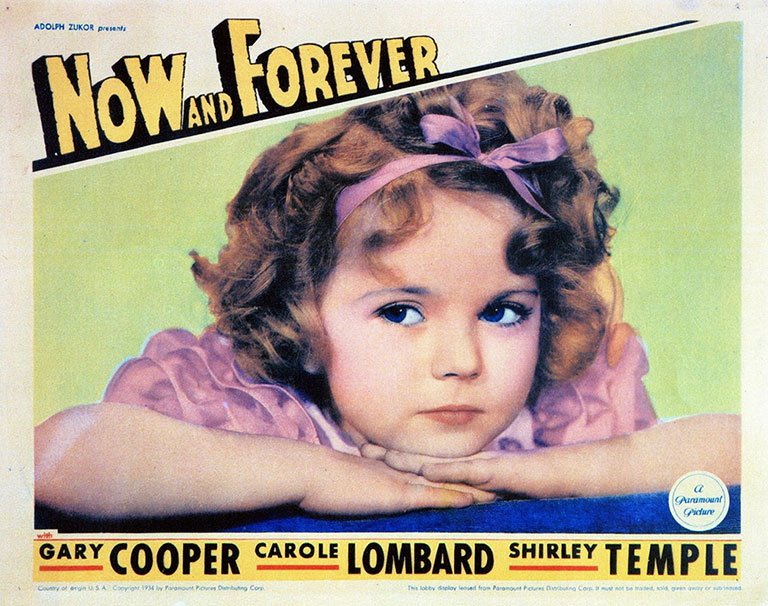
Shirley’s billing on Now and Forever was again above the title, but third this time. Still, when you’re billed third after Gary Cooper and Carole Lombard, you’ve really got no kick coming. (On screen she gets an “and”: “And SHIRLEY TEMPLE”.) Even more significantly, the music under the opening titles is an instrumental rendition of “Laugh, You Son of a Gun” — reminding audiences of Little Miss Marker the way Baby Take a Bow had reminded them of Stand Up and Cheer!
To be continued…
Shirley Temple Revisited, Part 4
According to the IMDb, Now and Forever‘s U.S. release date was August 31, 1934. However, it wasn’t reviewed by the New York Times or Variety until October 13 and 16, respectively. Apparently, either Fox sent the picture off to down-market engagements two-and-a-half months before opening it in New York — or (more likely, I think) the IMDb has the date wrong.
Whatever the case, both Andre Sennwald in the Times and Abel Green (again) in Variety pegged Shirley as Now and Forever‘s saving grace. Sennwald:
The little girl has lost none of her obvious delight in her work during her rise to fame. In “Now and Forever” she is, if possible, even more devastating in her unspoiled freshness of manner than she has been in the past…With Shirley’s assistance [the photoplay] becomes, despite its violent assaults upon the spectator’s credulity, a pleasant enough entertainment.
And Green:
“Now and Forever” is a remote title; it strains credulity; it can’t stand analysis; it has sundry other technical and plausibility shortcomings — but it has Shirley Temple and that virtually underwrites it for boxoffice…Shirley Temple in “Uncle Tom’s Cabin” would probably click just as well.
In these reviews, both written by seasoned showbiz observers, the subtext is unmistakeable: Shirley Temple saves the show; Gary Cooper and Carole Lombard do their best, but without Shirley they’d have gone down with the ship. And Shirley is still only six years old.
Next it was back home to Fox for…
Bright Eyes
(released December 20, 1934)
 As bad as the Smythes are, they’re not the worst of it. That would be their daughter Joy (Jane Withers), a screaming little monster in a perpetual state of tantrum, and the most misnamed child in the history of human life on Earth.
As bad as the Smythes are, they’re not the worst of it. That would be their daughter Joy (Jane Withers), a screaming little monster in a perpetual state of tantrum, and the most misnamed child in the history of human life on Earth.
In real life, eight-year-old Jane was nothing like the character she played. Bright Eyes was her big break after a handful of uncredited bits since 1932. Fox quickly signed her to a seven-year contract and she went on to become a star in her own right, though inevitably in Shirley’s shadow, especially since they worked for the same studio. The two girls never worked together again — which is a pity, because Jane was the perfect foil for her younger co-star, and in Bright Eyes she comes as close as anybody ever did to stealing a show from Shirley Temple. Playing an obnoxious, spoiled-rotten brat, Jane was genuinely funny — no small achievement when you consider how many child actors over the years have tried to be funny, only to come off looking like obnoxious, spoiled-rotten brats.
Jane continued acting into her early 20s, even after 20th Century Fox dropped her in 1942, then she retired from the screen in favor of marriage to a rich Texas oil man. That foundered after eight years, and Jane made a comeback as a character actress in George Stevens’s Giant in 1956. Thereafter, she stayed busy in movies and on TV, and she became familiar to millions of baby boomers as Josephine the Plumber in a series of commercials for Comet Cleanser in the 1960s and ’70s. As of this writing Jane Withers is still with us, and hopefully in good health and spirits. Continued long life to her.
* * *
In a nutshell — and not counting five shorts and bit roles under her old contract to Jack Hays, or the two walk-ons in Change of Heart and Now I’ll Tell — Shirley Temple’s output for 1934 consisted of a breakthrough debut in Stand Up and Cheer!, a confirming star turn in Little Miss Marker, a placeholding appearance in Baby Take a Bow, credit for the save in Now and Forever, and a tailor-made vehicle in Bright Eyes. A great year for any rising star, and unprecedented for one who turned six midway through it.
In Child Star Shirley remembers that when Oscar nominations for 1934 were announced, “a vicious cat fight had erupted. My name was on the nomination list and odds-makers had me an almost certainty to win.” She goes on to assert that a storm of protest arose over the Academy’s failure to nominate either Myrna Loy for The Thin Man or Bette Davis for Of Human Bondage, and that as a result her own nomination was rescinded and voting rules changed to allow for write-ins. I’ve been unable to find this confirmed anywhere else, and I suspect Shirley’s memory was playing her false. She doesn’t say which picture she believed she had been nominated for (if they’d had supporting awards in ’34, she might have been a cinch to win for Little Miss Marker, but those categories were still two years in the future). Shirley is right, however, about the write-ins and the protest — though the storm was more on behalf of Davis than Loy (in the end, the award went to Claudette Colbert for It Happened One Night; Davis, even with the write-ins, came in third).
Be that as it may, there was no ignoring Shirley’s meteoric rise to the top tier of box-office stars, and the Academy Board of Governors conferred a new award, a miniature statuette “in grateful recognition of her outstanding contribution to screen entertainment during the year”. The emcee at that year’s awards was the prolific Kentucky humorist, author and columnist Irvin S. Cobb (shown here with Shirley), one of those writers whose fame more or less died when he did in 1944. Most of his 60-plus books and 300 short stories are out of print now, and he is probably best remembered for what he said that night. First: “There was one great towering figure in the cinema game, one artiste among artistes, one giant among the troupers, whose monumental, stupendous and elephantine work deserved special mention…Is Shirley Temple in the house?” Then, after Shirley joined him at the podium: “Listen, y’all ain’t old enough to know what this is all about. But honey, I want to tell you that when Santa Claus wrapped y’all up in a package and dropped you down Creation’s chimney, he brought the loveliest Christmas present that was ever given to the world.”
In Child Star, even 50-plus years on, Shirley’s disappointment still sounds tender to the touch (“If mine was really a commendable job done, why not a big Oscar like everyone else’s?”), but I think she overlooks the specialness of her special award (the only one given that year). The miniature Oscar that was created just for her would remain the standard recognition for outstanding juvenile performers for the next 26 years, and would be given 11 more times. The last went to Hayley Mills for Pollyanna in 1960; after that, beginning with nine-year-old Mary Badham for To Kill a Mockingbird in 1962, the kids would have to take their chances with the grownups (and some — Patty Duke, Tatum O’Neal, Anna Paquin — would even win). Of those dozen miniature-Oscar winners — who include Mickey Rooney, Deanna Durbin, Judy Garland, Margaret O’Brien and others — the little girl who inspired the creation of it was the youngest to receive it. In fact, she remains to this day the youngest person ever to win anything from the Academy of Motion Picture Arts and Sciences. I doubt if that record will ever be broken.
Shirley Temple Revisited, Part 5
The Little Colonel
(released March 21, 1935)
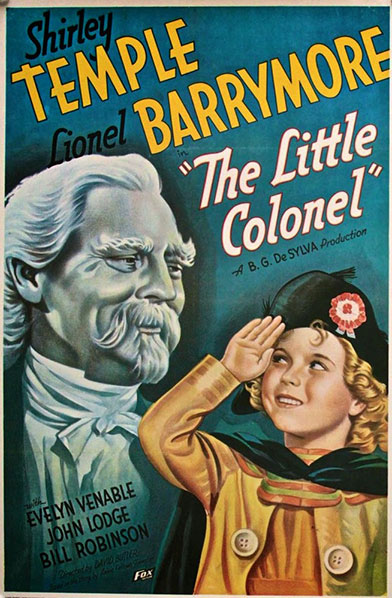 Shirley’s first picture of 1935 was a period piece, her first costume drama as a star. The source material was a children’s book by Annie Fellows Johnston of McCutchanville, Indiana. Mrs. Johnston turned to writing at the age of 29 when her husband died in 1892, leaving her with three small stepchildren to raise on her own. The Little Colonel, published in 1895, was her third novel, and it proved so popular that she wrote a sequel a year until 1907. She wrote, in all, some four dozen books before she died in 1931 at age 68, but The Little Colonel was the only one that was ever filmed. It’s a pity Mrs. Johnston couldn’t have hung on for four more years and seen the apotheosis of her most famous creation.
Shirley’s first picture of 1935 was a period piece, her first costume drama as a star. The source material was a children’s book by Annie Fellows Johnston of McCutchanville, Indiana. Mrs. Johnston turned to writing at the age of 29 when her husband died in 1892, leaving her with three small stepchildren to raise on her own. The Little Colonel, published in 1895, was her third novel, and it proved so popular that she wrote a sequel a year until 1907. She wrote, in all, some four dozen books before she died in 1931 at age 68, but The Little Colonel was the only one that was ever filmed. It’s a pity Mrs. Johnston couldn’t have hung on for four more years and seen the apotheosis of her most famous creation.
Anyone who thinks that a movie is never as good as the book should try reading The Little Colonel. Mrs. Johnston’s ever-so-precious style hasn’t weathered the years well; I suspect it hadn’t by 1935, either. (It’s available online here if you want to check it out.) The story, as the saying goes, had “good bones”, and writer William Conselman fleshed them out rather better than Mrs. Johnston had. (Conselman also wrote Bright Eyes and would write for Shirley again.)
In Conselman’s script (unlike the original book), the story opens before the birth of its title character. A title tells us it’s “Kentucky in the ’70s”, and we meet old Colonel Lloyd (Lionel Barrymore), an unreconstructed Confederate for whom the War isn’t over. At a soiree at his plantation he offers a toast: “Gentlemen, I give you the South — and confusion to her enemies!” But it’s the Colonel who’s due for confusion; one of those “enemies”, a Northerner — named Sherman, no less — has won the heart of his beloved daughter Elizabeth (Evelyn Venable). The Colonel interrupts her and her intended (John Lodge) in the act of eloping, and he warns her: “Elizabeth, when that door closes, it’ll never open for you again.” Elizabeth leaves without another word, and she doesn’t close the door — she slams it.
Next scene, it’s six years later and the Shermans — Jack, Elizabeth and their daughter Lloyd (Shirley) — are at a military outpost on the edge of the western frontier. Lloyd has become the darling of the post, and she receives a commission as honorary colonel — an addition by Conselman that makes the girl a “little colonel” in fact, not just as the nickname the author gives her in the original story. The family has sold everything they own and left their Philadelphia home. Papa Jack is to continue west to make a new home for them; when he’s well-established and it’s safe, he’ll send for his wife and daughter. Until then, Elizabeth and the Little Colonel will return to Kentucky and live in a small cottage on the family property that was left to her by her mother.
Later, when the old man learns who she is, he is mollified, even apologetic. He may have disowned his daughter and her husband, but he sees no reason not to associate with his granddaughter — especially since she reminds him so much of himself (and his outcast daughter, though he won’t admit it).
There’s another teaming in The Little Colonel that also makes it crackle. Playing the Old Colonel’s butler Walker was Bill “Bojangles” Robinson. Robinson began in vaudeville in 1900, and by 1934, when The Little Colonel was made, he was universally recognized (and for that matter, still is) as one of the greatest tapdancers who ever lived. Shirley was always proud that she and Robinson were the first interracial dance team in movie history. More than that, because of the age difference between six-year-old Shirley and the 56-year-old Robinson (and at the time, let’s face it, because of the difference in the color of their skin), they were one male-and-female team whose dances carried no hint of courtship or romance — nothing but the sheer joy of dancing together. (“The smile on my face wasn’t acting,” Shirley said in Child Star; “I was ecstatic.”) The teaming was Winfield Sheehan’s idea, and he hesitated only because he was unsure if Robinson could act; his three previous screen appearances had been dance-only. Robinson passed a screen test, and that was that. In all, he and Shirley would make five pictures together (I’ll get to the others in their time), and it all started here.
Their first dance together was the famous staircase dance. It was Robinson’s signature act, and he modified it to accomodate Shirley’s abilities; she couldn’t have come up to his level in the rehearsal time they had — but then, probably nobody could, no matter how long they rehearsed. Shirley remembered her “Uncle Billy” as “a superlative teacher, imperturbable and kind, but demanding…Every one of my taps had to ring crisp and clear in the best cadence. Otherwise I had to do it over.”
It must be said that racial attitudes of the 1930s make The Little Colonel (and The Littlest Rebel, later in ’35) an awkward experience for some people today. It’s hard not to view these movies through the hindsight of how far African Americans have come (on screen and in real life) in the last 80 years. It’s worth remembering, though, the progress they had made by 1935 — what little there was, and only on screen at that — in the 40 years since The Little Colonel was written (or even the 20 years since The Birth of a Nation). We rightly cringe now when Colonel Lloyd calls to his granddaughter’s black playmates, “Come on, you pickaninnies!” But in Annie Fellows Johnston’s novel he uses an even uglier word — and for that matter, so does the Little Colonel herself. And to be fair to The Little Colonel (the movie), there’s a scene where Lloyd attends a black church’s baptism ceremony in a stream that runs through her grandfather’s property; the scene is presented unpatronizingly and without condescension. Also, the two most prominent black characters are played by Robinson as Walker and, as the Little Colonel’s cook and housekeeper “Mom Beck”, Hattie McDaniel (five years before she became the first African American to win an Academy Award). Both of them imbue their characters with a warmth and dignity that rises above the racism of the time.
Plus, of course and always, there’s the sheer pleasure of Shirley and Bojangles dancing.
Shirley Temple Revisited, Part 6
 Our Little Girl
Our Little Girl
(released June 6, 1935)
I’m not going to spend a lot of time on Shirley’s next picture because…Well, if (as I said in Part 3) Now and Forever is a bit of a dud, Our Little Girl is a flat-out stinker. A country doctor (Joel McCrea) gets so wrapped up in his practice and his research that his wife (Rosemary Ames), feeling ignored, seeks comfort first in the company, then in the arms, of their bachelor neighbor (Lyle Talbot). Meanwhile, the doctor’s nurse (Erin O’Brien-Moore) nurses an unrequited love for him. Caught in the middle of all this, and neglected by both her parents, is the couple’s daughter (Shirley).
Shirley couldn’t save this one; nothing could. The script by Steven Avery and Allen Rivkin was an indigestible stew of sugar, soap and corn, and director John Robertson (a veteran whose credits went back to 1916) was utterly defeated by it. On the other hand, even a brilliant script couldn’t have survived Robertson’s leaden, clomping direction, which made the picture feel much longer than the 64 minutes it actually ran. Perhaps not incidentally, this was Robertson’s last movie, as it was for leading lady Rosemary Ames, whose two-year, eight-picture career ended here.
Shirley never made a worse movie, and neither did Joel McCrea. (Lyle Talbot did — but only because he made three pictures with Ed Wood.)
Variety’s reviewer “Odec” predicted (accurately) that “despite [the] story”, Shirley’s fans would make the picture profitable. At the New York Times, Andre Sennwald was less conciliatory: “As we have learned to expect, ‘Pollyanna’ and ‘The Bobsey Twins’ [sic] are classics of gutter realism by comparison with the sentimental syrups which Miss Temple’s impresarios arrange for the Baby Duse.“ Dyspeptic, yes, but Our Little Girl had it coming, and worse. (Mr. Sennwald still spoke fondly of Little Miss Marker, but he was clearly reaching a saturation point, if not with Shirley, at least with her vehicles. As fate would have it, he would review only two more of them — Curly Top and The Littlest Rebel, with increasing asperity — before dying in a gas-line explosion in his Manhattan penthouse on January 12, 1936; Sennwald was only 28.)
In Child Star, Shirley said of Our Little Girl, “I forgot it as soon as possible.” As well she might, but it wasn’t because of the picture itself; it was due to things that happened during shooting.
First: Shirley was going through the normal tooth losses of any kid her age, but shooting couldn’t be held up while they grew back, so she wore temporaries for the camera. One day on Our Little Girl‘s rural location, she sneezed two of hers out into a grassy meadow. The whole crew searched long through the grass, but to no avail, and the company had to wrap for the day while new ones were crafted for the little star. Shirley had conceived a girlish crush on Joel McCrea, and seeing his annoyance at the delay, she was accordingly chagrined.
But worse was to come; the very next day, Shirley’s chagrin turned to mortification. Standing with McCrea by a stream while lighting gaffers fiddled endlessly with their lights and reflectors, and with the long silence broken only by the trickle of the nearby brook, Shirley — there’s no gentle way to say it — wet her pants. Understandably, she immediately burst into tears. Mother Gertrude gently led her sobbing daughter to their trailer, where socks and undies were replaced, then Mother bucked up Shirley’s courage for the unavoidable return to the set. “Finally I mustered enough confidence to open the door,” Shirley wrote, “but only by convincing myself the whole thing had never happened.” She considered that moment her “Oscar performance”.
Poor Shirley. Even fifty-plus years on, writing in Child Star, her humiliation is still palpable. No wonder she forgot Our Little Girl without delay. We should too.
 Curly Top
Curly Top
(released August 1, 1935)
Shirley plays Elizabeth “Curly” Blair, an orphan who charms Edward Morgan (John Boles), one of the rich trustees of the orphanage where she lives; Morgan legally adopts Curly while pretending to be acting on behalf of one “Hiram Jones.”
The story was a liberal reworking of Jean Webster’s 1912 novel Daddy Long Legs, which told of Judy Abbott, an orphan who, when she grows too old to stay at her orphanage, is sponsored through college by a benefactor who insists on remaining anonymous. By story’s end Judy learns that the mysterious “John Smith” is wealthy Jervis Pendleton, whom she knew (and had a girl’s crush on) from his visits to the orphanage. Now full-grown (and college educated), Judy marries him. Webster’s novel had already been filmed in 1919 with Mary Pickford and in 1931 with Janet Gaynor (and would be again in 1955, as a musical starring Fred Astaire and Leslie Caron). Since Fox had produced the 1931 version and still owned the screen rights to the story, they were at liberty to refashion it to fit Shirley.
Needless to say, if the boys at Fox couldn’t wait for Shirley’s adult teeth to grow in, they certainly couldn’t sit around while she reached an age to marry John Boles, so Patterson McNutt and Arthur Beckhard’s script supplied Curly with an older sister Mary (Rochelle Hudson) to be adopted with her and to discharge the romantic duties with the handsome Boles. Hudson and Boles even held up their end with the songs: Hudson, a neophyte singer, did quite well with “The Simple Things in Life” (by Edward Heyman and Ray Henderson), while Boles returned to his musical comedy roots with “It’s All So New to Me” (also by Heyman and Henderson) and the picture’s title song (Henderson and Ted Koehler).
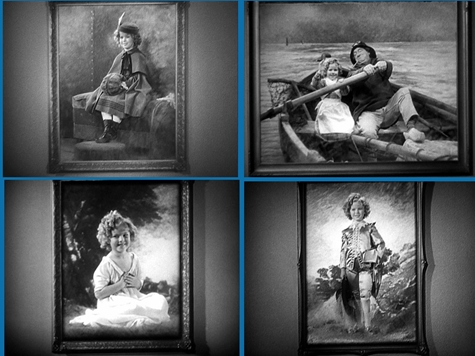 But like the story, the supporting players (Boles; Hudson; Jane Darwell and Rafaela Ottiano as matrons at the orphanage; Esther Dale as Boles’s aunt; Billy Gilbert and Arthur Treacher as his cook and butler) were all beside the point. Shirley was just about the whole show. She is even the focus of both Boles’s songs. After singing “It’s All So New to Me”, while the orchestra wafts on in the background, he strolls around his palatial drawing room, where he fancies Shirley beaming down at him from the paintings on the walls…
But like the story, the supporting players (Boles; Hudson; Jane Darwell and Rafaela Ottiano as matrons at the orphanage; Esther Dale as Boles’s aunt; Billy Gilbert and Arthur Treacher as his cook and butler) were all beside the point. Shirley was just about the whole show. She is even the focus of both Boles’s songs. After singing “It’s All So New to Me”, while the orchestra wafts on in the background, he strolls around his palatial drawing room, where he fancies Shirley beaming down at him from the paintings on the walls…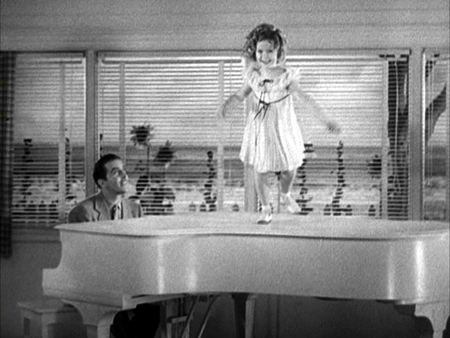

Curly Top was Shirley’s last picture for Fox Film Corp., and her last with Winfield Sheehan, who had piloted her career since Stand Up and Cheer! As chief of production in the wake of William Fox’s personal and professional nosedive in 1929-30, Sheehan had managed to stave off the studio’s total financial collapse (largely through hanging on to Will Rogers and locking Shirley into a long-term contract), but the waters were still rocky. Even before Curly Top went into production, there were rumors of negotiations with the upstart Twentieth Century Pictures, a thriving new kid in town, but one in need of a studio complex and distribution system — one like Fox’s, for example. On May 29, 1935, a merger was announced; the new studio would be called 20th Century Fox. Less than two months later, Winfield Sheehan was out as head of production, replaced by the man who had spearheaded Twentieth Century to a success that entitled it to be senior partner in its merger with the more venerable Fox. The man, moreover, who would be in charge of Shirley’s career for the rest of the 1930s: Darryl F. Zanuck.
To be continued…
Shirley Temple Revisited, Part 7
 The creation of 20th Century Fox was announced as a merger, but it was really a friendly takeover. Darryl Zanuck (former production head at Warner Bros.) and Joseph Schenck (former president of United Artists) had formed 20th Century Pictures in 1933 as an independent concern, renting equipment and studio-and-office space from UA. In two years 20th Century had produced 18 pictures, all but one of which had made money, and several of which had made quite a lot: Folies Bergere de Paris, The House of Rothschild, The Affairs of Cellini, The Call of the Wild, Les Miserables, etc. But Zanuck got his hackles up when UA wouldn’t sell any of its stock to 20th Century, and he started looking around.
The creation of 20th Century Fox was announced as a merger, but it was really a friendly takeover. Darryl Zanuck (former production head at Warner Bros.) and Joseph Schenck (former president of United Artists) had formed 20th Century Pictures in 1933 as an independent concern, renting equipment and studio-and-office space from UA. In two years 20th Century had produced 18 pictures, all but one of which had made money, and several of which had made quite a lot: Folies Bergere de Paris, The House of Rothschild, The Affairs of Cellini, The Call of the Wild, Les Miserables, etc. But Zanuck got his hackles up when UA wouldn’t sell any of its stock to 20th Century, and he started looking around.
Enter Sidney Kent, president of Fox Film Corp. When Kent entered into merger negotiations with Zanuck and Schenck, he probably had visions of “Fox-20th Century Pictures”, thinking he was co-opting the rising competition and bringing a hot young producer into the Fox fold. But he didn’t figure on the drive and energy of Darryl F. Zanuck.
Neither did Winfield Sheehan. The Fox production chief knew there’d be room for only one chief at the new studio, and he braced himself for a struggle. But he was overmatched; Zanuck was younger, more aggressively ambitious — and, frankly, he had a better record at the box office. By the end of July 1935 Sheehan had taken a $420,000 buyout and left the company. Sidney Kent stayed on as president, at $180,000 a year, plus $25,000 as president of National Theatres Corp., Fox’s distribution affiliate. Just to show who 20th Century Fox’s real key figure was, Zanuck was made vice president in charge of production at $260,000 a year, plus ten percent of the gross on the pictures he supervised — plus enough stock in the company to ensure another $500,000 a year.
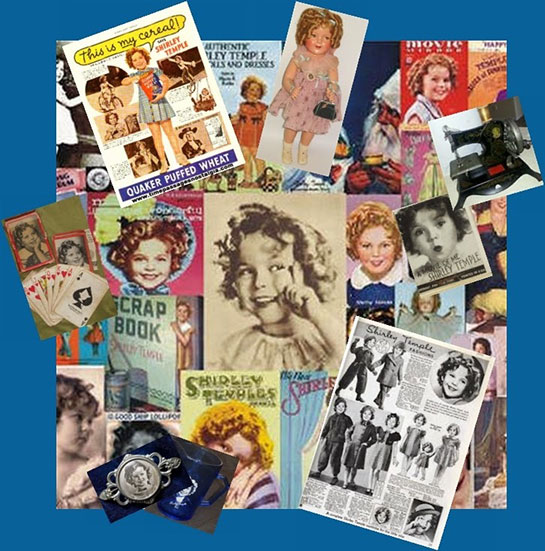
Such popularity did have its worrisome side, especially for Shirley’s parents; the kidnapping of the Lindbergh baby was still news. Their concern would be borne out during a radio broadcast on Christmas Eve 1939, when a woman in the audience, unhinged by grief, pointed a gun at Shirley, determined to kill the body that she believed had stolen the soul of her own dead daughter; the danger passed when the woman was seized and disarmed by two FBI agents who had been alerted to her suspicious presence. But that’s getting ahead of my story. For now, in 1935, the studio engaged burly John Griffith to serve as Shirley’s chauffeur and bodyguard (Shirley considered him a grown-up playmate). “Watch the kid like a hawk,” Zanuck told Griffith. “If anything happens to her, this studio might as well close up.”
The Littlest Rebel
(released December 19, 1935)
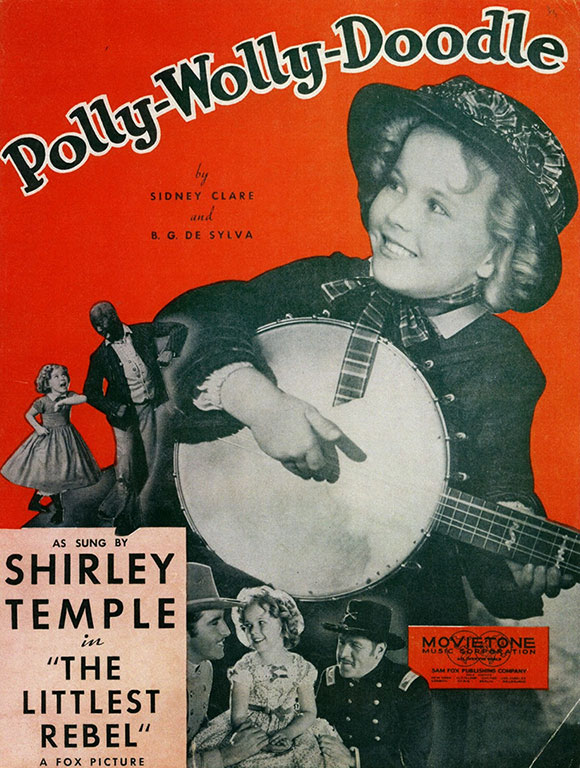 Shirley’s first picture to bear the new 20th Century Fox logo (with its now-famous fanfare) had been in the works before the merger, as the cover of this sheet music suggests. The ostensible source was a play by Edward Peple that ran for 55 performances on Broadway in the winter of 1911-12 before embarking on a long and prosperous tour, making a child star of the ill-fated Mary Miles Minter. The play had been filmed before in 1914, a version now presumed lost. (Playwright Peple, like The Little Colonel author Annie Fellows Johnston, did not live to see Shirley’s remake, having died of a heart attack in 1924, age 54.)
Shirley’s first picture to bear the new 20th Century Fox logo (with its now-famous fanfare) had been in the works before the merger, as the cover of this sheet music suggests. The ostensible source was a play by Edward Peple that ran for 55 performances on Broadway in the winter of 1911-12 before embarking on a long and prosperous tour, making a child star of the ill-fated Mary Miles Minter. The play had been filmed before in 1914, a version now presumed lost. (Playwright Peple, like The Little Colonel author Annie Fellows Johnston, did not live to see Shirley’s remake, having died of a heart attack in 1924, age 54.)But actually, that’s a bit of an overstatement. In fact, several of the characters’ names survived from stage to screen. Shirley plays Virginia Cary, a six-year-old resident of her namesake state whose birthday party is interrupted by news of the firing on Fort Sumter. Her father (John Boles) soon rides off to war, leaving the plantation in the hands of his wife (Karen Morley), little Virgie, and their loyal slaves, led by butler Uncle Billy (Bill Robinson) and his assistant James Henry (Willie Best). Late in the war, the Union Army sweeps through, and Virgie’s defiance earns the amused respect of Yankee Col. Morrison (Jack Holt). When Capt. Cary sneaks home to attend his wife’s deathbed and is captured, a sympathetic Morrison tries to help him and Virgie escape through Union lines, but father and daughter are caught and the two men are condemned to the firing squad — Capt. Cary for spying, Col. Morrison for aiding and abetting the enemy. Virgie and Uncle Billy rush to Washington, hoping to obtain a pardon from President Lincoln. I won’t say how this all turns out, but even if I did it would hardly amount to a surprise or a spoiler.
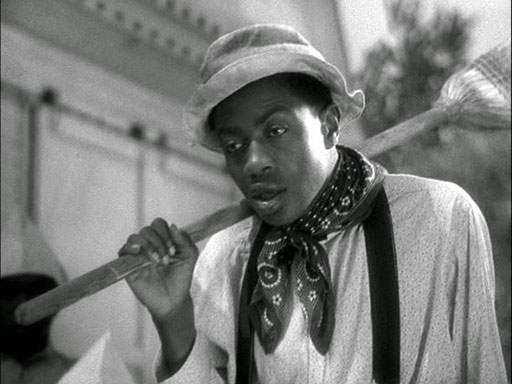 The Littlest Rebel was aimed at duplicating the success of The Little Colonel; in fact, it surpassed it, and was one of Shirley’s smoothest pictures. The only thing that really dates it today — and it dates it terribly — is the racial attitude I mentioned in my notes on The Little Colonel. That attitude is even more glaring and uncomfortable in The Littlest Rebel because the picture deals directly with the Civil War itself. When Edward Peple wrote his play in 1914, the war was well within human memory; even by the time the movie was made, that generation had not yet passed away (three years later, in 1938, the 75th anniversary of the battle of Gettysburg would occasion a reunion of nearly 1,900 Civil War veterans). The Old South with its genteel planter aristocracy and loyal, happy, contented slaves was an article of faith in the Myth of the Lost Cause, one that died hard and bitterly, and it’s on full display in The Littlest Rebel. It’s difficult to argue with modern viewers who find it just too hard to take. (Shirley even plays one scene in blackface disguise, though at least we are spared the sorry spectacle of hearing her speak with a “darkie” accent.)
The Littlest Rebel was aimed at duplicating the success of The Little Colonel; in fact, it surpassed it, and was one of Shirley’s smoothest pictures. The only thing that really dates it today — and it dates it terribly — is the racial attitude I mentioned in my notes on The Little Colonel. That attitude is even more glaring and uncomfortable in The Littlest Rebel because the picture deals directly with the Civil War itself. When Edward Peple wrote his play in 1914, the war was well within human memory; even by the time the movie was made, that generation had not yet passed away (three years later, in 1938, the 75th anniversary of the battle of Gettysburg would occasion a reunion of nearly 1,900 Civil War veterans). The Old South with its genteel planter aristocracy and loyal, happy, contented slaves was an article of faith in the Myth of the Lost Cause, one that died hard and bitterly, and it’s on full display in The Littlest Rebel. It’s difficult to argue with modern viewers who find it just too hard to take. (Shirley even plays one scene in blackface disguise, though at least we are spared the sorry spectacle of hearing her speak with a “darkie” accent.)
So: The Littlest Rebel has Willie Best’s James Henry to neutralize (if not nullify) the humanity of Bill Robinson’s Uncle Billy — rather than complement and reinforce it, as Hattie McDaniel’s Mom Beck had done in The Little Colonel. Plus a slave population so happy in bondage that they have no interest in emancipation and don’t even understand what it is. With all that, it’s not surprising that many viewers prefer not to watch the picture today — much less show it to children who can’t place it in its proper historical context.
Variety’s reviewer “Land” pegged The Littlest Rebel exactly, noting its striking similarity to The Little Colonel, yet conceding that it probably “won’t dampen the enthusiasm of the Temple worshippers…All bitterness and cruelty has been rigorously cut out and the Civil War emerges as a misunderstanding among kindly gentlemen with eminently happy slaves and a cute little girl who sings and dances through the story…Story is synthetic throughout but smart showmanship instills the illusion of life.” In the New York Times, Andre Sennwald agreed: “You may have got the mistaken notion from ‘So Red the Rose’ [a Civil War melodrama released the month before] that the war between the States was filled with ruin, death, rebellious slaves and horrid Yankee barbarians. ‘The Littlest Rebel’ corrects that unhappy thought and presents the conflict as a decidely chummy little war…As Uncle Billy, the faithful family butler, Bill Robinson is excellent, and some of the best moments in ‘The Littlest Rebel’ are those in which he breaks into song and dance with Mistress Temple.”
Captain January
(released April 24, 1936)
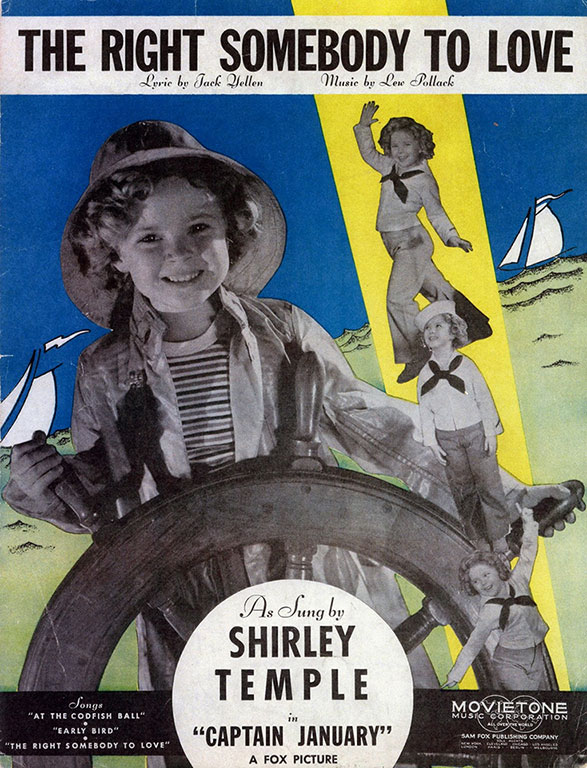 Captain January seems to have a special place in the hearts of Baby Boomers of a Certain Age, perhaps because it was one of Shirley Temple’s first features to go into television syndication in the 1950s. The source material was an 1891 novella by Laura E. Richards. Born Laura Elizabeth Howe in 1850, Mrs. Richards was the daughter of Julia Ward Howe, author of “The Battle Hymn of the Republic”. A prolific author in her own right, Mrs. Richards wrote over 90 books, including, with her sister Maud Howe Elliott, a biography of their mother that won them a Pulitzer Prize in 1917. Mrs. Richards also wrote the children’s nonsense poem “Eletelephony” (“Once there was an elephant,/Who tried to use the telephant –/No! No! I mean an elephone,/Who tried to use the telephone…”). Unlike the authors of The Little Colonel and The Littlest Rebel, she lived long enough to see two movies made from her modest little story, dying in 1943 at 92. Whether she saw either movie, or what she thought of them, is not recorded.
Captain January seems to have a special place in the hearts of Baby Boomers of a Certain Age, perhaps because it was one of Shirley Temple’s first features to go into television syndication in the 1950s. The source material was an 1891 novella by Laura E. Richards. Born Laura Elizabeth Howe in 1850, Mrs. Richards was the daughter of Julia Ward Howe, author of “The Battle Hymn of the Republic”. A prolific author in her own right, Mrs. Richards wrote over 90 books, including, with her sister Maud Howe Elliott, a biography of their mother that won them a Pulitzer Prize in 1917. Mrs. Richards also wrote the children’s nonsense poem “Eletelephony” (“Once there was an elephant,/Who tried to use the telephant –/No! No! I mean an elephone,/Who tried to use the telephone…”). Unlike the authors of The Little Colonel and The Littlest Rebel, she lived long enough to see two movies made from her modest little story, dying in 1943 at 92. Whether she saw either movie, or what she thought of them, is not recorded.
Mrs. Richards’s Captain January is a short-and-bittersweet tale of a retired old seafarer, one Januarius Judkins (“Captain January”), who lives alone tending a lighthouse on a small island off the rugged coast of Maine.
One night during a terrible storm he sees a ship founder in the rocky sea around his island. Venturing out in search of possible survivors, he finds only one, an infant girl clutched in her dead mother’s arms. He retrieves the child and several corpses, including both the baby’s parents. The anonymous dead he gives a decent burial on his island, the orphan girl he takes to shelter in his lighthouse. The next day a trunkfull of clothing belonging to the infant’s mother washes up on shore, but it contains no hint of the dead parents’ identities beyond some embroidered initials. With no way of knowing the baby’s name or family, he raises the girl himself, naming her Star Bright.
Ten years later, a woman on a passing cruise ship catches a glimpse of Star and is convinced she is the daughter of her dead sister, lost at sea with her husband and child while sailing home from Europe ten years earlier. It’s soon established beyond doubt that Star is Isabel Maynard, the long lost and presumed dead niece of that cruise ship passenger, Mrs. Morton. At first, Mrs. Morton wishes to take the girl to live with her, with full gratitude to Captain January for rescuing and raising her. But when she sees how it will break the hearts of both Star and the captain, she relents, and lovingly leaves the girl with the only father she’s ever known.
Even so, Captain January knows that his days on earth are nearly done, and he arranges with his friend, sailor Bob Peet, to keep an eye on the lighthouse whenever he sails by: If the little blue flag is flying, all is well; if the flag has been struck, it’s time for Bob to come and collect Star, and to take her to live with the Mortons, who will welcome her as one of their own — which in fact she is. Finally, in the spring of the following year, January feels his heart failing, and with his last ounce of strength he hauls down the little flag, then returns to his favorite chair to wait. “For Captain January’s last voyage is over, and he is already in the haven where he would be.”
Both Abel Green in Variety and Frank S. Nugent in the New York Times found Captain January to be “okay film fare” (Green) despite the “moss-covered script” (Nugent). One of the most interesting reviews came from across the Pond, where Graham Greene, writing in the London Spectator, found the picture to be “a little depraved, with an appeal interestingly decadent…Shirley Temple acts and dances with immense vigor and assurance, but some of her popularity seems to rest on a coquetry quite as mature as Miss [Claudette] Colbert’s, and on an oddly precocious body, as voluptuous in grey flannel trousers as Miss [Marlene] Dietrich’s.” Greene would pursue that line of thought in subsequent reviews, and would in time catch the gimlet eye of 20th Century Fox’s legal department. But I’ll get to that in its turn.
For the record, just in case you’ve lost track, Shirley was now seven years old; her eighth birthday was the day before Captain January opened in New York. Of course, hardly anybody besides her parents knew that; the rest of the world — including Shirley herself — thought she had just turned seven.
Next time: Fox’s top two female stars go head-to-head.
To be continued…
Shirley Temple Revisited, Part 8
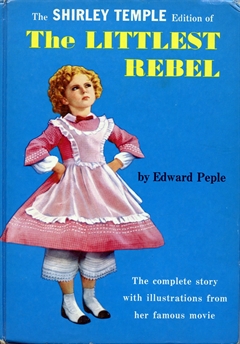
Since I last posted on The Littlest Rebel I’ve had a chance to examine both Edward Peple’s play and novel of that title (both were copyrighted in 1911, so it’s impossible, without input from Mr. Peple’s heirs and descendants, to know whether the play was based on the novel or vice versa). It’s clear that Variety’s reviewer “Land” misspoke when he said there was “no trace” of Peple’s play in Edwin J. Burke’s script. In fact, Burke followed Peple’s broad outline quite faithfully, making such changes as the passage of 25 years and the talent on hand would call for. The stagebound bombast of the play’s dialogue is purged entirely, as is the “colored” humor that was hopelessly dated by 1935 (albeit replaced with humor that looks equally dated to us today). In the play, Virgie saves her father from the firing squad by appealing for clemency to Gen. U.S. Grant; having her appeal to President Lincoln in the movie was an obvious improvement. And, of course, song-and-dance opportunities were inserted for Shirley and Bill Robinson because it would have been plainly stupid not to do so.
“Land” was being either forgetful, ignorant or unjust. If he wanted to see a movie that really had no trace of its original source, he need only have waited for the picture that 20th Century Fox hustled Shirley into immediately after shooting wrapped on Captain January.
Poor Little Rich Girl
(released June 25, 1936)
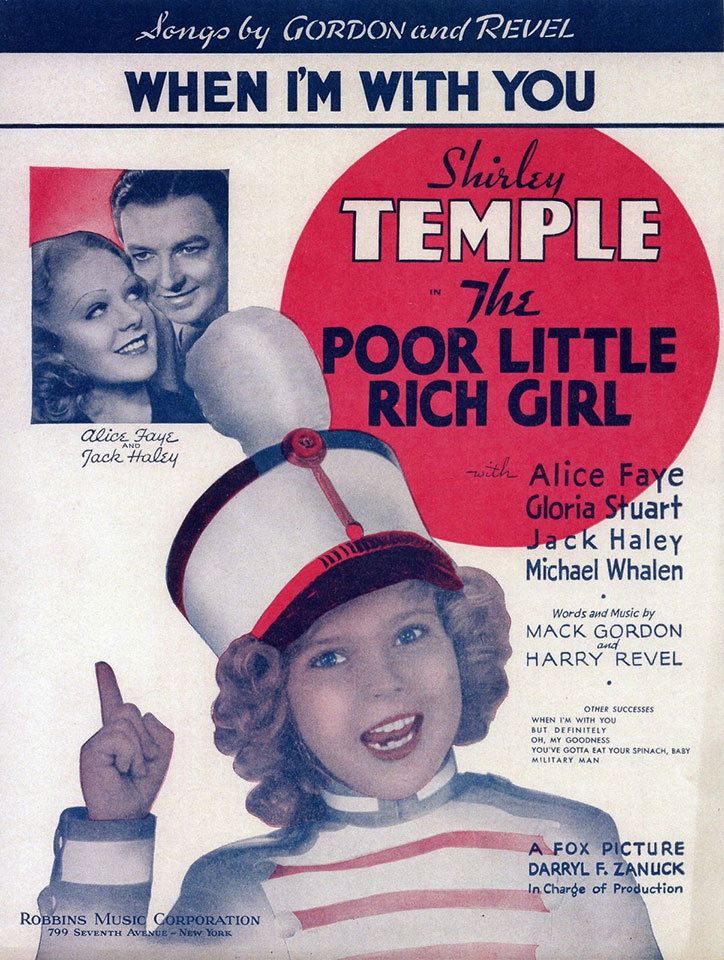 Don’t be misled by the picture’s title as it appears on the cover of the sheet music below (and on several of the posters and lobby cards); the title was Poor Little Rich Girl, with no “The“. Poor Little Rich Girl has a distinction it shares with Our Little Girl: They are the only two pictures from Shirley’s reign as Fox’s box-office queen (before and after the merger) that are not available on DVD; both can be seen only on out-of-print colorized VHS tapes.
Don’t be misled by the picture’s title as it appears on the cover of the sheet music below (and on several of the posters and lobby cards); the title was Poor Little Rich Girl, with no “The“. Poor Little Rich Girl has a distinction it shares with Our Little Girl: They are the only two pictures from Shirley’s reign as Fox’s box-office queen (before and after the merger) that are not available on DVD; both can be seen only on out-of-print colorized VHS tapes.While waiting for the car to take them to the station, Barbara asks Collins what she’ll do while Barbara’s away at school.”I’m going to take a little vacation,” Collins tells her. Barbara asks what a vacation is. “It’s a rest, dear. It means getting away from people you’ve been with every day and seeing new faces. You really become another person on a vacation.”
The words leave a fateful impression on Barbara. When they get to the station, Collins stops to send a telegram telling the school that Barbara is on her way. That’s when she misses her purse; she must have dropped it as she got out of the car. She tells Barbara to wait, and rushes outside to search. There she’s run down by a car and winds up in the hospital, unconscious and unidentified.
Meanwhile, back in the station, Barbara gets tired of waiting and decides to take a “little vacation” of her own — and the “other person” she decides to become is Betsy Ware, an orphan in her favorite series of stories that Mrs. Woodward has been reading to her. In this guise she meets Jimmy Dolan and his wife Jerry (Jack Haley and Alice Faye), vaudevillians down on their luck and looking to break into radio. Taking little “Betsy” into their act, they rename her “Bonnie Dolan” and make the rounds as “Dolan, Dolan and Dolan” — and sure enough, before you can say “audition” they’ve landed starring spots on a radio show. On top of that, their show is sponsored by the Peck Soap Co., arch-competitor to Barry’s Beauty Soap, and little Barbara/Betsy/Bonnie has charmed the socks off cranky old Simon Peck (Claude Gillingwater), who had long vowed never to sponsor a radio program. All this happens within two days, while Barbara’s father, who assumes his daughter is safely ensconced at school in the Adirondacks, is romancing the Peck Soap Co.’s head of advertising (Gloria Stuart).
Well, all of this gets sorted out in time for a happy fadeout — that is, for everyone except poor Collins, the nursemaid, whom we last see comatose in the hospital while doctors puzzle over her identity, and who is never heard from again.
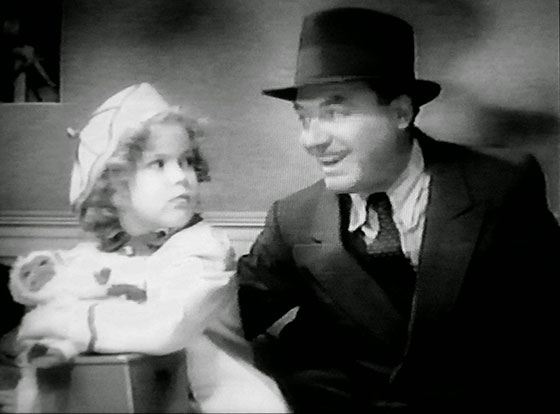
…and then, exactly the right touch: the dolls jump up and dance for her. The whole scene is a perfectly delightful expression of the loneliness of a friendless little girl, presented in song (by Shirley) and dance (by the dolls).
Other songs round out the musical program with variety and a satisfying range of styles. There are spoofs of commercial jingles in the ditties for the competing soap companies, “Buy a Bar of Barry’s” and “Wash Your Necks with a Cake of Peck’s”. A standard love song, “When I’m with You”, introduced by an unbilled Tony Martin at the very beginning of his career — and one year before his three-year marriage to Alice Faye. The song is then reprised by Barbara, singing to her father (and including the rather alarming line, “Marry me and let me be your wife.”). These and other songs, often heard in different forms in the background, on pianos, hand-organs and what-not, add to the varied musical texture of Poor Little Rich Girl.
Years later, Alice Faye shared her memories of Poor Little Rich Girl with her great fan W. Franklyn Moshier, author of the self-published The Films of Alice Faye (which was picked up by Stackpole Books in 1974 and published as The Alice Faye Movie Book), and Frank Moshier shared those memories with me when I knew him in the early ’70s. Evidently, Alice rankled at having to play second fiddle to this eight-year-old; according to Frank, she never talked about “Shirley”, it was always “that Temple child”. Alice told Frank, and Frank told me, stories of Shirley throwing tantrums on the set — red-faced, stomping, screaming “Miss Faye pushed me! Miss Faye pushed me!” Frank had the good sense not to include such tales in The Films of Alice Faye, but he did assert that “while pure and wholesome in appearance and the darling of everyone from Key West to Puget Sound, Shirley was more than a little difficult to work with.”
Nonsense. I didn’t believe these stories in 1972 and I don’t believe them now. They simply fly in the face of everything — everything — that everybody else who ever worked with Shirley had to say about her. We can only speculate on what prompted such melodramatic yarns; both Shirley and Alice — and for that matter, Frank Moshier — are beyond asking about it now. In any event, Alice Faye was not through playing second fiddle to Shirley Temple. Within a very few months, she’d be doing it again.
To be continued…
Shirley Temple Revisited, Part 9
During shooting on Poor Little Rich Girl, director Irving Cummings drew Shirley’s mother aside and warned her that (as Shirley recalled it in Child Star) “the studio would have to find better stories for me; I had lost that baby quality and was getting an emotional understanding, ‘like Helen Hayes when she started.'” Cummings’s point was well taken, but like contract players at other studios, Shirley was at the mercy of the 20th Century Fox front office, and their interest was in keeping her a baby as long as possible. Certainly that was how they played it for her next picture.
Dimples
(released October 11, 1936)
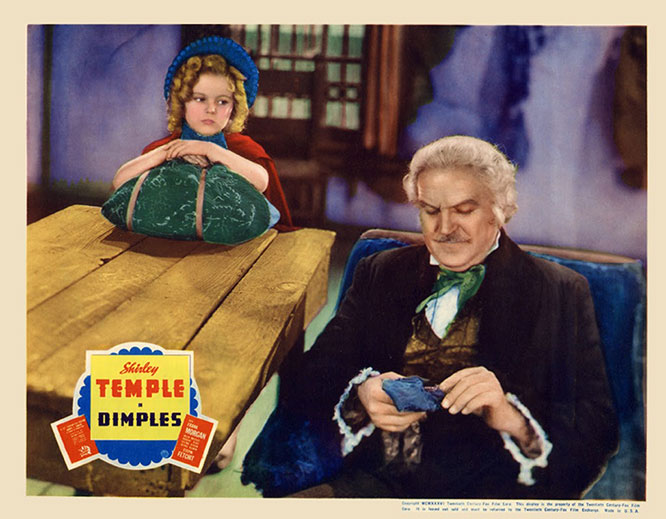 I’m going to pass over Dimples as quickly as duty will allow because, like Now and Forever, it’s a bit of a dud, and for similar reasons. The setting is New York in 1850; Shirley plays Chalvia Dolores Appleby, known by all as “Dimples”. As in Now and Forever, she’s the child of an unregenerate grifter, only this time it’s not her father but her grandfather, “Professor” Eustace Appleby (Frank Morgan). The Professor calls himself a music teacher of “the Pianoforte, the Bugle, the Melodion, the Drum, also Bird Calls”, but mainly he just stands in the crowd shilling while Dimples and his other “students” sing, dance and play their instruments in the streets. Then he starts the contributions when Dimples passes the hat and, while other bystanders are dropping coins in, he works the crowd picking pockets. In another similarity to Now and Forever, Dimples catches the eye of wealthy old Mrs. Drew (Helen Westley), who wants to lift her out of the Bowery poverty in which she lives with the Professor. At the same time, Mrs. Drew becomes estranged from her nephew Allen (Robert Kent) when he becomes romantically involved with (gasp!) an actress whom he decides to star in a production of Uncle Tom’s Cabin — in which he later hires Dimples to play Little Eva.
I’m going to pass over Dimples as quickly as duty will allow because, like Now and Forever, it’s a bit of a dud, and for similar reasons. The setting is New York in 1850; Shirley plays Chalvia Dolores Appleby, known by all as “Dimples”. As in Now and Forever, she’s the child of an unregenerate grifter, only this time it’s not her father but her grandfather, “Professor” Eustace Appleby (Frank Morgan). The Professor calls himself a music teacher of “the Pianoforte, the Bugle, the Melodion, the Drum, also Bird Calls”, but mainly he just stands in the crowd shilling while Dimples and his other “students” sing, dance and play their instruments in the streets. Then he starts the contributions when Dimples passes the hat and, while other bystanders are dropping coins in, he works the crowd picking pockets. In another similarity to Now and Forever, Dimples catches the eye of wealthy old Mrs. Drew (Helen Westley), who wants to lift her out of the Bowery poverty in which she lives with the Professor. At the same time, Mrs. Drew becomes estranged from her nephew Allen (Robert Kent) when he becomes romantically involved with (gasp!) an actress whom he decides to star in a production of Uncle Tom’s Cabin — in which he later hires Dimples to play Little Eva.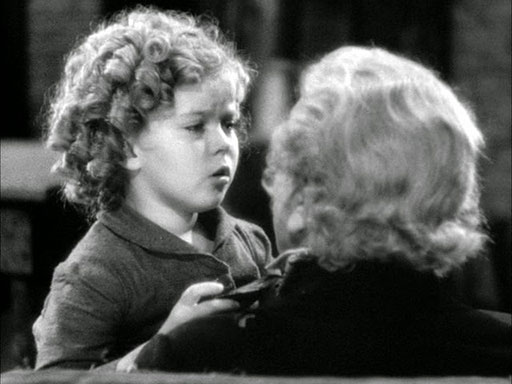 In Child Star Shirley remembered Frank Morgan’s tireless efforts to upstage her and steal focus during their scenes — fiddling with his cuffs, flourishing his handkerchief, placing his stovepipe hat on a table between her and the camera so that she couldn’t be in the shot without stepping off her mark and out of the light. (“Both of us knew perfectly well what he was doing. There was no way I could cope, short of biting at his fingers.”) Director William A. Seiter was on to Morgan’s tricks too; in this scene, where Dimples sings “Picture Me Without You” (one of four pleasantly forgettable songs provided by Jimmy McHugh and Ted Koehler), Seiter made Morgan sit in a chair with his back to the camera. (“When this picture is over,” cracked producer Nunnally Johnson, “either Shirley will have acquired a taste for Scotch whiskey or Frank will come out with curls.”)
In Child Star Shirley remembered Frank Morgan’s tireless efforts to upstage her and steal focus during their scenes — fiddling with his cuffs, flourishing his handkerchief, placing his stovepipe hat on a table between her and the camera so that she couldn’t be in the shot without stepping off her mark and out of the light. (“Both of us knew perfectly well what he was doing. There was no way I could cope, short of biting at his fingers.”) Director William A. Seiter was on to Morgan’s tricks too; in this scene, where Dimples sings “Picture Me Without You” (one of four pleasantly forgettable songs provided by Jimmy McHugh and Ted Koehler), Seiter made Morgan sit in a chair with his back to the camera. (“When this picture is over,” cracked producer Nunnally Johnson, “either Shirley will have acquired a taste for Scotch whiskey or Frank will come out with curls.”)Just one more point about Dimples before we move on. In Child Star Shirley recalled filming Little Eva’s death scene (which she plays much the way a child actress in the 1850s would probably have done it), and actor Paul Stanton, as Eva’s grieving father, sobbing so broadly that he shook the bed she was lying on. However, Shirley transplanted the recollection from Dimples to The Little Colonel the year before, and she identified her over-emoting stage father as John Lodge, who played her “real” father in that picture. Such are the occasional vagaries of even the most reliable memory.
Stowaway
(released December 18, 1936)
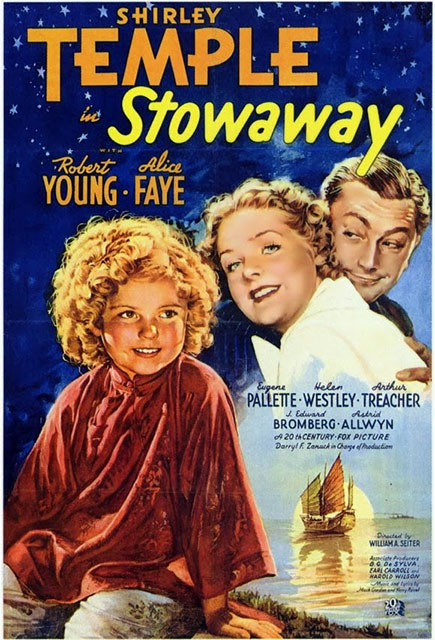 Stowaway gave Shirley an exotic setting, a story that didn’t require her to carry the show all by herself, and cast-mates who were strong enough to share the load. Shirley played Barbara Stewart, nicknamed “Ching-Ching”, the orphaned daughter of missionaries in Sanchow, China. At the approach of bandits from the hills, she’s about to be orphaned again — or worse — because her guardians the Kruikshanks (also missionaries) refuse to flee from the approaching marauders. Defying them, the wise local magistrate Sun Lo (Philip Ahn) spirits Ching-Ching away with a boatman to Shanghai.
Stowaway gave Shirley an exotic setting, a story that didn’t require her to carry the show all by herself, and cast-mates who were strong enough to share the load. Shirley played Barbara Stewart, nicknamed “Ching-Ching”, the orphaned daughter of missionaries in Sanchow, China. At the approach of bandits from the hills, she’s about to be orphaned again — or worse — because her guardians the Kruikshanks (also missionaries) refuse to flee from the approaching marauders. Defying them, the wise local magistrate Sun Lo (Philip Ahn) spirits Ching-Ching away with a boatman to Shanghai.
But upon arrival, the boatman robs the sleeping Ching-Ching and disappears, leaving her to wander the city alone. That’s how she meets Tommy Randall (Robert Young, on loan from MGM), a wandering American playboy. After their encounter, the girl falls asleep in the rumble seat of Tommy’s automobile while he goes roaring off on a drunk with another wealthy globetrotter (Eugene Pallette). Tommy’s valet Atkins (Arthur Treacher) tracks his employer from bar to bar and manages to get him aboard their departing ship safe and (reasonably) sound, along with Tommy’s auto — and, unbeknownst to all, the sleeping Ching-Ching.
When the befuddled Ching-Ching awakens the next morning, she’s immediately spotted for a stowaway and chased from deck to deck. She takes refuge in the stateroom of Susan Parker (Alice Faye) and Susan’s future mother-in-law Mrs. Hope (Helen Westley), on their way to Bangkok to join Susan’s intended. Before long, Ching-Ching is reunited with her “Uncle” Tommy; for his part, Tommy agrees to stand good for the child’s passage until her guardians can be contacted. Also, even through his pounding hangover, he can see that Susan is the most beautiful woman aboard ship. Susan’s eyes are clearer than his, but it’s plain to see that the attraction is mutual.
Well, we can all guess where this is headed, and sure enough it gets there — with a wise judge in Reno (J. Edward Bromberg) consulting with Ching-Ching before denying a divorce petition for probably the first time in the history of the State of Nevada.
Stowaway reunited Shirley with director William A. Seiter (and also with writer William Conselman, who had done so well by Shirley on Bright Eyes and The Little Colonel, writing this time with Arthur Sheekman and Nat Perrin, from a story by Samuel G. Engel). Without the odious Professor who blighted Dimples (and without Frank Morgan’s upstaging stunts), Seiter was able to do much better by Shirley, mainly by not forcing her to be the whole show.
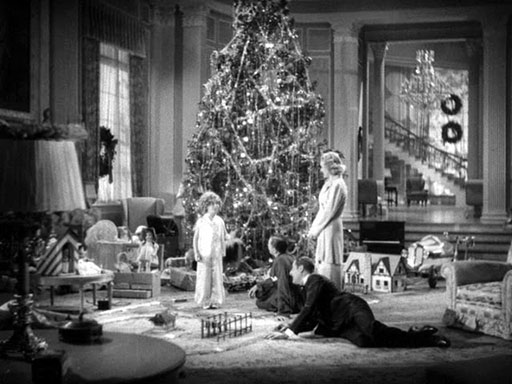 Alice also sang “One Never Knows, Does One?”, another one by Gordon and Revel, this time with no little-girl version for Shirley. Then Shirley closed out the show with “That’s What I Want for Christmas”, written by the uncredited Gerald Marks and Irving Caesar. This last number comes at the very end, after the story has been brought to a satisfying conclusion, and it plays almost like a curtain-call encore. Evidently it was added at the last minute to exploit the movie’s holiday engagement at New York’s Roxy picture palace (it didn’t sift down to the rest of the country until after the turn of 1937).
Alice also sang “One Never Knows, Does One?”, another one by Gordon and Revel, this time with no little-girl version for Shirley. Then Shirley closed out the show with “That’s What I Want for Christmas”, written by the uncredited Gerald Marks and Irving Caesar. This last number comes at the very end, after the story has been brought to a satisfying conclusion, and it plays almost like a curtain-call encore. Evidently it was added at the last minute to exploit the movie’s holiday engagement at New York’s Roxy picture palace (it didn’t sift down to the rest of the country until after the turn of 1937).
To be continued…
Shirley Temple Revisited, Part 10
On July 30, 1936 there was a story conference on what would become Shirley’s next picture after Stowaway. At that conference, according to notes published in Rudy Behlmer’s Memo from Darryl F. Zanuck, the Fox studio chief said:
I feel the only way to make this story is to disregard the formula of all the previous pictures Shirley Temple has appeared in to date…My idea…is to forget that it is a Shirley Temple picture. That is, not to forget that she is the star, but to write the story as if it were a Little Women or a David Copperfield…All the hokum must be thrown out. The characters must be made real, human, believable. Only then can we get a powerful, real story.
The role must be written for Shirley as an actress, and nothing sloughed over because Shirley is in it and therefore it will be good. We don’t want to depend on any of her tricks. She should not be doing things because she is Shirley Temple, but because the situations — sound and believable — call for them. In other words, write a role and let Shirley adapt herself to the picture.
This conference took place almost a full year before the picture was released. Without checking studio archives, we can’t be sure if Zanuck had already assigned a director, but given his determination to disregard the Shirley Temple formula, he probably had. In any case, the assignment went to John Ford, whom Zanuck had under non-exclusive contract. Ford had been directing since 1917, had already won the first of his four Oscars for The Informer at RKO, and was on the threshold of his own personal Golden Age, which would extend into the 1960s. According to Ford biographer Scott Eyman, Ford gave two accounts of his reaction to being assigned a Shirley Temple picture. In the one Eyman finds more likely, Ford said “my face fell atop the floor.” In the other, more consistent with the director’s self-image as a no-nonsense moviemaker, “I said ‘Great’ and we just went out and made the picture.”
Wee Willie Winkie
(released July 23, 1937)
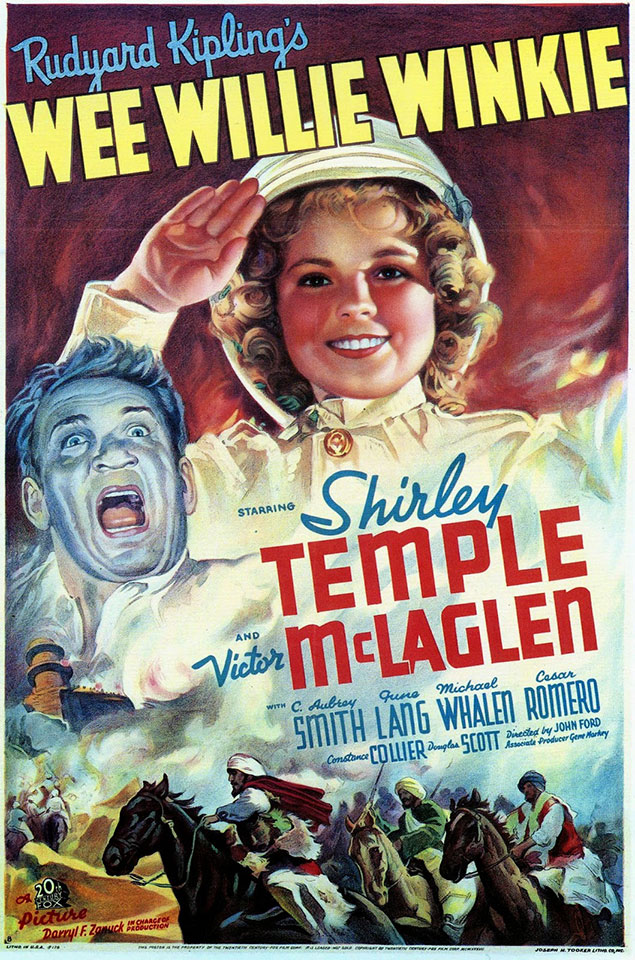 Calling the picture “Rudyard Kipling’s” Wee Willie Winkie was a bit of an overstatement. The original story was published in 1888, when the future Nobel Prize winner was 22. It told of Percival William Williams, the six-year-old son of an army colonel stationed with his regiment in British India at the foot of the Khyber Pass on the indistinct border with Afghanistan. Percival has a penchant for nicknaming people, including himself, so he has adopted the name Wee Willie Winkie from one of his nursery-books. Winkie is bright but typically mischievous for a boy his age, and under the military discipline imposed by his father he is forever earning, then forfeiting, a succession of Good Conduct Badges.
Calling the picture “Rudyard Kipling’s” Wee Willie Winkie was a bit of an overstatement. The original story was published in 1888, when the future Nobel Prize winner was 22. It told of Percival William Williams, the six-year-old son of an army colonel stationed with his regiment in British India at the foot of the Khyber Pass on the indistinct border with Afghanistan. Percival has a penchant for nicknaming people, including himself, so he has adopted the name Wee Willie Winkie from one of his nursery-books. Winkie is bright but typically mischievous for a boy his age, and under the military discipline imposed by his father he is forever earning, then forfeiting, a succession of Good Conduct Badges.
One soldier that Winkie takes a particular shine to is Lt. Brandis, whom he nicknames “Coppy” for his copper-colored hair. His affection for Coppy is so great that when he sees Coppy “vehemently kissing” the daughter of one Major Allardyce he keeps the secret to himself.
Shortly thereafter, for yet another infraction, Winkie once more loses his Good Conduct Badge and is “confined to quarters under arrest” — what a later generation would call “grounded”. But when he sees Coppy’s Miss Allardyce, in a fit of willful independence, riding out beyond the river where all are forbidden to go, Winkie breaks arrest and rides after her on his little pony.
He catches up only when her own horse stumbles and throws her, twisting her ankle so that she cannot stand. She pleads with him to ride back to the post for help. But Winkie has been taught that “a man must always look after a girl”, and when he sees men approaching from the hills — bandits, perhaps, or worse — he dismounts and whips his pony, sending it galloping home without its rider. When the natives come across the boy and the injured young woman, they begin mulling over whether to take them hostage for ransom.
Winkie bravely stands up to them, to their great amusement, ordering them to send to the post for help. One of the natives, a former groom at the post, warns his fellows that disturbing these two will only be asking for trouble, and the debate among them goes on long enough for Winkie’s pony to reach home and for the alarm to be sounded. As the regiment rides to the rescue, the Afghans see the approaching soldiers and prudently melt back into the hills. Winkie and Miss Allardyce are brought back to the post, where Winkie is hailed as “a pukka hero”; his breaking arrest is forgiven, and he even regains his Good Conduct Badge.
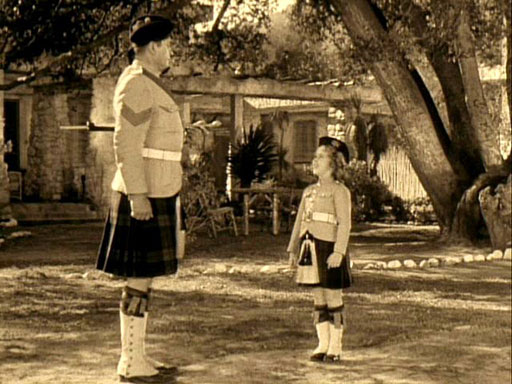 Needless to say, in Ernest Pascal and Julien Josephson’s screenplay nearly all of this was changed. Percival was changed to Priscilla and given a widowed American mother (June Lang). The colonel backs up a generation, becoming Priscilla’s grandfather (C. Aubrey Smith), who sends for Priscilla and her mother when he learns they are living in poverty in America. Priscilla is still nicknamed Wee Willie Winkie, but her military discipline is self-imposed in an effort to become a soldier, since that seems to be the only type of person her grandfather the colonel likes. “Private” Winkie still takes a shine to Lt. “Coppy” Brandis (Michael Whalen, Shirley’s father in Poor Little Rich Girl), but he throws over Maj. Allardyce’s daughter to romance Winkie’s mother. While he’s doing that, Coppy’s duties as Winkie’s best friend among the soldiery devolve onto a new character, Sergeant MacDuff (Victor McLaglen).
Needless to say, in Ernest Pascal and Julien Josephson’s screenplay nearly all of this was changed. Percival was changed to Priscilla and given a widowed American mother (June Lang). The colonel backs up a generation, becoming Priscilla’s grandfather (C. Aubrey Smith), who sends for Priscilla and her mother when he learns they are living in poverty in America. Priscilla is still nicknamed Wee Willie Winkie, but her military discipline is self-imposed in an effort to become a soldier, since that seems to be the only type of person her grandfather the colonel likes. “Private” Winkie still takes a shine to Lt. “Coppy” Brandis (Michael Whalen, Shirley’s father in Poor Little Rich Girl), but he throws over Maj. Allardyce’s daughter to romance Winkie’s mother. While he’s doing that, Coppy’s duties as Winkie’s best friend among the soldiery devolve onto a new character, Sergeant MacDuff (Victor McLaglen).“The owners of a child star are like leaseholders — their property diminishes in value every year…Miss Shirley Temple’s case, though, has peculiar interest: Infancy is her disguise, her appeal is more secret and more adult. Already two years ago she was a fancy little piece (real childhood, I think, went out after The Littlest Rebel). In Captain January she wore trousers with the mature suggestiveness of a Dietrich: her neat and well-developed rump twisted in the tap-dance: her eyes had a sidelong searching coquetry. Now in Wee Willie Winkie, wearing short kilts, she is completely totsy. Watch her swaggering stride across the Indian barrack-square: hear the gasp of excited expectation from her antique audience when the sergeant’s palm is raised: watch the way she measures a man with agile studio eyes, with dimpled depravity. Adult emotions of love and grief glissade across the mask of childhood, a childhood skin-deep.
“It is clever, but it cannot last. Her admirers — middle-aged men and clergymen — respond to her dubious coquetry, to the sight of her well-shaped and desirable little body, packed with enormous vitality, only because the safety curtain of story and dialogue drops between their intelligence and their desire.”
Greene closed out with a left-handed compliment, noting that the story was “a long way after Kipling. But we needn’t be sour about that. Both stories are awful, but on the whole Hollywood’s is the better.”
Fox was less than mollified; they sued for libel, charging that Greene had accused the studio of “procuring” Shirley “for immoral purposes”. Greene fled to Mexico, and the British court found for the plaintiffs, ordering damages of 3,500 pounds sterling, 500 of it to come from Greene personally. (The amount of the judgment was about $17,500 at the time; multiply by 20 to get an approximation of the amount in today’s dollars.) From Mexico Greene wrote his Night and Day colleague Elizabeth Bowen: “I found a cable waiting for me in Mexico City asking me to agree to apologise to that little bitch Shirley Temple — so I suppose the case has now been settled with the maximum publicity.” In Child Star Shirley wrote about the dust-up with some amusement, noting that at the time the whole thing had gone pretty much over her head.
Students of Graham Greene’s prose have spent decades parsing Greene’s review, digging for his intent. Some say he was kidding (“Shirley Temple = Marlene Dietrich? Seriously?”), others that he was satirizing Shirley’s handlers or her audience. Still others contend that Greene was obviously right, that the sexualization of Shirley Temple on Fox’s part was conscious and deliberate (“I’m obsessed with sex?? You’re the one showing me all these dirty pictures!”). Personally, I won’t weigh in on all that — except to say that very often, a review tells us more about the reviewer than it does about the work under discussion.
In any event, other reviews were more circumspect, if hardly more complimentary. The New Yorker’s John Mosher, sniffy as ever, sniffed, “Miss Temple’s talent is rather overexploited at times, and she seems just a bit too pert. Mr. Kipling’s children were never allowed to take over the platform in quite this fashion.” Variety’s “Flin” liked the picture well enough, but tempered his opinion (as Variety often did) with marketing advice, saying that “as a roadshow attraction at advanced admission prices, ‘Winkie’ is too long for the continuous type of film theatres. Temple is boxoffice dynamite because of the kids who flock to see her, but youngsters can’t sit still for an hour and three-quarters. They’re squirming all over the place; however, reducing footage for general exhibition will be easy. It also is essential.” And the New York Times’s Frank S. Nugent ended his cease-fire, which had begun with Stowaway: “The picture, on its unassuming and frankly sentimental surface, is a pleasing enough little fiction, sure to delight every Temple addict and likely to win the grudging approval even of those who, like myself, are biding their time until she grows up, becomes gawky and is a has-been at 15.”
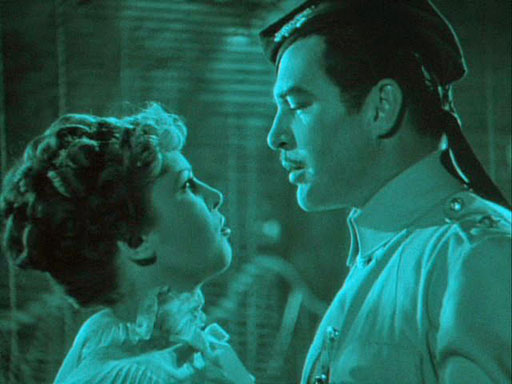 Seen today, Wee Willie Winkie bears out Shirley’s opinion more than it does Mosher’s, Flin’s or Nugent’s. The picture is certainly not too long. Children may squirm during the protracted love scenes between Michael Whalen and June Lang, but so do adults. Both were bland Fox contract players on an unstoppable career path toward B pictures and, at the onset of middle age, television. Whalen’s dark good looks were about to be rendered irrelevant by the rise of the far more charismatic Tyrone Power. As for Lang (Shirley’s “mother” was only 11 years older than she was), within seven years she would be a nameless, uncredited “Goldwyn Girl” behind Danny Kaye in Up in Arms, and would finish her career with one-off guest shots on TV cop shows in the ’50s and ’60s. Whalen and Lang were (and remain) attractive and inoffensive, but they lack the chemistry — with either the audience or each other — that Robert Young and Alice Faye showed in Stowaway, or Faye and Jack Haley in Poor Little Rich Girl. (The blue-green of this frame-cap, like the sepia of others, reproduces the tinted stock Wee Willie Winkie sported on its original release.)
Seen today, Wee Willie Winkie bears out Shirley’s opinion more than it does Mosher’s, Flin’s or Nugent’s. The picture is certainly not too long. Children may squirm during the protracted love scenes between Michael Whalen and June Lang, but so do adults. Both were bland Fox contract players on an unstoppable career path toward B pictures and, at the onset of middle age, television. Whalen’s dark good looks were about to be rendered irrelevant by the rise of the far more charismatic Tyrone Power. As for Lang (Shirley’s “mother” was only 11 years older than she was), within seven years she would be a nameless, uncredited “Goldwyn Girl” behind Danny Kaye in Up in Arms, and would finish her career with one-off guest shots on TV cop shows in the ’50s and ’60s. Whalen and Lang were (and remain) attractive and inoffensive, but they lack the chemistry — with either the audience or each other — that Robert Young and Alice Faye showed in Stowaway, or Faye and Jack Haley in Poor Little Rich Girl. (The blue-green of this frame-cap, like the sepia of others, reproduces the tinted stock Wee Willie Winkie sported on its original release.)
To be continued…
Shirley Temple Revisited, Part 11
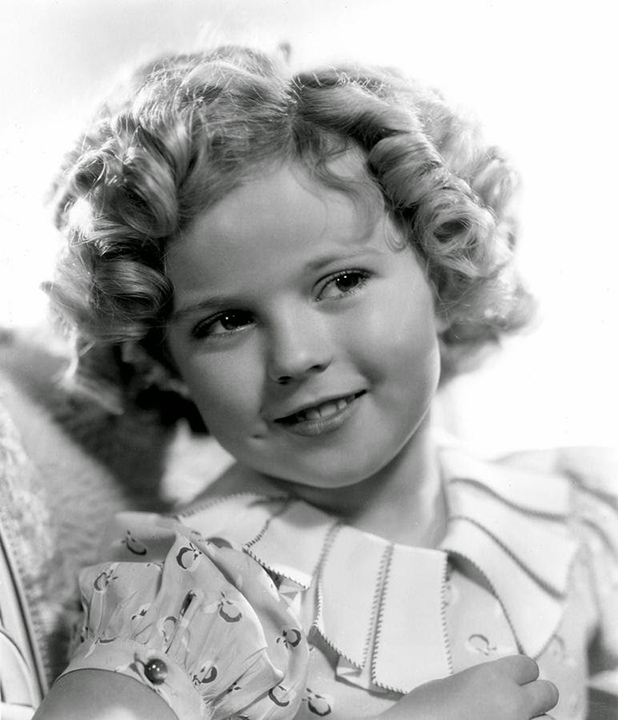 So far we’ve taken Shirley up to the middle of 1937. She’s been Hollywood’s top box-office star for two years, and she’ll go on to be for two years more. This is probably a good time to deal with one of Hollywood’s most persistent and tantalizing legends: Is it true that Shirley Temple was originally set to play Dorothy in The Wizard of Oz? The short answer is: No, but there may be a complicated grain of truth to the legend. In fact, given Shirley’s stature in the industry during the mid-to-late 1930s, it’s unlikely that there wouldn’t be something to it.
So far we’ve taken Shirley up to the middle of 1937. She’s been Hollywood’s top box-office star for two years, and she’ll go on to be for two years more. This is probably a good time to deal with one of Hollywood’s most persistent and tantalizing legends: Is it true that Shirley Temple was originally set to play Dorothy in The Wizard of Oz? The short answer is: No, but there may be a complicated grain of truth to the legend. In fact, given Shirley’s stature in the industry during the mid-to-late 1930s, it’s unlikely that there wouldn’t be something to it.
First of all, before we go any further, dismiss from your mind any images of Shirley chirping her way through “Over the Rainbow” or pumping her fists and pouting that she wants to go home. Frankly, I suspect those are scare-images conjured up by Judy Garland’s more jealous fans, in that unique way they have of seeking to tear down anyone they see as a threat (Deanna Durbin, for example) — as if Judy needs that kind of help. If Shirley had made The Wizard of Oz, there would certainly have been no “Over the Rainbow”, and possibly no songs by Harold Arlen and E.Y. Harburg at all. The Wizard of Oz starring Shirley Temple would have been utterly and absolutely different — far more different, for example, than Gone With the Wind would have been if Paulette Goddard had played Scarlett rather than Vivien Leigh. Granted, it’s hard to imagine The Wizard of Oz being any better (though it’s not impossible: I do wish Buddy Ebsen had been able to stay on as the Tin Man). But that doesn’t mean it would have been any worse. Just different. In that alternate universe where Shirley played Dorothy, W.C. Fields played the Wizard, Buddy Ebsen played the Scarecrow and Edna May Oliver was the Wicked Witch of the West, it’s entirely possible that people there cherish their Wizard of Oz just as much as we do ours.
The most common form of the legend goes like this: In 1937, 20th Century Fox and MGM worked out a tentative star-swap. Fox would get the services of Clark Gable and Jean Harlow to star in a picture called Mrs. O’Leary’s Cow about the Chicago Fire of 1871; in return, MGM would get Shirley to play Dorothy in Oz and to co-star in another picture with Gable. But when Harlow died suddenly in June 1937 the whole deal was off; Fox made their picture, now called In Old Chicago, with Tyrone Power and Alice Faye, and MGM didn’t get Shirley.
The story is interesting, with an appealing for-the-want-of-a-nail quality to it. Henry King, the man who eventually directed In Old Chicago, told it once in print (I recall reading it, but have been unable to remember or track down where), and Shirley repeats it in Child Star. But the story doesn’t really fit the facts. At the time of Harlow’s death, the screen rights to The Wizard of Oz belonged not to MGM but to Samuel Goldwyn, who had purchased them in 1933 for $40,000.
Shirley gets another point wrong in Child Star when she talks about who might play “the role of fourteen-year-old Dorothy”; she actually more than doubles Dorothy’s probable age. In L. Frank Baum’s first Oz book Dorothy’s age isn’t mentioned, but W.W. Denslow’s illustrations show a girl of six or seven, and internal evidence in later Oz books suggests that that’s about right. In other words, Dorothy in The [original] Wizard of Oz is almost exactly the age of Shirley Temple at the height of her career at Fox. It may well be that around that time Darryl Zanuck tried to obtain the rights as a vehicle for his biggest star (wouldn’t you?), but aside from him there wouldn’t have been a lot of interest in the book. In any case the point was moot; Goldwyn wasn’t selling (what he though he was going to do with the property is anybody’s guess).
Then things changed on December 21, 1937 when Walt Disney’s Snow White and the Seven Dwarfs premiered at the Carthay Circle Theatre in Los Angeles. It was an immediate smash hit — and suddenly there was a renewed interest in making movies out of fairy tales. In The Making of The Wizard of Oz Aljean Harmetz quotes a New York Times story of February 19, 1938 telling how Goldwyn was suddenly besieged with offers to take Oz off his hands: “Twentieth Century-Fox [sic] is reported anxious to purchase the book for Shirley Temple, but all offers have been rejected.”
Then MGM made Goldwyn an offer he couldn’t refuse, and the deal was finalized on June 3, 1938: MGM bought the rights to The Wizard of Oz from Goldwyn for $75,000. Louis B. Mayer, Ms. Harmetz says, tried to borrow Shirley from Zanuck, but to no avail. (Shirley claims Zanuck made a counter-offer to buy the rights from Mayer, but I question her reliability on that point; she may have been reporting second- or third-hand studio gossip or wishful thinking. It seems to me that if Zanuck couldn’t offer Goldwyn enough to get the rights from him, he wasn’t likely to offer enough to MGM when the price was $35,000 higher.)
In later years Arthur Freed, who always inflated his role in producing The Wizard of Oz, insisted he intended all along for Judy Garland to play Dorothy — even saying he would have refused to make it with anybody else. We can dismiss that. Freed was only a songwriter in 1938 with no track record as a producer (and he got no screen credit on Oz). If Louis B. Mayer could bring Gene Kelly into his office in 1951 and tell him to make Singin’ in the Rain with Debbie Reynolds (a nobody), he’d have had no problem ordering Freed to make The Wizard of Oz with Shirley Temple whether he liked it or not. And Freed would have done as he was told; he got where he was by sucking up to L.B. (to be fair, he stayed where he was by producing one great and profitable musical after another for nearly 20 years).
So…sorting all this out, it strikes me that the bottom line is this: In the mid-1930s, if anybody ever gave a serious thought to remaking The Wizard of Oz (there had been two silent versions), the obvious and only possible choice to play Dorothy would have been Shirley Temple, and that very idea came up more than once. But for whatever reason, 20th Century Fox never got control of the property. Samuel Goldwyn, who owned it, seems never to have seriously considered filming it. Then in 1938, when MGM pried the rights loose from Goldwyn, they tried to borrow Shirley but couldn’t. As Aljean Harmetz correctly points out, if it had ever come to a serious showdown between Shirley and Judy Garland for the role, Judy would certainly have lost. Ergo, in this universe at least, it was never going to happen, Hollywood gossip and later tales notwithstanding. “Sometimes,” as Shirley said, “the gods know best.”
For the picture Shirley actually did make next, the question of rights was never an issue — the story had recently drifted into the public domain.
Heidi
(released November 5, 1937)
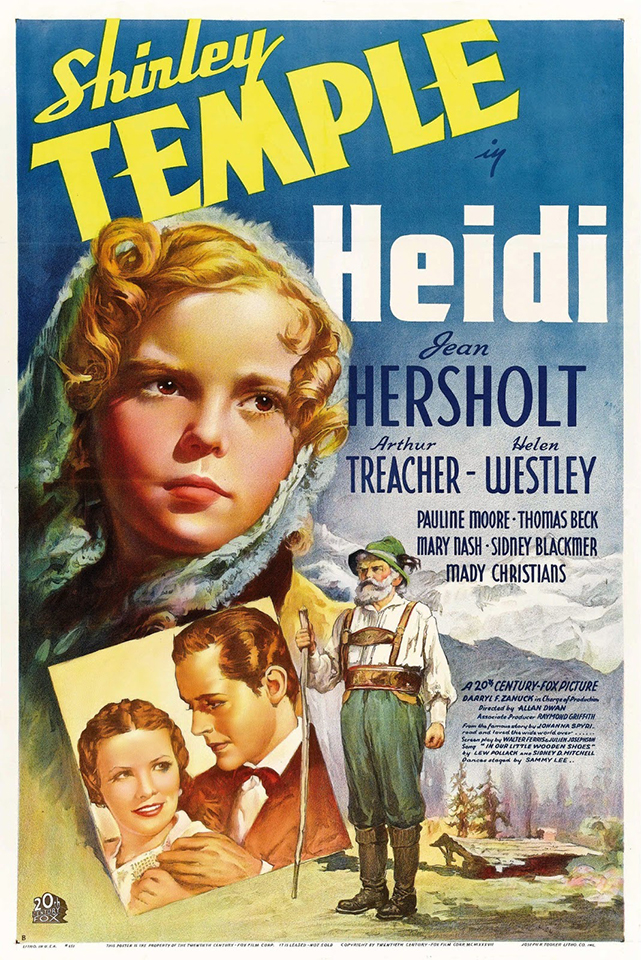 According to Variety, Heidi was chosen for Shirley by public demand, as expressed in her fan mail — although the showbiz bible may simply have been parroting a studio press release. Either way, the role was a natural for Shirley. The source was a novel by Johanna Spyri (1827-1901), first published in the author’s native Switzerland in 1880. The book was instantly popular, and promptly translated from its original German into virtually every written language on Earth. The book was — and remains — so popular, in fact, that it’s surprising to realize that Shirley’s picture in 1937 was the first attempt to make a movie out of it (there have been over a dozen since).
According to Variety, Heidi was chosen for Shirley by public demand, as expressed in her fan mail — although the showbiz bible may simply have been parroting a studio press release. Either way, the role was a natural for Shirley. The source was a novel by Johanna Spyri (1827-1901), first published in the author’s native Switzerland in 1880. The book was instantly popular, and promptly translated from its original German into virtually every written language on Earth. The book was — and remains — so popular, in fact, that it’s surprising to realize that Shirley’s picture in 1937 was the first attempt to make a movie out of it (there have been over a dozen since).
To direct Heidi, Darryl Zanuck first approached Henry King, and he was an excellent choice. King’s directing career began in 1915 (and would stretch on to 1962), and he was one of that select group of directors who mastered moviemaking in the silent era, then adapted easily to the changing times when sound came in. By 1937, at Fox, he had already directed, among others, the first State Fair (’33) with Will Rogers and Janet Gaynor; Ramona (’36), Fox’s first Technicolor picture, from the Helen Hunt Jackson novel of old California; and Lloyds of London (also ’36), which made a star of Tyrone Power (who would work with King ten more times). Still to come were some of 20th Century Fox’s most important and successful pictures: Alexander’s Ragtime Band (’38), Jesse James (’39), The Song of Bernadette (’43), Wilson (’44), Twelve O’Clock High (’49), The Gunfighter (’50). King was the only director under contract to Fox who even approached the stature of John Ford (though King was a rather distant second at that), and if he had worked with Shirley it might have carried her farther along that fork in the road her career had taken with Wee Willie Winkie.
Alas, it was not to be. As King remembered it some 40 years later, he was on a busman’s holiday in Honolulu, doing prep work with the script for In Old Chicago, when he became stranded there by a steamship strike. Zanuck cabled him that In Old Chicago was being postponed and that he (Zanuck) wanted King to consider directing Heidi. “I immediately went to a bookstore in Honolulu, read it and didn’t think there was much of a movie in it. I don’t believe in fairies to begin with.”
Ferris and Josephson replaced all this pastoral cavorting with melodrama. Heidi doesn’t go home to her grandfather until the very end; before that the old man (Jean Hersholt) walks the 100 miles to Frankfurt in search of her, then stalks the city streets calling her name, sometimes missing her my mere seconds. Meanwhile, Fraulein Rottenmaier (Mary Nash) is upgraded (or downgraded) from a mere narrow-minded, stiff-necked stick-in-the-mud to a full-fledged villainess; she plots to keep Klara (Marcia Mae Jones) crippled and dependent in the hope that the girl’s father Herr Sesemann (Sidney Blackmer) will be moved to marry his “indispensable” housekeeper. When Heidi unwittingly thwarts Fraulein R. by teaching Klara to walk, the fraulein retaliates by — I am not making this up — trying to sell Heidi to a band of gypsies. Only the intervention of a cool-headed police captain clears the way for a happy ending back on Heidi’s mountain.
Heidi gets off to a promising start. The picture’s Lake Arrowhead
locations, combined with good special effects (probably the work
of Fred Sersen, Fox’s effects wizard) make a credible substitute for
Switzerland, and the early scenes of Heidi’s unquenchable good
cheer slowly charming her gruff, taciturn old grandfather — Shirley
once again winning over a crusty curmudgeon — are well-played
by Shirley and a nearly silent Hersholt. One particularly charming
touch is a lilting little melody that Heidi hums to herself as she
goes about her chores — and which the grandfather eventually
finds himself humming without even realizing it. So far the
movie has been absolutely faithful to the spirit — and
reasonably faithful to the letter — of Johanna Spyri’s
story.
This lasts precisely 19 minutes and 37 seconds.
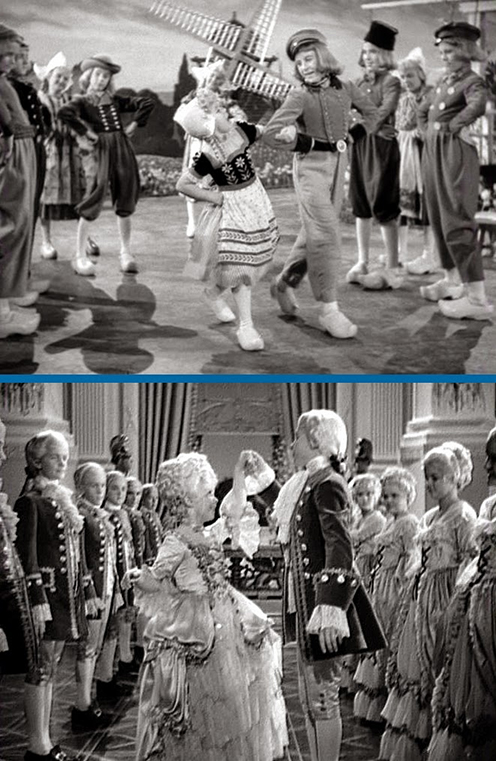 Then disaster strikes — incredibly enough, in the form of exactly the sort of thing Darryl Zanuck said he didn’t want in Wee Willie Winkie. As Heidi and her grandfather sit at their cabin table, he ostensibly begins reading her a story about “The Magic Wooden Shoes”. The camera moves in on a woodcut in the book, and the picture dissolves to a quaint little Dutch scene by a storybook Zuider Zee, and there’s Shirley — or is it Heidi? — in blonde braids and bangs and a starched cap, singing about her shoes:
Then disaster strikes — incredibly enough, in the form of exactly the sort of thing Darryl Zanuck said he didn’t want in Wee Willie Winkie. As Heidi and her grandfather sit at their cabin table, he ostensibly begins reading her a story about “The Magic Wooden Shoes”. The camera moves in on a woodcut in the book, and the picture dissolves to a quaint little Dutch scene by a storybook Zuider Zee, and there’s Shirley — or is it Heidi? — in blonde braids and bangs and a starched cap, singing about her shoes: There’s nothing really “wrong”, exactly, with all this, except for one thing: It doesn’t belong here. It has nothing to do with the life of a little girl in provincial Switzerland in 1880, but it has plenty to do with being Shirley Temple in 1937. This silly little number, coming when it does, wrecks Heidi beyond fixing. After this, we no longer believe we’re in Switzerland or, later, Frankfurt; we can’t possibly be anywhere but Hollywood. (The melodramatic blandishments of the script — selling Heidi to gypsies?? — and Dwan’s directing every scene at a headlong, breakneck pace, as if he has to be somewhere across town 15 minutes after calling cut, certainly don’t help.)
Shirley tells us that the number was inserted in the picture halfway through shooting. Whose bright idea was it? I blame Darryl Zanuck; nothing happened at his studio or went into his pictures that he didn’t know about and approve. What ever happened to “We don’t want to depend on any of her tricks” or “She should not be doing things because she is Shirley Temple, but because the situations — sound and believable — call for them“? I can only think — and this is pure speculation on my part — that Zanuck’s edicts in that story conference on Wee Willie Winkie were said simply to placate John Ford, as if Ford had said, “All right, Darryl, I’ll direct your Shirley Temple picture, but don’t try to saddle me with any of those cute little song-and-dance scenes; I won’t have it.” Maybe if Henry King had agreed to direct Heidi, those edicts would have stood. King might well have insisted, but not a director like Dwan.
At the time, Shirley enjoyed the number, enjoyed wearing those Dutch braids and bangs, enjoyed being flown on that invisible wire. In retrospect, writing in Child Star, she saw it as the turning point in her career. She called the “Wooden Shoes” number “a traditional Temple musical filler”, adding that “it marked the collapse of any studio resolve to build on the purely dramatic momentum first evident in Wee Willie Winkie.” With the same hindsight we can see that Shirley was right.
That’s in hindsight, however; no such thing was apparent at the time. In 1937, the picture was a major hit. Along with Wee Willie Winkie, Shirley’s only other picture that year, it kept her the number-one box office star, and Heidi became one of Shirley’s signature roles. Maybe even the signature role; to this day, it’s often the first picture mentioned when Shirley’s name comes up. Reviews were positive — better, in fact, than for Wee Willie Winkie. Variety’s “Char” called it “good for average Temple draw or better” (which it was), and said it “follows the original [novel] rather faithfully” (which it didn’t). In the Times, Frank S. Nugent was, for him, almost rhapsodic: “All of it has been framed handsomely in the snows of a Hollywood Switzerland, with a soft sepia (and blue) tinting to accentuate its dreamworld quality” (unlike Wee Willie Winkie, Heidi has not survived in that form). Nugent closed by admitting, “Shirley has scored another ‘coo.'”
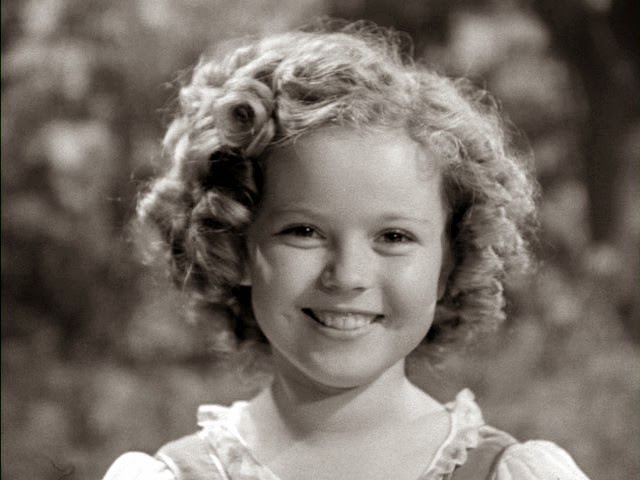 But looking back, we can see the handwriting on the wall. For me, seeing Heidi again for the first time in nearly 60 years was an eye-opening shock. I had remembered it as one of Shirley’s best-loved pictures. In fact, it always perplexed me that the 1952 Swiss version, which I saw about the same time, stayed fresher in my memory over the decades. Seeing Shirley’s again, I’m no longer perplexed. Heidi is no doubt one of her best-loved pictures, but it’s not one of her best. Despite those very good early scenes, and some later ones like the scene where the grandfather accompanies Heidi to the church that he hasn’t visited in years (straight out of Frau Spyri’s novel), the picture never recovers from the miscalculation of “In Our Little Wooden Shoes”; it’s one of the head-scratching what-on-Earth-were-they-thinking moments of 1930s Hollywood. What they were thinking, I suspect — or more to the point, what Darryl Zanuck was thinking — was that his dictum about writing the story as if it were a Little Women or David Copperfield, about writing for Shirley as an actress and not depending on any of her tricks, was no longer operative. Henceforth, as far as 20th Century Fox was concerned, Shirley’s tricks would be her stock in trade. The studio was no longer interested in Shirley becoming an actress; instead, they would keep her a baby taking a bow for as long as they could get away with it.
But looking back, we can see the handwriting on the wall. For me, seeing Heidi again for the first time in nearly 60 years was an eye-opening shock. I had remembered it as one of Shirley’s best-loved pictures. In fact, it always perplexed me that the 1952 Swiss version, which I saw about the same time, stayed fresher in my memory over the decades. Seeing Shirley’s again, I’m no longer perplexed. Heidi is no doubt one of her best-loved pictures, but it’s not one of her best. Despite those very good early scenes, and some later ones like the scene where the grandfather accompanies Heidi to the church that he hasn’t visited in years (straight out of Frau Spyri’s novel), the picture never recovers from the miscalculation of “In Our Little Wooden Shoes”; it’s one of the head-scratching what-on-Earth-were-they-thinking moments of 1930s Hollywood. What they were thinking, I suspect — or more to the point, what Darryl Zanuck was thinking — was that his dictum about writing the story as if it were a Little Women or David Copperfield, about writing for Shirley as an actress and not depending on any of her tricks, was no longer operative. Henceforth, as far as 20th Century Fox was concerned, Shirley’s tricks would be her stock in trade. The studio was no longer interested in Shirley becoming an actress; instead, they would keep her a baby taking a bow for as long as they could get away with it. To be continued…
Shirley Temple Revisited, Part 12
Despite the success of Wee Willie Winkie and Heidi, 20th Century Fox decided to table, for the time being at least, any literary pretensions in Shirley’s pictures. In Child Star Shirley says otherwise: “Ahead would be Fanchon the Cricket followed by Pollyanna…” — but nothing ever came of those, and she never mentions either title again, not even to explain why they didn’t happen. Both, not coincidentally, had been Mary Pickford vehicles in 1915 and 1920, respectively.
Fanchon, despite what Shirley says, was almost certainly never on the agenda. The 1849 George Sand novel on which it was based (La Petite Fadette) had no particular following in the U.S., and Pickford’s picture of it was long forgotten — presumed lost, in fact (a partial print didn’t surface until 1999). Besides, the character of a semi-feral peasant girl who wins the love of a respectable village boy in rural France was hardly a good fit for Shirley. Perhaps Mother Gertrude mentioned the title for (or to) Shirley, but Darryl Zanuck surely didn’t.
Pollyanna is another case entirely; why that one never happened is a mystery. The idea was a natural, more natural in fact than Heidi. For that matter, Eleanor H. Porter’s 1913 novel was virtually an American carbon copy of Heidi — without goats and mountains, with an aunt instead of a grandfather, and with Heidi and Klara, the crippled friend who learns to walk again, combined into the one character of Pollyanna Whittier. The story could easily have accommodated as many songs for Shirley as Zanuck and his minions cared to throw at it, and could even have been updated to the 1930s without doing serious damage to the original. Fox’s failure to follow this lead has to count as a major missed opportunity, maybe even (depending on the results, of course) a crime against posterity. Could the problem have been that the Porter novel was still under copyright? I suppose we’ll never know.
Shirley wrote about Zanuck “grappling with that chronic demon” of “selecting my next screenplay.” The grappling produced results — Shirley made three pictures in 1938 — but the results were, alas, generally undistinguished. Shirley described one of those pictures as “unfailingly bland”, but she could have been talking about any of the three, and we can deal with each of them in a very few paragraphs.
Rebecca of Sunnybrook Farm
(released March 25, 1938)
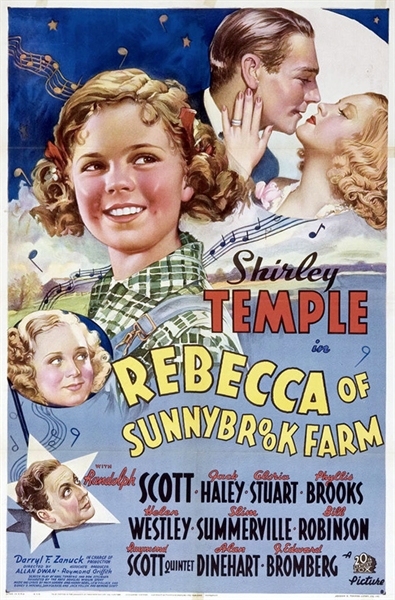 Rebecca of Sunnybrook Farm was another of Shirley’s “no trace” pictures, like Poor Little Rich Girl and (allegedly) The Littlest Rebel. What there was no trace of this time was the 1903 novel by Kate Douglas Wiggin. The story had been filmed faithfully in 1917 with Mary Pickford and again in 1932 with Marian Nixon (produced by Fox Film Corp., so the post-merger studio still had the property lying around). For this incarnation, the studio adopted the same curious practice they had used with Poor Little Rich Girl: take a title widely identified with Mary Pickford, then make a picture with absolutely no connection to what Pickford and Co. did with it.
Rebecca of Sunnybrook Farm was another of Shirley’s “no trace” pictures, like Poor Little Rich Girl and (allegedly) The Littlest Rebel. What there was no trace of this time was the 1903 novel by Kate Douglas Wiggin. The story had been filmed faithfully in 1917 with Mary Pickford and again in 1932 with Marian Nixon (produced by Fox Film Corp., so the post-merger studio still had the property lying around). For this incarnation, the studio adopted the same curious practice they had used with Poor Little Rich Girl: take a title widely identified with Mary Pickford, then make a picture with absolutely no connection to what Pickford and Co. did with it.
As if to ensure that Rebecca would be as familiar as possible, Zanuck and associate producer Raymond Griffith packed the supporting cast with returnees from Shirley’s earlier pictures: Gloria Stuart and Jack Haley from Poor Little Rich Girl; Helen Westley from Dimples, Stowaway and Heidi; Slim Summerville from Captain January; Bill Robinson from The Little Colonel and The Littlest Rebel; J. Edward Bromberg, the deus ex machina judge from Stowaway, serving the same function as a doctor this time; even Alan Dinehart, the sleazeball detective from way back in Baby Take a Bow, was brought back. Of the names on this poster, only Randolph Scott and Phyllis Brooks were new, and both would work with Shirley again before the year was out. The director, once again, was Heidi‘s reliably unimaginative Allan Dwan.
Even the story was a bit of a recycle; as in Poor Little Rich Girl, Shirley becomes a radio star unbeknownst to her ostensible guardian (duties divided this time between her grumpy aunt Helen Westley and shifty stepfather William Demarest) when, while living with her aunt on the farm of the title, she sneaks out for a remote broadcast from the farmhouse of her neighbor, radio producer Randolph Scott.
During that broadcast, Rebecca of Sunnybrook Farm drops all pretense to being anything more than Shirley Temple In Concert. The program’s emcee (Jack Haley) invites Shirley/Rebecca to “sing the songs that made a lot of people happy.” So she sings:
My dear radio audience,
Now I shall do
Some of the songs I’ve had the pleasure of introducing to you…
This, mind you, on what is supposedly her very first broadcast. What follows is a medley of “On the Good Ship Lollipop” from Bright Eyes, “Animal Crackers in My Soup” from Curly Top, “When I’m With You” and “Oh, My Goodness” from Poor Little Rich Girl and “Good Night, My Love” (the lyric changed to “Good Night, My Friends”) from Stowaway. “Ah, but it’s great to reminisce,” Shirley/Rebecca sighs.
Like Captain January, Rebecca of Sunnybrook Farm was one of Shirley’s first pictures to hit TV in the 1950s, so it has a special place in the childhood memories of many Baby Boomers. And giving credit where it’s due, Rebecca is a pleasant enough vehicle for Shirley. But it plows familiar ground while the original furrows are still fairly fresh. Those Baby Boomers (including myself) first saw Rebecca on its own, without the feeling of deja vu that comes from knowing about all the other movies it ransacks for actors, songs and plot elements.
“Flin” in Variety wasn’t fooled. He gave Shirley full credit as “a great little artist”, but added:
The rest is synthetic and disappointing. Why they named it “Rebecca of Sunnybrook Farm” is one of those mysteries. The only resemblance is a load of hay, a litter of pigs and Bill Robinson’s straw hat.
Little Miss Broadway
(released July 22, 1938)
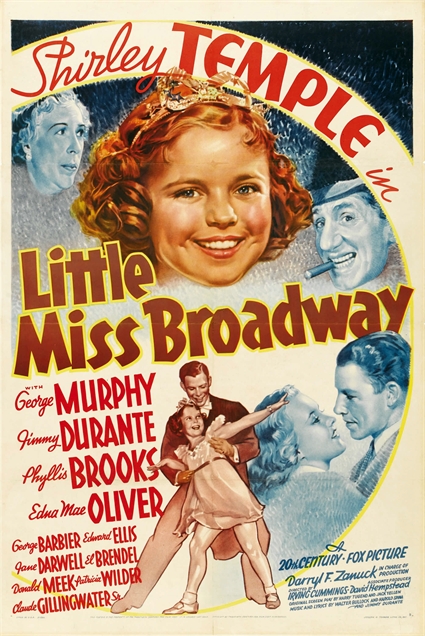 Little Miss Broadway was the one Shirley called “unfailingly bland”, and that about sums it up. Shirley is once again an orphan, this time moving from her orphanage to live with a friend of her late parents (Edward Ellis) who runs a hotel for entertainers. The curmudgeon this time is the rich old landlady next door (Edna May Oliver, her middle name misspelled as “Mae”), who not only plots to get rid of those unsavory show people by selling their hotel out from under them, but (channeling Sara Haden’s truant officer from Captain January) moves to have Shirley returned to her orphanage. Meanwhile, her playboy nephew (George Murphy) is charmed by Shirley and smitten with Ellis’s daughter (Phyllis Brooks of Rebecca of Sunnybrook Farm) and tries to thwart the old girl. It all ends in the courtroom of judge Claude Gillingwater, with Shirley and her troupers proving that they’ve got a moneymaking show on their hands and can afford to keep the hotel open.
Little Miss Broadway was the one Shirley called “unfailingly bland”, and that about sums it up. Shirley is once again an orphan, this time moving from her orphanage to live with a friend of her late parents (Edward Ellis) who runs a hotel for entertainers. The curmudgeon this time is the rich old landlady next door (Edna May Oliver, her middle name misspelled as “Mae”), who not only plots to get rid of those unsavory show people by selling their hotel out from under them, but (channeling Sara Haden’s truant officer from Captain January) moves to have Shirley returned to her orphanage. Meanwhile, her playboy nephew (George Murphy) is charmed by Shirley and smitten with Ellis’s daughter (Phyllis Brooks of Rebecca of Sunnybrook Farm) and tries to thwart the old girl. It all ends in the courtroom of judge Claude Gillingwater, with Shirley and her troupers proving that they’ve got a moneymaking show on their hands and can afford to keep the hotel open.In the New York Times, Frank S. Nugent was rather sympathetic: “The devastating Mistress Temple is slightly less devastating than usual in ‘Little Miss Broadway,’…Although she performs with her customary gayety [sic] and dimpled charm, there is no mistaking the effort every dimple cost her.” Variety’s “Flin” added: “Shirley is better than her new vehicle, which in turn is better than her last one, ‘Rebecca of Sunnybrook Farm.'” Whether Little Miss Broadway was really better than Shirley’s last vehicle is open to debate. But it was certainly better than her next one.
Just Around the Corner
(released December 2, 1938)
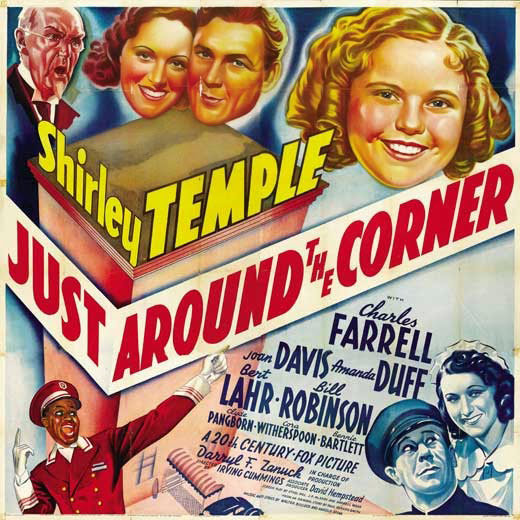 If Little Miss Broadway was an A-minus picture, Just Around the Corner was no more than a B-plus. If that. Shirley plays Penny Hale, who is taken out of private school when her widowed architect father (Charles Farrell) loses his job, and consequently the penthouse he and Penny have been living in, as well as the money to pay for her school. He’s now forced to work as the electrician in the apartment building where they formerly occupied the penthouse, and he and Penny must now make do with a tiny apartment in the basement.
If Little Miss Broadway was an A-minus picture, Just Around the Corner was no more than a B-plus. If that. Shirley plays Penny Hale, who is taken out of private school when her widowed architect father (Charles Farrell) loses his job, and consequently the penthouse he and Penny have been living in, as well as the money to pay for her school. He’s now forced to work as the electrician in the apartment building where they formerly occupied the penthouse, and he and Penny must now make do with a tiny apartment in the basement.
The penthouse now belongs to tycoon Samuel G. Henshaw (Claude Gillingwater again), the uncle of Penny’s new playmate Milton (Bennie Bartlett) and her father’s sweetheart Lola (Amanda Duff). This coincidence leads Penny to confuse the real man with the symbolic “Uncle Sam” — after all, he has the same white goatee — and to set about pulling him, her father and the country out of the economic doldrums by staging a benefit show at five cents admission.
Just Around the Corner, like Little Miss Broadway before it, was directed by Irving Cummings — the same man who had warned Mother Gertrude during Poor Little Rich Girl two years earlier that it was time for the studio to find better stories for Shirley, now that she had lost “that baby quality”. I doubt if this is what he had in mind. Shirley is ten now — or nine, depending on which version of her birth certificate people believed. In any case, she’s too old to be mistaking the “I Want You!” Uncle Sam for somebody’s real uncle who happens to go by that name. Conversely, she’s still too young to be spouting the lick-the-Depression pep talks that Warner Baxter once declaimed in Stand Up and Cheer!
Shirley remembered that her mother became alarmed at the trend of her recent pictures, not only the decreasing budgets, but the sameness of Shirley’s roles. As Shirley remembered it, her mother met with Zanuck and “expressed the opinion that recent scripts were forcing me into rigid, stereotyped roles inappropriate to my growth.” Zanuck countered that the public didn’t want their stars to change. “Now she’s lovable…The less she changes, the longer she lasts.”
The unsigned review in Variety was surprisingly positive (“topflight for general all-around entertainment”), but conceded, “Youngster is unquestionably getting more mature, and in growing older, Shirley seems to be under stress of acting rather than being natural.” At the Times, Frank Nugent was biting:
Fee-fi-fo-fum, and a couple of ho-hums. Shirley Temple is at the Roxy in “Just Around the Corner” and that’s where we’re lurking with a cleaver in one hand and a lollypop [sic] in the other…Shirley is not responsible, of course. No child could conceive so diabolic a form of torture. There must be an adult mind in back of it all — way, way in back of it all.
And we’ll leave the picture with those two swings of the critical pendulum.
Next time out, Shirley would be restored to the undeniable ranks of Fox’s A-pictures. No expense would be spared — including, for the first time since the final seconds of The Little Colonel, the use of Technicolor.
To be continued…
Shirley Temple Revisited, Part 13
In Child Star Shirley says that after the release of Little Miss Broadway Darryl Zanuck announced that her next picture would be an adaptation of Lady Jane by Mrs. Cecilia Viets Jamison. Published around the turn of the 20th century (1903, as near as I can tell), the novel told the Dickensian tale of an orphan girl in New Orleans of the 1890s. Little Jane and her gravely ill mother, having fallen on hard times, are taken in by a Mme. Jozain, who, seeing the fine clothes in their luggage, calculates that she’ll be well compensated for nursing the mother back to health. But the mother dies, leaving the girl in Mme. Jozain’s hands to be exploited and abused, her only friend a blue heron.
All ends happily, of course, but we needn’t go into it any deeper than that. In trolling around the Internet looking for information on the book — it’s apparently out of print, but used copies are widely available — I found this. It’s a 1935 edition published by Grosset & Dunlap, a firm that often published movie novelizations and “motion picture editions” of classic books. As you can see, the dust jacket says, “This is the beautiful story from which the 20th Century Fox picture was made”. However, Grosset & Dunlap seem to have jumped the gun; Lady Jane was never filmed, with Shirley or anybody else. Could it be that Fox purchased the book as early as 1935, anticipating making a movie, even though Shirley doesn’t mention it coming up until three years later?
In any case, nothing ever came of Lady Jane. Other titles were tossed in the hopper, including one suggested casually by U.S. Treasury Secretary Henry Morgenthau over lunch with Shirley and her mother: The Little Diplomat. On Zanuck’s orders, The Little Diplomat got as far as a treatment by studio writer Charles Beldon and a first draft by Eddie Moran, then withered on the vine. Another proposal, the 1936 children’s novel Susannah of the Mounties by Canadian Muriel Denison, went the distance, as we’ll see later. But for now, in the fall of 1938, Fox yet again turned to an old Mary Pickford vehicle. This time more than just the title would be used, and curiously enough, the story had some elements in common with Lady Jane. The result would be the glittering apotheosis of Shirley’s career at 20th Century Fox.
The Little Princess
(released March 10, 1939)
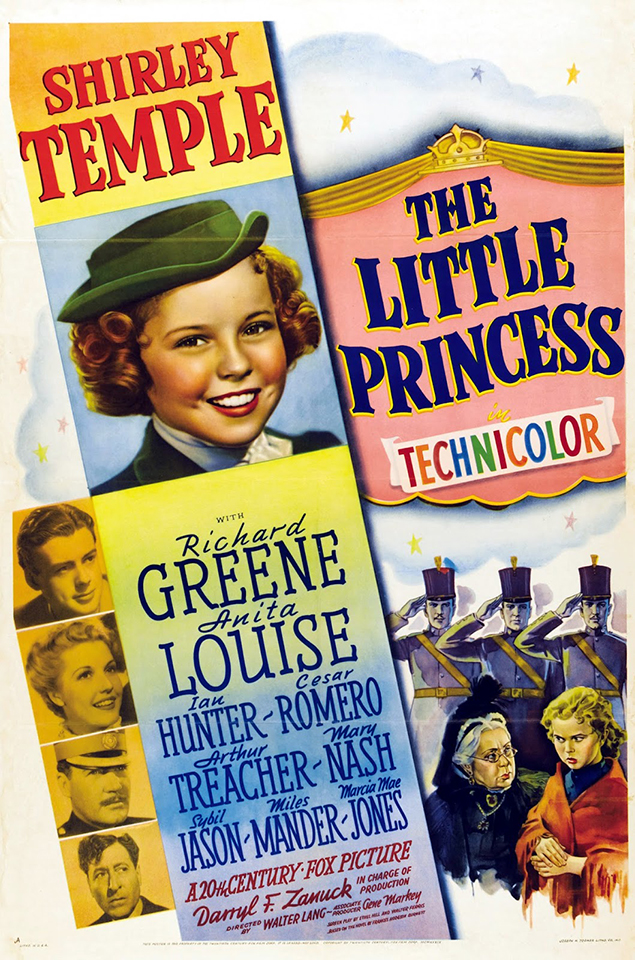 Unlike Lady Jane, A Little Princess has never been out of print since it was first published in 1905. It was the work of Frances Hodgson Burnett, who was born in England in 1849 but lived much of her adult life in the U.S., where she became a citizen in 1905, and where she died and was buried in 1924. She began writing short fiction for magazines while still in her teens, later progressing to romantic novels for adults and sentimental books for children. Her books sold well all her life, enabling her to support a transatlantic lifestyle with homes at various times in America, in England and on the Continent. Her adult novels were all popular in their day, but it’s for her children’s books that she remains best remembered, specifically Little Lord Fauntleroy (1885), The Secret Garden (1911) and A Little Princess.
Unlike Lady Jane, A Little Princess has never been out of print since it was first published in 1905. It was the work of Frances Hodgson Burnett, who was born in England in 1849 but lived much of her adult life in the U.S., where she became a citizen in 1905, and where she died and was buried in 1924. She began writing short fiction for magazines while still in her teens, later progressing to romantic novels for adults and sentimental books for children. Her books sold well all her life, enabling her to support a transatlantic lifestyle with homes at various times in America, in England and on the Continent. Her adult novels were all popular in their day, but it’s for her children’s books that she remains best remembered, specifically Little Lord Fauntleroy (1885), The Secret Garden (1911) and A Little Princess.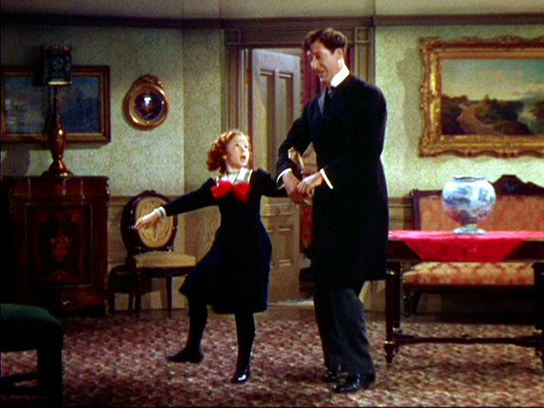
The dream fantasy is a pure Hollywood touch, but it works for the picture rather than crippling it, as “In Our Little Wooden Shoes” had done to Heidi. In Heidi, there was no way we could believe that this little Swiss urchin would fantasize herself as a Dutch girl clomping around by the Zuider Zee in her wooden shoes, much less promenading through a stately minuet at the Palace of Versailles. But the fantasy here is entirely in keeping with the Sara Crewe we’ve come to know; for that matter, it’s consistent with the novel’s original Sara Crewe as well. Before Sara’s fall from grace, everyone at the school calls her a “little princess” (some, the mean and spiteful ones, sarcastically); after her fall, it becomes even more important to Sara to be “a princess inside” and take whatever mistreatment Miss Minchin can fling at her with the grace and dignity that implies. So in her dream we see Sara as she sees herself, dispensing justice to the good and wicked alike. The scene also illustrates Sara’s greatest asset in adversity: her vivid imagination. (The “Ali Baba” sequence in the Mary Pickford version tried to do the same, but it went on more than twice as long — in a movie that was half an hour shorter — and bore no connection to Sara’s waking life.)
For Shirley’s next outing, it was back to black-and-white, and a follow-through on one of the projects that had been back-burnered in favor of The Little Princess.
Susannah of the Mounties
(released June 23, 1939)
We needn’t spend much time on Susannah of the Mounties. Muriel Denison’s novel, published in 1936, was the first of four she would eventually turn out; the sequels were Susannah of the Yukon, Susannah at Boarding School and Susannah Rides Again. This first book told of a nine-year-old Canadian girl in 1896 sent to live with her uncle when her parents are assigned to a remote corner of the British Empire. The uncle, an officer at a Royal Canadian Mounted Police outpost in the wilds of Saskatchewan, is at first surprised and unwelcoming, but Susannah soon wins his heart, along with those of everyone else on the post. My own copy of the book is still on order; when I’ve had a chance to look it over, if there’s anything more to be said about it, I’ll post an update here.
But I suspect there won’t be, because once again 20th Century Fox jettisoned everything except the title. The script was credited to Robert Ellis and Helen Logan (story by Fidel La Barba and Walter Ferris), but several other writers put their oars in without credit — never a good sign. Yet again, Shirley played an orphan: Susannah Sheldon, sole survivor of a wagon train massacred by renegade Blackfeet Indians in the 1880s. She is found by Mountie Randolph Scott out on patrol, and more or less adopted by him. From her place on the post she becomes embroiled in tensions between the Canadian Pacific Railroad and the Blackfeet tribe, especially after she befriends the son of a Blackfeet chief sent to the post as a hostage against good behavior. Together Susannah and Little Chief (played by a 13-year-old Blackfeet youth named Martin Good Rider) intervene with his father Big Eagle (Maurice Moscovich) to thwart the warmongering of the villainous Wolf Pelt (Victor Jory) and “show White Man and Indian how to live as brothers.” Peace pipe smoked, fade out.
That’s about it. There’s a perfunctory romance between Susannah’s guardian Inspector Angus “Monty” Montague (Scott) and his commanding officer’s daughter (Margaret Lockwood) that falls somewhere between the similar subplot of Wee Willie Winkie and the one of The Little Princess; otherwise Susannah of the Mounties has the mediocre look and feel of a B-western (albeit spiced up with stock footage from earlier, more expensive Fox westerns). There’s also an attitude toward Canada’s native tribes that’s almost as uncomfortable today as the treatment of African Americans in The Little Colonel and The Littlest Rebel. “Ugh!” is a common line of dialogue given to Blackfeet characters; other lines include “Little Chief not sleep White Man house,” and, so help me, “Devil child have forked tongue!”
Reviews were dismissive, with an air of disappointment, as if the reviewers’ hopes had been raised by The Little Princess, only to be dashed. Variety called Susannah “weakest in the Temple series for some time”, adding, ominously: “Youngster is growing up fast, and is losing some of that sparkle displayed as a tot which carried her so far as a b.o. bet.” B.R. Crisler in the Times, noting the movie’s Mounties in their pillbox hats instead of the familiar peaked campaign hats, cracked: “The early Canadian Northwest Mounted Police certainly wore tricky uniforms, though. Except for the fact that they are on the screen, people at the Roxy might almost mistake them for ushers.” The New Yorker’s John Mosher put it succinctly, and correctly: “The whole offering must be considered as very minor Temple.”
Susannah of the Mounties was directed by Wiliam A. Seiter, one of Shirley’s favorites, who had already directed her in Stowaway and Dimples. Some scenes were directed without credit by Walter Lang (Seiter had performed the same fill-in duty on The Little Princess when director Lang left on “medical furlough”). Shirley’s next picture would reunite her with Lang. Once again, Shirley and Lang would be working in Technicolor, and the production would be, if anything, even more lavish than The Little Princess. Results, however, would differ sharply. For the first time, a Shirley Temple picture would lose money.
To be concluded…
Shirley Temple Revisited, Part 14
 And so we come to the endgame of the Shirley Temple Phenomenon. It’s the summer of 1939; Shirley is 11 years old — though she and the rest of the world still think she’s only ten — and she’s bumping up against a principle that won’t even be articulated until 1997: what critic Louis Menand called “The Iron Law of Stardom”. In a New Yorker article by that title published in March ’97, Menand posited his “Iron Law” as one of the immutable laws of the universe, like gravity or the speed of light. Put simply, the Iron Law is this: stardom never lasts more than three years. Menand was careful, however, to distinguish between “stardom” and “being a star”. Once a star, always a star, he said, but actual stardom is something else — “the period of inevitability, the time when everything works in a way that makes you think it will work that way forever…the intersection of personality with history, a perfect congruence of the way the world happens to be and the way the star is.” Thus, Menand explained, Elizabeth Taylor remained a star all her life by virtue of being the person who was Elizabeth Taylor from 1963 (Cleopatra) to 1966 (Who’s Afraid of Virginia Woolf?), and Al Pacino remains a star as the person who was Al Pacino from 1972 (The Godfather) to 1975 (Dog Day Afternoon).
And so we come to the endgame of the Shirley Temple Phenomenon. It’s the summer of 1939; Shirley is 11 years old — though she and the rest of the world still think she’s only ten — and she’s bumping up against a principle that won’t even be articulated until 1997: what critic Louis Menand called “The Iron Law of Stardom”. In a New Yorker article by that title published in March ’97, Menand posited his “Iron Law” as one of the immutable laws of the universe, like gravity or the speed of light. Put simply, the Iron Law is this: stardom never lasts more than three years. Menand was careful, however, to distinguish between “stardom” and “being a star”. Once a star, always a star, he said, but actual stardom is something else — “the period of inevitability, the time when everything works in a way that makes you think it will work that way forever…the intersection of personality with history, a perfect congruence of the way the world happens to be and the way the star is.” Thus, Menand explained, Elizabeth Taylor remained a star all her life by virtue of being the person who was Elizabeth Taylor from 1963 (Cleopatra) to 1966 (Who’s Afraid of Virginia Woolf?), and Al Pacino remains a star as the person who was Al Pacino from 1972 (The Godfather) to 1975 (Dog Day Afternoon).By this reasoning, and with hindsight, we can see that Shirley in 1939 fits the pattern. She remains a star, but it’s by virtue of being the person who was Shirley Temple from 1934 (Little Miss Marker and Bright Eyes) to 1937 (Wee Willie Winkie and Heidi). Nineteen-forty will round out not only the decade, but her reign atop the box office and her career at 20th Century Fox as well.
The Blue Bird
(released January 19, 1940)
 The Blue Bird was Shirley’s second brush with a Nobel Prize winner, after Rudyard Kipling and Wee Willie Winkie. Belgian poet, essayist and playwright Maurice Maeterlinck (1862-1949) was a leading proponent of the Symbolist movement in European art and literature of the late 19th century. His most influential and commercially successful play was probably Pelleas and Melisande (1893), a doomed-lovers tragedy that inspired numerous operas, all of which are performed these days far more often than the original play.
The Blue Bird was Shirley’s second brush with a Nobel Prize winner, after Rudyard Kipling and Wee Willie Winkie. Belgian poet, essayist and playwright Maurice Maeterlinck (1862-1949) was a leading proponent of the Symbolist movement in European art and literature of the late 19th century. His most influential and commercially successful play was probably Pelleas and Melisande (1893), a doomed-lovers tragedy that inspired numerous operas, all of which are performed these days far more often than the original play.
A close second to that, however, would have to be The Blue Bird, which was an immediate hit when it premiered at Konstantin Stanislavski’s Moscow Art Theatre in 1908. When Maeterlinck won the Nobel Prize in 1911 “in appreciation of his many-sided literary activities, and especially of his dramatic works,” the citation explicitly mentioned “a poetic fancy, which reveals, sometimes in the guise of a fairy tale, a deep inspiration”. This could only have been a reference to The Blue Bird, which was then sweeping the world and would have been prominent in the minds of the Swedish Academy (in those days, commercial success was not considered a disadvantage when Nobel Prize time rolled around).
The Blue Bird recounts the many adventures of the boy Tyltyl (“til-til”) and his little sister Mytyl (“mee-til”), the children of a poor woodcutter somewhere in Central Europe. One night the children are roused from sleep by a bent and withered old woman who, changing shape, is revealed as a beautiful fairy named Berylune. The fairy dispatches the two on a quest to find the Blue Bird of Happiness, in which they are to be accompanied by their dog and cat, both of whom are magically given human shape for the occasion. Also accompanying them, and also in human form, are the spirits of Bread, Water, Milk, Fire and Light. The children’s search takes them to many fanciful places — the palace of Berylune, which once belonged to the infamous Bluebeard; the Palace of Night, deep underground; the Graveyard of the Happy Dead, where they are briefly reunited with their late grandparents and seven brothers and sisters who all died in childhood; the Palace of Happiness, where luxuries and joys abound; and the Kingdom of the Future, where they meet children waiting to be born, all of whom have a knowledge of their destiny that they will lose once they begin their earthly lives (Tyltyl and Mytyl even meet their own future little brother, who already knows that he too will die in infancy). In the final scene Tyltyl and Mytyl awaken back in their own beds; their parents think they have only slept through the night, but the children know better — how could both have had the same dream? Whether dream or magic, their quest has failed, they never did find the elusive bird they sought. Then, to their surprise, they see that the Blue Bird is right there in their own house, and was there all along. At the very end the bird flies away, and Tyltyl turns to the audience and says, “If any of you should find him, would you be so very kind as to give him back to us?…We need him for our happiness, later on….”
My memory of Maeterlinck’s play is unfortunately sketchy; it’s been more than 40 years since I read it, and I wouldn’t read it again if you held a gun to my brother’s head. I found it to be long, turgid and utterly pointless, and it calls for spectacular effects that might have been wonderful to look at but make awfully dry reading (given the state of stagecraft in 1908, Stanislavski’s set designers, carpenters and stage managers must have been tearing their hair as opening night drew near). The play was a great success in the first and second decades of the last century, no doubt because the fantastic effects it calls for made for quite a wondrous spectacle to behold. But after that first flush of success and the afterglow of the Nobel Prize, its charm quickly evaporated.
The reason isn’t hard to figure out. Despite its elaborate settings and special effects, and characters symbolic of everything under the sun, The Blue Bird simply has no story. Why do Tyltyl and Mytyl undertake this convoluted journey? Why don’t they just tell the old hag to get lost, then roll over and go back to sleep? The kids have nothing at stake in this quest; they’re just gallivanting around in Maeterlinck’s head. In The Wizard of Oz — to cite an example that will come up more than once in the course of this post — what Dorothy and her companions are after is crystal-clear, and there’s never any doubt what’s at stake. That’s why The Blue Bird hasn’t been staged in 90 years, and is never even read except under duress by hapless students in university drama classes — while L. Frank Baum’s tale still sells thousands of copies every year.
With all that said, 20th Century Fox’s 1940 version of The Blue Bird has been given a bum rap over the years. The main thrust of the rap is that The Blue Bird was Fox’s attempt to duplicate the success of MGM’s The Wizard of Oz (this has also fed the myth that Shirley “lost” the role of Dorothy). It would be closer to the truth to say that both pictures were attempts to duplicate the success of Walt Disney’s Snow White and the Seven Dwarfs. (In which, by the way, both failed. The Blue Bird, in Time Magazine’s inevitable snark line, “laid an egg”, but Oz didn’t do much better, either with the critics or at the box office; it was voted “Most Colossal Flop” of 1939 by the Harvard Lampoon, and it took 16 years and two reissues for the picture to turn a profit.)
Now let’s stipulate right up front that The Blue Bird is nowhere near the same league as The Wizard of Oz — but what movie is? Of all the many differences between them, the most basic one, and the one that most redounds to the advantage of The Wizard of Oz, is that MGM was adapting L. Frank Baum while 20th Century Fox was adapting Maurice Maeterlinck.
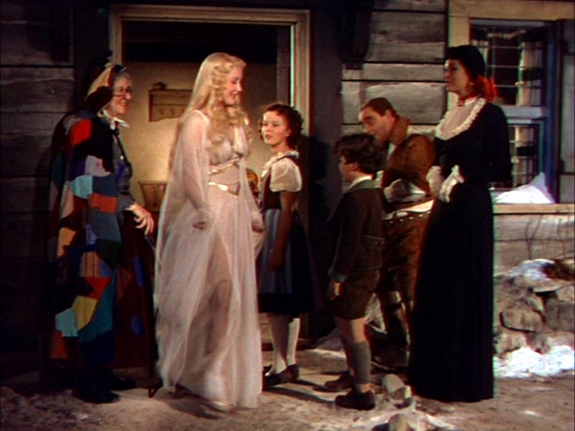 Or trying to. The Blue Bird‘s greatest faults are inherent in Maeterlinck’s play; this was one case where Fox might have been justified in jettisoning everything but the title. Instead, Ernest Pascal’s script made an honest effort (with moderate success) to streamline, simplify and motivate the wild excesses of Maeterlinck’s fantasy. First, merely as a practical matter, the birth order of the lead siblings was reversed, making Mytyl (Shirley) the older and Tyltyl (Johnny Russell) the younger. The size of their expedition was streamlined, with their only companions being the cat Tylette (Gale Sondergaard, right) and dog Tylo (Eddie Collins, next to her). Of Maeterlinck’s five spirits, only Light remained (played by Helen Ericson), and she served, logically enough, as the children’s guide on their quest. (The group is shown here as they set out, with Jessie Ralph as Berylune on the left.)
Or trying to. The Blue Bird‘s greatest faults are inherent in Maeterlinck’s play; this was one case where Fox might have been justified in jettisoning everything but the title. Instead, Ernest Pascal’s script made an honest effort (with moderate success) to streamline, simplify and motivate the wild excesses of Maeterlinck’s fantasy. First, merely as a practical matter, the birth order of the lead siblings was reversed, making Mytyl (Shirley) the older and Tyltyl (Johnny Russell) the younger. The size of their expedition was streamlined, with their only companions being the cat Tylette (Gale Sondergaard, right) and dog Tylo (Eddie Collins, next to her). Of Maeterlinck’s five spirits, only Light remained (played by Helen Ericson), and she served, logically enough, as the children’s guide on their quest. (The group is shown here as they set out, with Jessie Ralph as Berylune on the left.)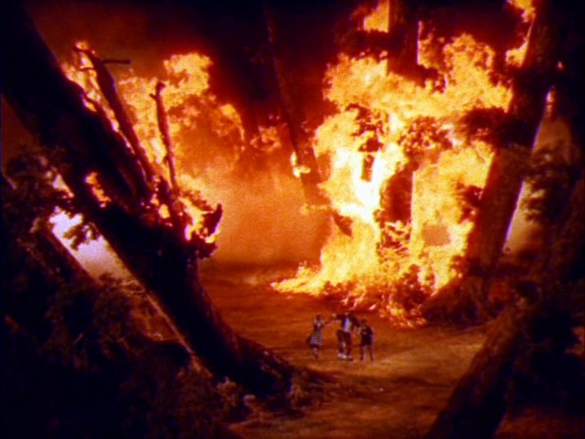 There follows another departure from Maeterlinck. After they escape from The Luxurys, the children must pass through a great forest. Tylette, hoping to rid herself of the children and thus gain her freedom, runs ahead of them and incites the trees (represented by Edwin Maxwell, Sterling Holloway and others) to avenge themselves on the children of the woodcutter who is always chopping them down. The trees take the bait, even calling on their old enemies lightning and fire — so eager are they to destroy the children that they willingly immolate themselves in a great forest fire. Tylette, however, has outsmarted herself; trying to lure the children to their doom, she is herself burned to death, and only the courageous efforts of the loyal Tylo enables the children to escape to safety.
There follows another departure from Maeterlinck. After they escape from The Luxurys, the children must pass through a great forest. Tylette, hoping to rid herself of the children and thus gain her freedom, runs ahead of them and incites the trees (represented by Edwin Maxwell, Sterling Holloway and others) to avenge themselves on the children of the woodcutter who is always chopping them down. The trees take the bait, even calling on their old enemies lightning and fire — so eager are they to destroy the children that they willingly immolate themselves in a great forest fire. Tylette, however, has outsmarted herself; trying to lure the children to their doom, she is herself burned to death, and only the courageous efforts of the loyal Tylo enables the children to escape to safety. 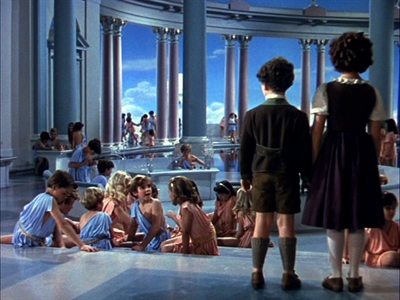 …the Kingdom of the Future, where (returning to Maeterlinck’s text) Mytyl and Tyltyl find countless children are waiting to be born. In this remarkable scene, which looks like something designed by Maxfield Parrish, Mytyl and Tyltyl wander among the eager throng, so amazed at what they see that they completely forget to look for the Blue Bird. They meet a little girl who joyfully greets them by name (Ann Todd, not to be confused with the British actress of the same name), telling them that she will be their little sister, “in a year perhaps.” Then she adds sadly, “I’ll only be with you a little while.” Mytyl and Tyltyl wander among children who are preparing for what will be their calling in life. One boy proudly displays the anesthetic he will discover; another tinkers with an electric light. Still another, solitary and melancholy, tells them his destiny is to fight against slavery, injustice and inequality — but people “won’t listen…they’ll destroy me.”
…the Kingdom of the Future, where (returning to Maeterlinck’s text) Mytyl and Tyltyl find countless children are waiting to be born. In this remarkable scene, which looks like something designed by Maxfield Parrish, Mytyl and Tyltyl wander among the eager throng, so amazed at what they see that they completely forget to look for the Blue Bird. They meet a little girl who joyfully greets them by name (Ann Todd, not to be confused with the British actress of the same name), telling them that she will be their little sister, “in a year perhaps.” Then she adds sadly, “I’ll only be with you a little while.” Mytyl and Tyltyl wander among children who are preparing for what will be their calling in life. One boy proudly displays the anesthetic he will discover; another tinkers with an electric light. Still another, solitary and melancholy, tells them his destiny is to fight against slavery, injustice and inequality — but people “won’t listen…they’ll destroy me.”
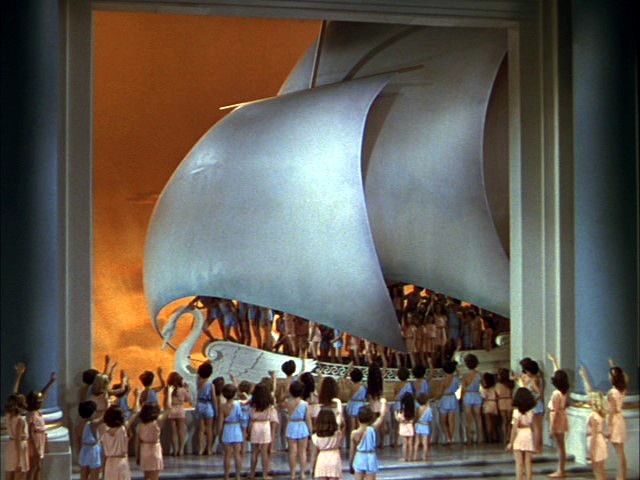 The children whose time has come board a graceful alabaster ship with silver sails and the figurehead of a swan. As the boat pulls away from the quay into a golden sea and sky, the children left behind, still awaiting their turn, bid their friends a joyous bon voyage. The departing passengers fix their eyes on the far horizon, and they sing:
The children whose time has come board a graceful alabaster ship with silver sails and the figurehead of a swan. As the boat pulls away from the quay into a golden sea and sky, the children left behind, still awaiting their turn, bid their friends a joyous bon voyage. The departing passengers fix their eyes on the far horizon, and they sing:To the world so far away
Sail we now at break of day.
Mothers waiting there below.
Do they hear us? Do they know?
From the unseen distance another song can be heard — the song of the mothers coming out to meet them.
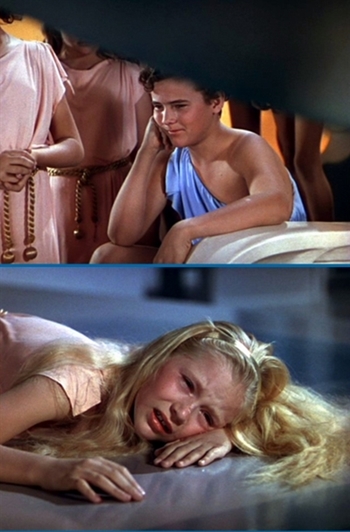

This lovely and poignant scene in the Kingdom of the Future — straight out of Maetterlinck, but massaged by Ernest Pascal to make it less cumbersome and archly precious than it reads in the original play — is the last stop on Mytyl and Tyltyl’s journey; having visited the Future, and still not finding the Blue Bird, there’s nothing left for them but to return home.
The Blue Bird was the most expensive of all Shirley’s pictures — $1.5 million, she tells us — and it took a terrible bath at the box office, both in its original road-show engagements in New York, Detroit and San Francisco, and after going into general release at Easter. This was not, as legend would have it, because it suffered by comparison with The Wizard of Oz, but simply because The Blue Bird‘s time had long since passed. Even the 1918 silent version, lavishly produced within a decade of the play’s premiere, was a flop. (The curse repeated itself yet again in 1976, when a U.S./Soviet co-production directed by George Cukor sank like a rock. Some people never learn.)
The idea that The Blue Bird suffered by comparison with The Wizard of Oz in 1940 basically springs from the fact that it suffers by that same comparison today. Almost everyone who sees The Blue Bird nowadays can’t help seeing similarities to Oz, and of course Blue Bird can only be found wanting. There is, for starters, the black-and-white prologue, with the switch to Technicolor when the real adventure begins (although The Blue Bird never returns to black-and-white; in keeping with Mytyl’s improved outlook, the Technicolor stays to the end). Also, there’s the premise of the fantasy/dream and the look-for-happiness-in-your-own-back-yard moral. Which is ironic, considering that those elements are not found in L. Frank Baum but were swiped by Noel Langley, Florence Ryerson and Edgar Allan Woolf from Maeterlinck’s play and grafted onto their script for Oz (where they did not belong). In a real sense, MGM’s Wizard of Oz was an imitation of The Blue Bird, and not the other way around.
If viewers today were as familiar with Maeterlinck’s dreadful play as they are with Oz, The Blue Bird‘s virtues would stand out more clearly. Ernest Pascal greatly improved on the original, tightening and focusing the diffuse and rambling story, and adding two elements lacking in the play: a villain (Tylette the cat) to scheme against the children, and a champion (Tylo the dog) to come to their aid in times of danger. For all his improvements, however, Pascal never solved the dramatic problem at the heart of this fatally flawed play: there is simply no reason for Mytyl and Tyltyl to undertake this dangerous quest, and no clear reward at journey’s end to justify it. It was a shaggy-dog fairy tale when Maeterlinck wrote it, and a shaggy-dog fairy tale it remained in 1940 — and remains to this day.
The play’s reputation had lost its luster by the time Darryl Zanuck and 20th Century Fox undertook to film it, and the movie’s reviews reflected the fact. In the Times, Frank S. Nugent confessed to having “long considered ‘The Blue Bird’ complete twaddle”, an opinion which the movie did nothing to dispel: “it has about the gayety [sic] and sparkle of the first half of ‘A Christmas Carol'”. Variety’s “Flin” wrote: “Whatever freshness and imaginative charm the Maurice Maeterlinck poem play possessed a generation ago seem to have tarnished through the years…Not even Shirley Temple, in a gallery of sparkling technicolor [sic] settings, and aided by all the wizardry of the finest technical workmanship, can make it seem new.” (To be fair, Shirley didn’t have much chance. Her performance is strong, but dominated by the story rather than dominating it; as written by both Maeterlinck and Pascal, Mytyl is as much a spectator to The Blue Bird‘s goings-on as we are.) Flin correctly cited the scene in the Kingdom of the Future as “the best and perhaps complete justification for the production…However trite some other passages of ‘The Blue Bird’ seem to be, this episode is touching and fine eerie storytelling.” And in The New Yorker, John Mosher said, “All in all, I should rank ‘The Blue Bird,’ with its pretty moments and its lapses, too, somewhere halfway between the Disneys and ‘The Wizard of Oz.'” (Notice that Oz, which an earlier New Yorker review had called “a stinkeroo”, is at the bottom of Mosher’s scale.)
The opinion of The Blue Bird that would be most interesting to hear, alas, I have been unable to find: that of Maurice Maeterlinck himself. Maeterlinck landed in the U.S. later in 1940, a refugee from the Nazis storming across France and his native Belgium, and he remained here until 1947, when he returned to his home in Nice (he died at 86 in 1949). He may well have seen The Blue Bird somewhere along the line, but what he thought remains unknown. In Child Star Shirley quotes Darryl Zanuck as saying only that the playwright was consulted on the script, and that he objected to the cutting of so many of his characters, but more than that I cannot say.
Whatever Maeterlinck might have thought, The Blue Bird was a sincere effort, exerted with all the resources at 20th Century Fox’s command, and it holds up today on the strength of its production values — and, it must be said, despite the deadly weaknesses of the source material. It holds up, that is, if — and it’s a big “if” — one can watch it without making invidious comparisons with The Wizard of Oz.
But whatever I or anyone else may think today, in 1940 The Blue Bird utterly failed to find its audience — as the silent version had done in 1918, and as another version would do 36 years later. Its failure was probably Maeterlinck’s fault more than Shirley’s, but hers was the more familiar name, and the stain of the flop stuck to her. The next time out, things would not get better.
Young People
(released August 23, 1940)
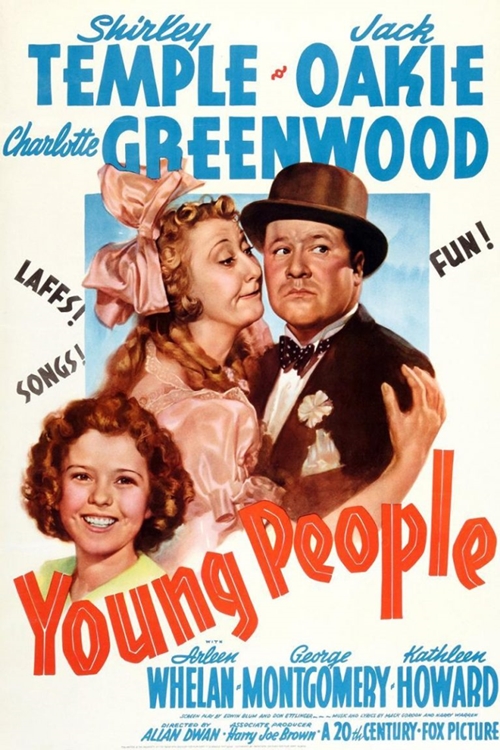
As Fox had followed the lavish The Little Princess by placing Shirley in a B-western, so they followed the even more lavish The Blue Bird with an even-more-B musical. But more significantly, perhaps, by the time Young People opened in New York in August — in fact, even before Variety reviewed it in July — the picture was already a lame-duck movie. Fox chairman Joseph Schenck had announced on May 12, 1940 that the studio was “releasing” (i.e., “firing”) Shirley from the remaining 13 months of her seven-year contract. The effort of crafting vehicles for a growing child star — and of dealing with Gertrude and George Temple’s increasing objections to the unvarying parade of orphan and waif roles — had become more trouble than the diminishing box-office returns were worth. So Young People would be Shirley’s swan song at 20th Century Fox. The Blue Bird might at least have ended her career with a bang; Young People was a whimper.
Shirley’s co-stars were Jack Oakie and Charlotte Greenwood as Joe and Kit Ballantine, a husband-and-wife vaudeville team who informally adopt the infant daughter of their best friends, the O’Haras, when both parents succumb to untimely deaths.
The infant grows into Wendy (Shirley) and is incorporated into the act, now called The Three Ballantines. As Wendy approaches adolescence, Joe and Kit decide to retire from show business to a little farm they’ve bought in Connecticut, where Wendy can enjoy a “normal” life. But their brash showbiz manners scandalize the staid provincial citizens of their new home and the Ballantines become outcasts and objects of local ridicule, to the point where they are driven out of town in frustrated disgrace.
In the end, a fortuitous hurricane makes landfall near the town, Joe becomes a hero by rescuing a group of children caught out in the storm, and a tearful scolding by Wendy of the town’s leading citizens and the Ballantines’ chief tormentors (Kathleen Howard and Minor Watson) brings these bigoted small-town snobs to their senses, and the Ballantines are belatedly welcomed by their new neighbors with open arms.
In Child Star Shirley says Edwin Blum and Don Ettlinger’s script for Young People “made cheerless reading”, and it makes even more cheerless viewing. The new songs by Harry Warren and Mack Gordon (still three years from their Oscars for “You’ll Never Know” in Hello, Frisco, Hello) are lackluster, and the movie has a half-hearted romantic subplot for Arleen Whelan and George Montgomery that makes one long for the scintillating screen chemistry of June Lang and Michael Whalen in Wee Willie Winkie.
In early scenes, Young People illustrates Wendy’s start in Joe and Kit’s act by tipping in, clumsily, footage from Shirley’s “old” movies. First Jack Oakie and Charlotte Greenwood sing a chorus of Henry Kailikai’s “On the Beach at Waikiki”, followed by an extended shot of Shirley’s hula dance from Curly Top. Then, most egregiously, Oakie and Greenwood perpetrate a crass and stupid trashing of Brown and Gorney’s “Baby, Take a Bow” before the movie cuts to Shirley’s solo of the song from Stand Up and Cheer! “The film’s value,” Shirley accurately writes, “amounted to less than the sum of its parts.” Shirley deserved better, and so did Jack Oakie and Charlotte Greenwood. Hell, George Montgomery deserved better. Ironically, Young People was directed at his usual headlong pace by Allan Dwan, who years later would assert that Shirley was “over” before he undertook to direct her in Heidi. Shirley was by no means “over” in 1937, but by 1940 (and her third picture for Dwan), she certainly was.
Reviews were surprisingly indulgent — perhaps betraying a certain degree of relief that there would be no more Shirley Temple pictures for the foreseeable future. “Walt” in Variety wrote: “‘Young People’ establishes the definite spot for continuance of Shirley Temple in pictures through her adolescent and formative years. Not as a star, burdened with carrying a picture on her own, but in the groove of a featured player sharing billing and material with other top-notch artists…an above average programmer…” The Times’s Bosley Crowther added, “If this is really the end, it is not a bad exit at all for little Shirley, the superannuated sunbeam.” Even The New Yorker’s John Mosher, who rightly pegged Susannah of the Mounties as “very minor Temple”, said, “Miss Temple has obviously retired in the full tide of her powers…she shows no weariness, no slacking up, no arthritic pangs.”
If these valedictory tributes were intended even subliminally to soften the blow and let Shirley go out a winner, it didn’t work. Young People, even with its shoestrings-and-stock-footage budget, was a flop. Shirley was no longer tops at the box office — she had dropped to fifth in 1939, and by 1940 was out of the top ten — and Frank Nugent finally got the wish he expressed in his review of Wee Willie Winkie: Shirley would be a has-been at 15.
* * *
On top of that, Shirley’s first meeting with producer Arthur Freed had not gone well. Shirley says (and frankly, I believe her) that Freed said, “I have something made just for you. You’ll be my new star!”, then stepped out from behind his desk and exposed himself to her. Shirley reacted like the 12-year-old she was, bursting into a nervous laugh that didn’t sit well with the notorious casting-couch jockey, and he angrily ordered her out of his office. At almost the same moment (again, I believe Shirley), L.B. Mayer was in his office coming on to an affronted Mother Gertrude — stopping short of exhibitionism but making his intentions plain. Perhaps coincidentally, Shirley’s contract was quickly redrafted: only one picture, with no approval or creative input from Shirley or her mother.
The sole result of Shirley’s sojourn at MGM was Kathleen (’41), a “tedious, thinly plotted fable” (Variety) where, according to the Times’s Theodore Strauss, “In those wistful, winsome close-ups Miss Temple seemed to be trying to say just one thing: ‘Get me out of here!'” In any event, that’s exactly what happened.
Next, Shirley went under contract to David O. Selznick, which worked out better for her, although her days of stardom were behind her. Throughout the 1940s she would give some effective performances — Since You Went Away (’44), Kiss and Tell (’45), The Bachelor and the Bobby-Soxer (’47) — but Shirley was slow to learn that what had made her “sparkle” as a five-and-six-year-old could look infantile and affected in a young woman of 18 or 19. An ill-starred marriage at 17 to Army Air Corps Sgt. John Agar (who parlayed the connection into a long but inconsequential career in B movies) ended in 1950 — outlasting Shirley’s movie career by one year (her last picture was A Kiss for Corliss in 1949).
Shirley did, in time, get the hang of grown-up acting, as the host and occasional star of Shirley Temple’s Storybook and Shirley Temple Theatre (NBC, 1958-60), giving intelligent and measured performances in “The House of the Seven Gables”, “The Land of Oz”, “The Legend of Sleepy Hollow” and other episodes. (I remember as a child being unable to connect this adult Shirley to the curly-haired little girl in those old movies that were turning up on TV about the same time.) But by then acting was more a hobby than a calling, and when the show ran its course in two season she left it as she had left Hollywood in 1949, with never a backward glance. Ahead lay a third career — or fourth, if you count wife to Charles Black and mother to their two children, plus a daughter by John Agar — in politics and international diplomacy. And let us not forget her courageous battle with breast cancer in the 1970s, becoming one of the first celebrities to go public with her experience in that brush with death. All in all, the second half of the 20th century took her far from the tot who stood security for her movie-father’s bet on a fixed horse race and flew off on the wings of the Good Ship Lollipop. She had the grace and poise to take her long life as it came, and to make the most of it.
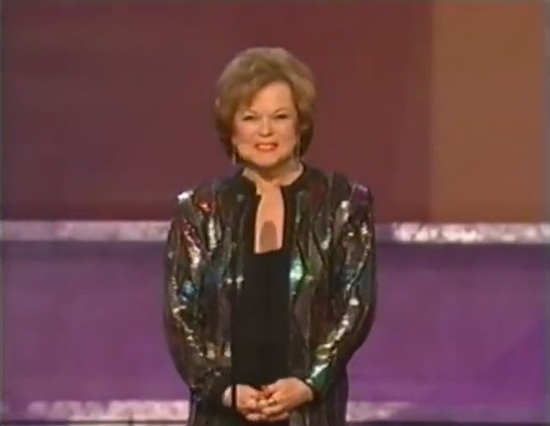
…However, the video still exists on YouTube. Since I am no longer able to embed YouTube videos in my posts — I still don’t know why, and I suppose I never will — I’m linking to it instead. You can see Shirley’s acceptance of the SAG award here. Skip forward to the 9:36 mark to see Jamie Lee Curtis’s introduction and Shirley’s thank-you speech.]
This was the woman who left us on February 10 of this year; long live her memory. She changed forever what it means to be a child star — mainly because, as critic Mark Steyn aptly put it, she wasn’t a “child star” at all. She was a star who just happened to be a child.
Epilogue
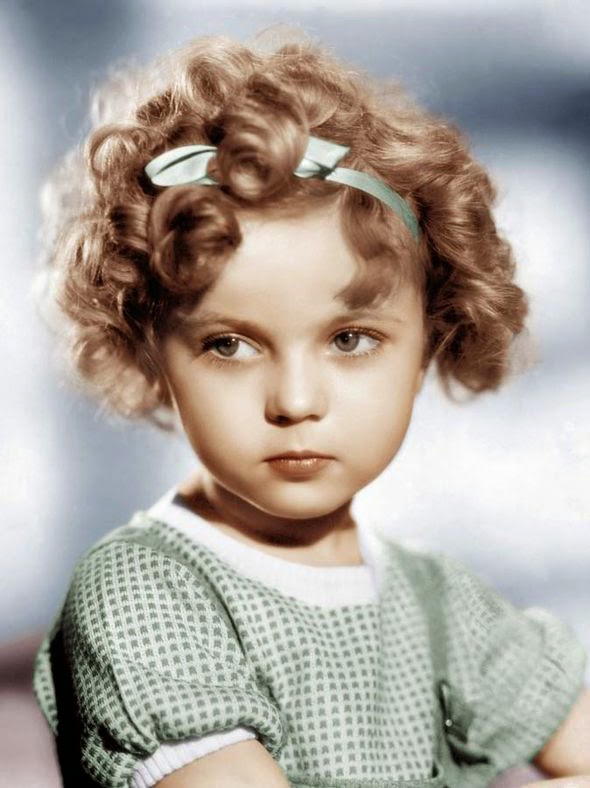 So there you have it, Shirley Temple’s entire career as a rising star and reigning princess during Hollywood’s Golden Age. As I said at the very beginning, while I had nothing but fond memories of Shirley, I had not seen any of these 24 pictures since I was about the age Shirley was when she made them. Several of them I had never seen at all. Seeing them — again or for the first time — was like a trip in a time machine with two stops: one at Shirley’s childhood, and another at my own.
So there you have it, Shirley Temple’s entire career as a rising star and reigning princess during Hollywood’s Golden Age. As I said at the very beginning, while I had nothing but fond memories of Shirley, I had not seen any of these 24 pictures since I was about the age Shirley was when she made them. Several of them I had never seen at all. Seeing them — again or for the first time — was like a trip in a time machine with two stops: one at Shirley’s childhood, and another at my own.
Standouts? Well, the first one that comes to mind is…
